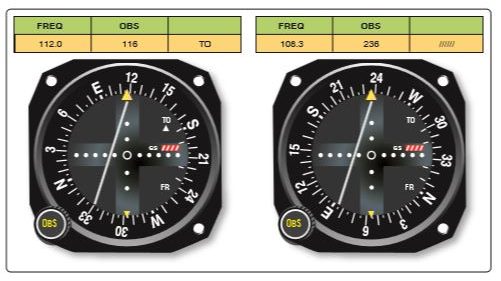ifr all
Quiz Summary
0 of 922 questions completed
Questions:
Information
You have already completed the quiz before. Hence you can not start it again.
Quiz is loading…
You must sign in or sign up to start the quiz.
You must first complete the following:
Results
Results
0 of 922 questions answered correctly
Your time:
Time has elapsed
You have reached 0 of 0 point(s), (0)
Earned Point(s): 0 of 0, (0)
0 Essay(s) Pending (Possible Point(s): 0)
Categories
- Not categorized 0%
- 1
- 2
- 3
- 4
- 5
- 6
- 7
- 8
- 9
- 10
- 11
- 12
- 13
- 14
- 15
- 16
- 17
- 18
- 19
- 20
- 21
- 22
- 23
- 24
- 25
- 26
- 27
- 28
- 29
- 30
- 31
- 32
- 33
- 34
- 35
- 36
- 37
- 38
- 39
- 40
- 41
- 42
- 43
- 44
- 45
- 46
- 47
- 48
- 49
- 50
- 51
- 52
- 53
- 54
- 55
- 56
- 57
- 58
- 59
- 60
- 61
- 62
- 63
- 64
- 65
- 66
- 67
- 68
- 69
- 70
- 71
- 72
- 73
- 74
- 75
- 76
- 77
- 78
- 79
- 80
- 81
- 82
- 83
- 84
- 85
- 86
- 87
- 88
- 89
- 90
- 91
- 92
- 93
- 94
- 95
- 96
- 97
- 98
- 99
- 100
- 101
- 102
- 103
- 104
- 105
- 106
- 107
- 108
- 109
- 110
- 111
- 112
- 113
- 114
- 115
- 116
- 117
- 118
- 119
- 120
- 121
- 122
- 123
- 124
- 125
- 126
- 127
- 128
- 129
- 130
- 131
- 132
- 133
- 134
- 135
- 136
- 137
- 138
- 139
- 140
- 141
- 142
- 143
- 144
- 145
- 146
- 147
- 148
- 149
- 150
- 151
- 152
- 153
- 154
- 155
- 156
- 157
- 158
- 159
- 160
- 161
- 162
- 163
- 164
- 165
- 166
- 167
- 168
- 169
- 170
- 171
- 172
- 173
- 174
- 175
- 176
- 177
- 178
- 179
- 180
- 181
- 182
- 183
- 184
- 185
- 186
- 187
- 188
- 189
- 190
- 191
- 192
- 193
- 194
- 195
- 196
- 197
- 198
- 199
- 200
- 201
- 202
- 203
- 204
- 205
- 206
- 207
- 208
- 209
- 210
- 211
- 212
- 213
- 214
- 215
- 216
- 217
- 218
- 219
- 220
- 221
- 222
- 223
- 224
- 225
- 226
- 227
- 228
- 229
- 230
- 231
- 232
- 233
- 234
- 235
- 236
- 237
- 238
- 239
- 240
- 241
- 242
- 243
- 244
- 245
- 246
- 247
- 248
- 249
- 250
- 251
- 252
- 253
- 254
- 255
- 256
- 257
- 258
- 259
- 260
- 261
- 262
- 263
- 264
- 265
- 266
- 267
- 268
- 269
- 270
- 271
- 272
- 273
- 274
- 275
- 276
- 277
- 278
- 279
- 280
- 281
- 282
- 283
- 284
- 285
- 286
- 287
- 288
- 289
- 290
- 291
- 292
- 293
- 294
- 295
- 296
- 297
- 298
- 299
- 300
- 301
- 302
- 303
- 304
- 305
- 306
- 307
- 308
- 309
- 310
- 311
- 312
- 313
- 314
- 315
- 316
- 317
- 318
- 319
- 320
- 321
- 322
- 323
- 324
- 325
- 326
- 327
- 328
- 329
- 330
- 331
- 332
- 333
- 334
- 335
- 336
- 337
- 338
- 339
- 340
- 341
- 342
- 343
- 344
- 345
- 346
- 347
- 348
- 349
- 350
- 351
- 352
- 353
- 354
- 355
- 356
- 357
- 358
- 359
- 360
- 361
- 362
- 363
- 364
- 365
- 366
- 367
- 368
- 369
- 370
- 371
- 372
- 373
- 374
- 375
- 376
- 377
- 378
- 379
- 380
- 381
- 382
- 383
- 384
- 385
- 386
- 387
- 388
- 389
- 390
- 391
- 392
- 393
- 394
- 395
- 396
- 397
- 398
- 399
- 400
- 401
- 402
- 403
- 404
- 405
- 406
- 407
- 408
- 409
- 410
- 411
- 412
- 413
- 414
- 415
- 416
- 417
- 418
- 419
- 420
- 421
- 422
- 423
- 424
- 425
- 426
- 427
- 428
- 429
- 430
- 431
- 432
- 433
- 434
- 435
- 436
- 437
- 438
- 439
- 440
- 441
- 442
- 443
- 444
- 445
- 446
- 447
- 448
- 449
- 450
- 451
- 452
- 453
- 454
- 455
- 456
- 457
- 458
- 459
- 460
- 461
- 462
- 463
- 464
- 465
- 466
- 467
- 468
- 469
- 470
- 471
- 472
- 473
- 474
- 475
- 476
- 477
- 478
- 479
- 480
- 481
- 482
- 483
- 484
- 485
- 486
- 487
- 488
- 489
- 490
- 491
- 492
- 493
- 494
- 495
- 496
- 497
- 498
- 499
- 500
- 501
- 502
- 503
- 504
- 505
- 506
- 507
- 508
- 509
- 510
- 511
- 512
- 513
- 514
- 515
- 516
- 517
- 518
- 519
- 520
- 521
- 522
- 523
- 524
- 525
- 526
- 527
- 528
- 529
- 530
- 531
- 532
- 533
- 534
- 535
- 536
- 537
- 538
- 539
- 540
- 541
- 542
- 543
- 544
- 545
- 546
- 547
- 548
- 549
- 550
- 551
- 552
- 553
- 554
- 555
- 556
- 557
- 558
- 559
- 560
- 561
- 562
- 563
- 564
- 565
- 566
- 567
- 568
- 569
- 570
- 571
- 572
- 573
- 574
- 575
- 576
- 577
- 578
- 579
- 580
- 581
- 582
- 583
- 584
- 585
- 586
- 587
- 588
- 589
- 590
- 591
- 592
- 593
- 594
- 595
- 596
- 597
- 598
- 599
- 600
- 601
- 602
- 603
- 604
- 605
- 606
- 607
- 608
- 609
- 610
- 611
- 612
- 613
- 614
- 615
- 616
- 617
- 618
- 619
- 620
- 621
- 622
- 623
- 624
- 625
- 626
- 627
- 628
- 629
- 630
- 631
- 632
- 633
- 634
- 635
- 636
- 637
- 638
- 639
- 640
- 641
- 642
- 643
- 644
- 645
- 646
- 647
- 648
- 649
- 650
- 651
- 652
- 653
- 654
- 655
- 656
- 657
- 658
- 659
- 660
- 661
- 662
- 663
- 664
- 665
- 666
- 667
- 668
- 669
- 670
- 671
- 672
- 673
- 674
- 675
- 676
- 677
- 678
- 679
- 680
- 681
- 682
- 683
- 684
- 685
- 686
- 687
- 688
- 689
- 690
- 691
- 692
- 693
- 694
- 695
- 696
- 697
- 698
- 699
- 700
- 701
- 702
- 703
- 704
- 705
- 706
- 707
- 708
- 709
- 710
- 711
- 712
- 713
- 714
- 715
- 716
- 717
- 718
- 719
- 720
- 721
- 722
- 723
- 724
- 725
- 726
- 727
- 728
- 729
- 730
- 731
- 732
- 733
- 734
- 735
- 736
- 737
- 738
- 739
- 740
- 741
- 742
- 743
- 744
- 745
- 746
- 747
- 748
- 749
- 750
- 751
- 752
- 753
- 754
- 755
- 756
- 757
- 758
- 759
- 760
- 761
- 762
- 763
- 764
- 765
- 766
- 767
- 768
- 769
- 770
- 771
- 772
- 773
- 774
- 775
- 776
- 777
- 778
- 779
- 780
- 781
- 782
- 783
- 784
- 785
- 786
- 787
- 788
- 789
- 790
- 791
- 792
- 793
- 794
- 795
- 796
- 797
- 798
- 799
- 800
- 801
- 802
- 803
- 804
- 805
- 806
- 807
- 808
- 809
- 810
- 811
- 812
- 813
- 814
- 815
- 816
- 817
- 818
- 819
- 820
- 821
- 822
- 823
- 824
- 825
- 826
- 827
- 828
- 829
- 830
- 831
- 832
- 833
- 834
- 835
- 836
- 837
- 838
- 839
- 840
- 841
- 842
- 843
- 844
- 845
- 846
- 847
- 848
- 849
- 850
- 851
- 852
- 853
- 854
- 855
- 856
- 857
- 858
- 859
- 860
- 861
- 862
- 863
- 864
- 865
- 866
- 867
- 868
- 869
- 870
- 871
- 872
- 873
- 874
- 875
- 876
- 877
- 878
- 879
- 880
- 881
- 882
- 883
- 884
- 885
- 886
- 887
- 888
- 889
- 890
- 891
- 892
- 893
- 894
- 895
- 896
- 897
- 898
- 899
- 900
- 901
- 902
- 903
- 904
- 905
- 906
- 907
- 908
- 909
- 910
- 911
- 912
- 913
- 914
- 915
- 916
- 917
- 918
- 919
- 920
- 921
- 922
- Current
- Review
- Answered
- Incorrect
-
Question 1 of 922
1. Question
On the taxi check, the magnetic compass should
CorrectIncorrect -
Question 2 of 922
2. Question
What should be the indication on the magnetic compass as you roll into a standard-rate turn to the left from an east heading in the Northern Hemisphere?
CorrectIncorrect -
Question 3 of 922
3. Question
What should be the indication on the magnetic compass as you roll into a standard-rate turn to the right from an easterly heading in the Northern Hemisphere?
CorrectIncorrect -
Question 4 of 922
4. Question
What should be the indication on the magnetic compass as you roll into a standard-rate turn to the right from a westerly heading in the Northern Hemisphere?
CorrectIncorrect -
Question 5 of 922
5. Question
What should be the indication on the magnetic compass as you roll into a standard rate turn to the right from a south heading in the Northern Hemisphere?
CorrectIncorrect -
Question 6 of 922
6. Question
On what headings will the magnetic compass read most accurately during a level 360-degree turn, with a bank of approximately 15 degrees?
CorrectIncorrect -
Question 7 of 922
7. Question
What causes the northerly turning error in a magnetic compass?
CorrectIncorrect -
Question 8 of 922
8. Question
What should be the indication on the magnetic compass as you roll into a standard-rate turn to the left from a south heading in the Northern Hemisphere?
CorrectIncorrect -
Question 9 of 922
9. Question
What should be the indication on the magnetic compass as you roll into a standard-rate turn to the right from a northerly heading in the Northern Hemisphere?
CorrectIncorrect -
Question 10 of 922
10. Question
What should be the indication on the magnetic compass as you roll into a standard-rate turn to the left from a west heading in the Northern Hemisphere?
CorrectIncorrect -
Question 11 of 922
11. Question
What should be the indication on the magnetic compass as you roll into a standard-rate turn to the left from a north heading in the Northern Hemisphere?
CorrectIncorrect -
Question 12 of 922
12. Question
If both the ram air input and the drain hole of the pilot system are blocked, what reaction should you observe on the airspeed indicator when power is applied and a climb is initiated out of severe icing conditions?
CorrectIncorrect -
Question 13 of 922
13. Question
If, while in level flight, it becomes necessary to use an alternate source of static pressure vented inside the airplane, which of the following variations in instrument indications should the pilot expect?
CorrectIncorrect -
Question 14 of 922
14. Question
Refer to figure 144 below. What changes in control displacement should be made so that “2” would result in a coordinated standard-rate turn?
 CorrectIncorrect
CorrectIncorrect -
Question 15 of 922
15. Question
Refer to figure 144 below. Which illustration indicates a coordinated turn?
 CorrectIncorrect
CorrectIncorrect -
Question 16 of 922
16. Question
Refer to figure 144 below. What changes in control displacement should be made so that “1” would result in a coordinated standard rate turn?
 CorrectIncorrect
CorrectIncorrect -
Question 17 of 922
17. Question
Refer to figure 144 below. Which illustration indicates a skidding turn?
 CorrectIncorrect
CorrectIncorrect -
Question 18 of 922
18. Question
Refer to figure 144 below. Which illustration indicates a slipping turn?
 CorrectIncorrect
CorrectIncorrect -
Question 19 of 922
19. Question
What force causes an airplane to turn?
CorrectIncorrect -
Question 20 of 922
20. Question
The rate of turn at any airspeed is dependent upon
CorrectIncorrect -
Question 21 of 922
21. Question
What is the relationship between centrifugal force and the horizontal life component in a coordinated turn?
CorrectIncorrect -
Question 22 of 922
22. Question
The primary reason the angle of attack must be increased, to maintain a constant altitude during a coordinated turn, is because the
CorrectIncorrect -
Question 23 of 922
23. Question
During a skidding turn to the right, what is the relationship between the component of lift, centrifugal force, and load factor?
CorrectIncorrect -
Question 24 of 922
24. Question
When airspeed is increased in a turn, what must be done to maintain a constant altitude?
CorrectIncorrect -
Question 25 of 922
25. Question
When airspeed is decreased ina turn, which must be done to maintain level flight?
CorrectIncorrect -
Question 26 of 922
26. Question
When airspeed is decreased in a turn, what must be done to maintain level flight?
CorrectIncorrect -
Question 27 of 922
27. Question
The primary reason the pitch attitude must be increased, to maintain a constant altitude during a coordinated turn, is because the
CorrectIncorrect -
Question 28 of 922
28. Question
If a standard-rate turn is maintained, how much time would be required to turn to the left from a heading of 090 degrees to a heading of 300 degrees?
CorrectIncorrect -
Question 29 of 922
29. Question
If a half-standard-rate turn is maintained, how long would it take to turn 135 degrees?
CorrectIncorrect -
Question 30 of 922
30. Question
If a half-standard-rate turn is maintained, how long would it take to turn 360 degrees?
CorrectIncorrect -
Question 31 of 922
31. Question
If a standard-rate turn is maintained, how long would it take to turn 180 degrees?
CorrectIncorrect -
Question 32 of 922
32. Question
If a half-standard-rate turn is maintained, how much time would be required to turn clockwise from a heading of 090 degrees to a heading of 180 degrees?
CorrectIncorrect -
Question 33 of 922
33. Question
During a constant-bank level turn, what effect would an increase in airspeed have on the rate and radius of turn?
CorrectIncorrect -
Question 34 of 922
34. Question
Rate of turn can be increased and radius of turn decreased by
CorrectIncorrect -
Question 35 of 922
35. Question
If a standard-rate turn is maintained, how much time would be required to turn to the right from a heading of 090 degrees to a heading of 270 degrees?
CorrectIncorrect -
Question 36 of 922
36. Question
Approximately what percent of the indicated vertical speed should be used to determine the number of feet to lead the level-off from a climb to a specific altitude?
CorrectIncorrect -
Question 37 of 922
37. Question
Conditions that determine pitch attitude required to maintain level flight are:
CorrectIncorrect -
Question 38 of 922
38. Question
To level off from a descent to a specific altitude, the pilot should lead the level-off by approximately
CorrectIncorrect -
Question 39 of 922
39. Question
As a rule of thumb, altitude corrections of less than 100 feet should be corrected by using
CorrectIncorrect -
Question 40 of 922
40. Question
Which instruments should be used to make a pitch correction when you have deviated from your assigned altitude?
CorrectIncorrect -
Question 41 of 922
41. Question
As a rule of thumb, altitude corrections of less than 100 feet should be corrected by using a
CorrectIncorrect -
Question 42 of 922
42. Question
To enter a constant-airspeed descent from level-cruising flight, and maintain cruising airspeed, the pitch should
CorrectIncorrect -
Question 43 of 922
43. Question
To level off at an airspeed higher than the constant speed, the addition of power should be made, assuming a 500 FPM rate of descent, at approximately
CorrectIncorrect -
Question 44 of 922
44. Question
To level off from a descent maintaining the descending airspeed, the pilot should lead the desired altitude by approximately
CorrectIncorrect -
Question 45 of 922
45. Question
While cruising at 160 knots, you wish to establish a climb of 130 knots. When entering the climb (full panel), it is proper to make the initial pitch change by increasing back elevator pressure until the
CorrectIncorrect -
Question 46 of 922
46. Question
While cruising at 190 knots, you wish to establish a climb of 160 knots. When entering the climb (full panel), it would be proper to make the initial pitch change by increasing back elevator pressure until the
CorrectIncorrect -
Question 47 of 922
47. Question
What is the third fundamental skill in attitude instrument flying?
CorrectIncorrect -
Question 48 of 922
48. Question
What is the first fundamental skill in attitude instrument flying?
CorrectIncorrect -
Question 49 of 922
49. Question
What are the three fundamental skills involved in attitude instrument flying?
CorrectIncorrect -
Question 50 of 922
50. Question
What is the correct sequence in which to use the three skills used in instrument flying?
CorrectIncorrect -
Question 51 of 922
51. Question
Which instruments, in addition to the attitude indicator, are pitch instruments?
CorrectIncorrect -
Question 52 of 922
52. Question
For maintaining level flight at constant thrust, which instrument would be the least appropriate for determining the need for a pitch change?
CorrectIncorrect -
Question 53 of 922
53. Question
Which instrument indicates the quality of a turn?
CorrectIncorrect -
Question 54 of 922
54. Question
While recovering from an unusual flight attitude without the aid of the attitude indicator, approximate level pitch attitude is reached when the
CorrectIncorrect -
Question 55 of 922
55. Question
If an airplane is in an unusual flight attitude and the attitude indicator has exceeded its limits, which instruments should be relied on to determine pitch attitude
CorrectIncorrect -
Question 56 of 922
56. Question
Which is the correct sequence for recovery time from a spiraling nose-low, increasing airspeed, unusual flight attitude?
CorrectIncorrect -
Question 57 of 922
57. Question
During recoveries from unusual attitudes, level flight is attained the instant
CorrectIncorrect -
Question 58 of 922
58. Question
Refer to figure 145 below. What is the correct sequence for recovery from the unusual attitude indicated?
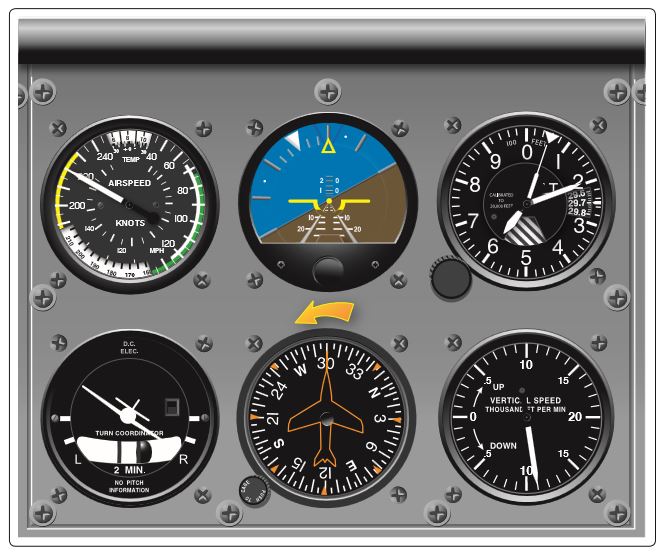 CorrectIncorrect
CorrectIncorrect -
Question 59 of 922
59. Question
Refer to figure 147 below. Which is the correct sequence for recovery from the unusual attitude indicated?
 CorrectIncorrect
CorrectIncorrect -
Question 60 of 922
60. Question
Refer to figure 146 below. Identify the system that has failed and determine a corrective action to return the airplane to straight-and-level flight.
 CorrectIncorrect
CorrectIncorrect -
Question 61 of 922
61. Question
Refer to figure 148 below. What is the flight attitude? One system which transmits information to the instruments has malfunctioned

 CorrectIncorrect
CorrectIncorrect -
Question 62 of 922
62. Question
Refer to figure 149 below. What is the flight attitude? One system which transmits information to the instruments has malfunctioned.
 CorrectIncorrect
CorrectIncorrect -
Question 63 of 922
63. Question
Refer to figure 150 below. What is the flight attitude? One instrument has malfunctioned.

 CorrectIncorrect
CorrectIncorrect -
Question 64 of 922
64. Question
Refer to figure 151 below. What is the flight attitude? One instrument has malfunctioned.
 CorrectIncorrect
CorrectIncorrect -
Question 65 of 922
65. Question
If you fly into severe turbulence, which flight condition should you attempt to maintain?
CorrectIncorrect -
Question 66 of 922
66. Question
If severe turbulence is encountered during your IFR flight, the airplane should be slowed to the design maneuvering speed because the
CorrectIncorrect -
Question 67 of 922
67. Question
When a climb or descent through an inversion of wind-shear zone is being performed, the pilot should be alert for which of the following change in airplane performance?
CorrectIncorrect -
Question 68 of 922
68. Question
What is the best method of speed reduction if hydroplaning is experienced on landing?
CorrectIncorrect -
Question 69 of 922
69. Question
Which term describes the hydroplaning which occurs when an airplane’s tire is effectively held off a smooth runway surface by steam generated by friction?
CorrectIncorrect -
Question 70 of 922
70. Question
What is the best method of speed reduction if hydroplaning is experienced on landing?
CorrectIncorrect -
Question 71 of 922
71. Question
What effect, if any, will landing at a higher-than-recommended touchdown speed have on hydroplaning?
CorrectIncorrect -
Question 72 of 922
72. Question
Under which conditions is hydroplaning most likely to occur?
CorrectIncorrect -
Question 73 of 922
73. Question
Which distance is displayed by the DME indicator?
CorrectIncorrect -
Question 74 of 922
74. Question
Which DME indication should you receive when you are directly over a VORTAC site at approximately 6,000 feet AGL?
CorrectIncorrect -
Question 75 of 922
75. Question
The greatest DME indication error between actual ground distance and displayed ground distance occurs at
CorrectIncorrect -
Question 76 of 922
76. Question
As a rule of thumb, to minimize DME select range error, how far from the facility should you be to consider the reading as accurate?
CorrectIncorrect -
Question 77 of 922
77. Question
To find the VOR receiver ground checkpoint(s) for an accuracy check, which publication should you consult?
CorrectIncorrect -
Question 78 of 922
78. Question
When flying directly over a published airborne VOR checkpoint, what is the maximum error allowed for IFR flight?
CorrectIncorrect -
Question 79 of 922
79. Question
When using VOT to make a VOR receiver check, the CDI should be centered and the OBS should indicate that the aircraft is on the
CorrectIncorrect -
Question 80 of 922
80. Question
When making an airborne VOR check, what is the maximum allowable tolerance between the two indicators of a dual VOR system (units independent of each other except the antenna)?
CorrectIncorrect -
Question 81 of 922
81. Question
When the CDI needle is centered during an airborne VOR check, the omni-bearing selector and the TO/FROM indicator should read
CorrectIncorrect -
Question 82 of 922
82. Question
Refer to figure 81 below. When checking a dual VOR system by use of a VOT, which illustration indicates the VOR’s are satisfactory?
 CorrectIncorrect
CorrectIncorrect -
Question 83 of 922
83. Question
While airborne, what is the maximum permissible variation between the two indicated bearings when checking one VOR system against the other?
CorrectIncorrect -
Question 84 of 922
84. Question
Refer to figure 82 below. Which is an acceptable range of accuracy when performing an operational check of dual VORs using one system against the other.
 CorrectIncorrect
CorrectIncorrect -
Question 85 of 922
85. Question
How should the pilot make a VOR receiver check when the aircraft is located on the designated checkpoint on the airport surface?
CorrectIncorrect -
Question 86 of 922
86. Question
Where can the VOT frequency for a particular airport be found?
CorrectIncorrect -
Question 87 of 922
87. Question
Which indications are acceptable tolerances when checking both VOR receivers by use of the VOT?
CorrectIncorrect -
Question 88 of 922
88. Question
What indication should a pilot receive when a VOR station is undergoing maintenance and may be considered unreliable?
CorrectIncorrect -
Question 89 of 922
89. Question
A particular VOR station is undergoing routine maintenance. This is evidenced by
CorrectIncorrect -
Question 90 of 922
90. Question
When a VOR/DME is collocated under frequency pairings and the VOR portion is inoperative, the DME identifier will repeat at an interval of
CorrectIncorrect -
Question 91 of 922
91. Question
What is the meaning of a single coded identification received only once approximately every 30 seconds from a VORTAC?
CorrectIncorrect -
Question 92 of 922
92. Question
For operations off established airways at 17,000 feet MSL in the contiguous U.S., (H) Class VORTAC facilities used to define a direct route of flight should be no farther apart than
CorrectIncorrect -
Question 93 of 922
93. Question
You are planning an IFR flight off established airways below 18,000 feet MSL. If you use VOR navigation to define the route, the maximum distance between NAVAIDs should be
CorrectIncorrect -
Question 94 of 922
94. Question
What angular deviation from a VOR course centerline is represented by a full-scale deflection of the CDI?
CorrectIncorrect -
Question 95 of 922
95. Question
Full scale deflection of a COi occurs when the course deviation bar or needle
CorrectIncorrect -
Question 96 of 922
96. Question
When using VOR for navigation, which of the following should be considered as station passage?
CorrectIncorrect -
Question 97 of 922
97. Question
Which of the following should be considered as station passage when using VOR?
CorrectIncorrect -
Question 98 of 922
98. Question
When checking the sensitivity of a VOR receiver, the number of degrees in course change as the OBS is rotated to move the COi from center to the last dot on either side should be between
CorrectIncorrect -
Question 99 of 922
99. Question
A VOR receiver with normal five-dot course sensitivity shows a three-dot deflection at 30 NM from the station. The aircraft would be displaced approximately how far from the course centerline?
CorrectIncorrect -
Question 100 of 922
100. Question
An aircraft which is located 30 miles from a VOR station and shows a 1/2 scale deflection on the COi would be how far from the selected course centerline?
CorrectIncorrect -
Question 101 of 922
101. Question
Refer to figure 106 below. The course selector of each aircraft is set on 360 degrees. Which aircraft would have a FROM indication on the TO/FROM indicator and the CDI pointing left of center?
 CorrectIncorrect
CorrectIncorrect -
Question 102 of 922
102. Question
Refer to figure 106 below. The course selector of each aircraft is set on 360 degrees. Which aircraft would have a FROM indication on the TO/FROM indicator and the CDI pointing right of center?
 CorrectIncorrect
CorrectIncorrect -
Question 103 of 922
103. Question
After passing a VORTAC, the CDI shows 1/2 scale deflection to the right. What is indicated if the deflection remains constant for a period of time?
CorrectIncorrect -
Question 104 of 922
104. Question
What angular deviation from a VOR course centerline is represented by a 1/2 scale deflection of the CDI?
CorrectIncorrect -
Question 105 of 922
105. Question
Determine the approximate time and distance to a station if a 5 degree wingtip bearing change occurs in 1.5 minutes with a true airspeed of 95 knots.
CorrectIncorrect -
Question 106 of 922
106. Question
Refer to figure 109 below. In which general direction from the VORTAC is the aircraft located?
 CorrectIncorrect
CorrectIncorrect -
Question 107 of 922
107. Question
Refer to figure 110 below. In which general direction from the VORTAC is the aircraft located?
 CorrectIncorrect
CorrectIncorrect -
Question 108 of 922
108. Question
Refer to figure 111 below. In which general direction from the VORTAC is the aircraft located?
 CorrectIncorrect
CorrectIncorrect -
Question 109 of 922
109. Question
Refer to figure 95 below. What is the lateral displacement of the aircraft in NM from the radial selected on the No. 1 NAV?
 CorrectIncorrect
CorrectIncorrect -
Question 110 of 922
110. Question
Refer to figure 95 below. On which radial is the aircraft as indicated by the No. 1 NAV?
 CorrectIncorrect
CorrectIncorrect -
Question 111 of 922
111. Question
Refer to figure 95 below. Which OBS selection on the No. 1 NAV would center the CDI and change the ambiguity indication to a TO?
 CorrectIncorrect
CorrectIncorrect -
Question 112 of 922
112. Question
Refer to figure 95 below. What is the lateral displacement in degrees from the desired radial on the No. 2 NAV?
 CorrectIncorrect
CorrectIncorrect -
Question 113 of 922
113. Question
Refer to figure 95 below. Which OBS selection on the No. 2 NAV would center the CDI?
 CorrectIncorrect
CorrectIncorrect -
Question 114 of 922
114. Question
Refer to figure 95 below. Which OBS selection on the No. 2 NAV would center the CDI and change the ambiguity indication to a TO?
 CorrectIncorrect
CorrectIncorrect -
Question 115 of 922
115. Question
Refer to figure 98 and figure 99 below. To which aircraft position does HSI presentation “A” correspond?

 CorrectIncorrect
CorrectIncorrect -
Question 116 of 922
116. Question
Refer to figure 98 and figure 99 below. To which aircraft position does HSI presentation “B” correspond?

 CorrectIncorrect
CorrectIncorrect -
Question 117 of 922
117. Question
Refer to figure 98 and figure 99 below. To which aircraft position does HSI presentation “C” correspond?

 CorrectIncorrect
CorrectIncorrect -
Question 118 of 922
118. Question
Refer to figure 98 and figure 99 below. To which aircraft position does HSI presentation “D” correspond?

 CorrectIncorrect
CorrectIncorrect -
Question 119 of 922
119. Question
Refer to figure 98 and figure 99 below. To which aircraft position does HSI presentation “E” correspond?

 CorrectIncorrect
CorrectIncorrect -
Question 120 of 922
120. Question
Refer to figure 98 and figure 99 below. To which aircraft position does HSI presentation “F” correspond?

 CorrectIncorrect
CorrectIncorrect -
Question 121 of 922
121. Question
During flight, if the pitot tube becomes clogged with ice, which of the following instruments would be affected?
CorrectIncorrect -
Question 122 of 922
122. Question
If both the ram air input and drain hole of the pitot system become blocked, the indicated airspeed will
CorrectIncorrect -
Question 123 of 922
123. Question
If the pitot tube ram air pressure hole and drain hole become obstructed, the airspeed indicator will operate
CorrectIncorrect -
Question 124 of 922
124. Question
If the outside air temperature increases during a flight at constant power and at a constant indicated altitude, the true airspeed will
CorrectIncorrect -
Question 125 of 922
125. Question
If, while in level flight, it becomes necessary to use an alternate source of static pressure vented inside the airplane, which of the following should the pilot expect?
CorrectIncorrect -
Question 126 of 922
126. Question
What would be the indication on the VSI during entry into a 500 FPM actual descent from level flight if the static ports were iced over?
CorrectIncorrect -
Question 127 of 922
127. Question
If, while in level flight, it becomes necessary to use an alternate source of static pressure vented inside the airplane, which of the following should the pilot expect?
CorrectIncorrect -
Question 128 of 922
128. Question
You check the flight instruments while taxiing and find the vertical speed indicator (VSI) indicates a descent of 100 feet per minute. In this case, you
CorrectIncorrect -
Question 129 of 922
129. Question
Pressure altitude is the altitude read on your altimeter when the instrument is adjusted to indicate height above
CorrectIncorrect -
Question 130 of 922
130. Question
Refer to figure 96 and figure 97 below. To which aircraft position(s) does HSI presentation “A” correspond? NOTE: HSI presentations B, C, D, E and I have backcourse settings of 090 degrees, which means there is reverse sensing irrespective of the airplane’s heading

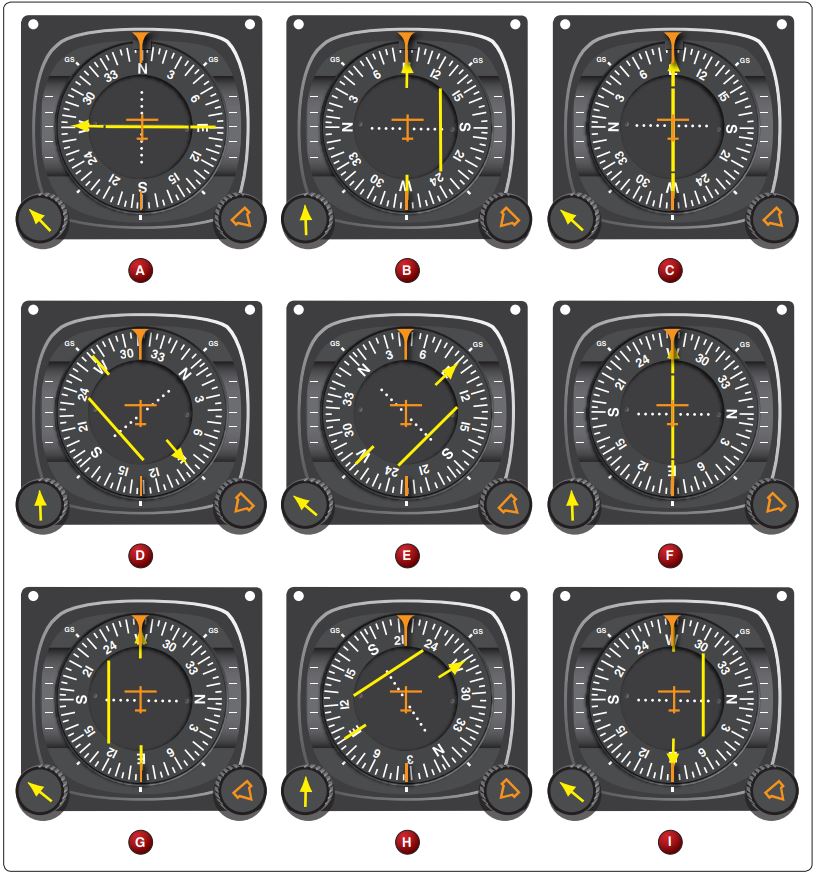 CorrectIncorrect
CorrectIncorrect -
Question 131 of 922
131. Question
Refer to figure 96 and figure 97 below. To which aircraft position(s) does HSI presentation “B” correspond? NOTE: HSI presentations B, C, D, E and I have backcourse settings of 090 degrees, which means there is reverse sensing irrespective of the airplane’s heading

 CorrectIncorrect
CorrectIncorrect -
Question 132 of 922
132. Question
Refer to figure 96 and figure 97 below. To which aircraft position(s) does HSI presentation “C” correspond? NOTE: HSI presentations B, C, D, E and I have backcourse settings of 090 degrees, which means there is reverse sensing irrespective of the airplane’s heading

 CorrectIncorrect
CorrectIncorrect -
Question 133 of 922
133. Question
Refer to figure 96 and figure 97 below. To which aircraft position(s) does HSI presentation “D” correspond? NOTE: HSI presentations B, C, D, E and I have backcourse settings of 090 degrees, which means there is reverse sensing irrespective of the airplane’s heading

 CorrectIncorrect
CorrectIncorrect -
Question 134 of 922
134. Question
Refer to figure 96 and figure 97 below. To which aircraft position(s) does HSI presentation “G” correspond? NOTE: HSI presentations B, C, D, E and I have backcourse settings of 090 degrees, which means there is reverse sensing irrespective of the airplane’s heading.



 CorrectIncorrect
CorrectIncorrect -
Question 135 of 922
135. Question
Refer to figure 96 and figure 97 below. To which aircraft position(s) does HSI presentation “F” correspond? NOTE: HSI presentations B, C, D, E and I have backcourse settings of 090 degrees, which means there is reverse sensing irrespective of the airplane’s heading.

 CorrectIncorrect
CorrectIncorrect -
Question 136 of 922
136. Question
Refer to figure 96 and figure 97 below. To which aircraft position(s) does HSI presentation “E” correspond? NOTE: HSI presentations B, C, D, E and I have backcourse settings of 090 degrees, which means there is reverse sensing irrespective of the airplane’s heading.

 CorrectIncorrect
CorrectIncorrect -
Question 137 of 922
137. Question
Refer to figure 96 and figure 97 below. To which aircraft position(s) does HSI presentation “H” correspond? NOTE: HSI presentations B, C, D, E and I have backcourse settings of 090 degrees, which means there is reverse sensing irrespective of the airplane’s heading

 CorrectIncorrect
CorrectIncorrect -
Question 138 of 922
138. Question
Refer to figure 96 and figure 97 below. To which aircraft position(s) does HSI presentation “I” correspond? NOTE: HSI presentations B, C, D, E and I have backcourse settings of 090 degrees, which means there is reverse sensing irrespective of the airplane’s heading

 CorrectIncorrect
CorrectIncorrect -
Question 139 of 922
139. Question
How should you preflight check the altimeter prior to an IFR flight?
CorrectIncorrect -
Question 140 of 922
140. Question
The local altimeter setting should be used by all pilots in a particular area, primarily to provide for
CorrectIncorrect -
Question 141 of 922
141. Question
If you are departing from an airport where you cannot obtain an altimeter setting, you should set your altimeter
CorrectIncorrect -
Question 142 of 922
142. Question
Which altitude is indicated when the altimeter is set to 29.92″ Hg?
CorrectIncorrect -
Question 143 of 922
143. Question
Altimeter setting is the value to which the scale of the pressure altimeter is set so the altimeter indicates
CorrectIncorrect -
Question 144 of 922
144. Question
While you are flying at FL 250, you hear ATC give an altimeter setting of 28.92″ Hg in your area. At what pressure altitude are you flying?
CorrectIncorrect -
Question 145 of 922
145. Question
The pressure altitude at a given location is indicated on the altimeter after the altimeter is set to
CorrectIncorrect -
Question 146 of 922
146. Question
How can you determine the pressure altitude on an airport without a tower or FSS?
CorrectIncorrect -
Question 147 of 922
147. Question
How can you obtain the pressure altitude on flights below 18,000 feet?
CorrectIncorrect -
Question 148 of 922
148. Question
At an altitude of 6,500 feet MSL, the current altimeter setting is 30.42″ Hg. The pressure altitude would be approximately
CorrectIncorrect -
Question 149 of 922
149. Question
How does a pilot normally obtain the current altimeter setting during an IFR flight in Class E airspace below 18,000 feet?
CorrectIncorrect -
Question 150 of 922
150. Question
What is the procedure for setting the altimeter when assigned an IFR altitude of 18,000 feet or higher on a direct flight off airways?
CorrectIncorrect -
Question 151 of 922
151. Question
En route at FL290, your altimeter is set correctly, but you fail to reset it to the local altimeter setting of 30.26″ Hg during descent. If the field elevation is 134 feet and your altimeter is functioning properly, what will it indicate after landing?
CorrectIncorrect -
Question 152 of 922
152. Question
Which of the following defines the type of altitude used when maintaining FL 210?
CorrectIncorrect -
Question 153 of 922
153. Question
En route at FL 290, the altimeter is set correctly, but not reset to the local altimeter setting of 30.57″ Hg during descent. If the field elevation is 650 feet and the altimeter is functioning properly, what is the approximate indication upon landing?
CorrectIncorrect -
Question 154 of 922
154. Question
Under which condition will pressure altitude be equal to true altitude?
CorrectIncorrect -
Question 155 of 922
155. Question
Under what condition is pressure altitude and density altitude the same value?
CorrectIncorrect -
Question 156 of 922
156. Question
Under what condition will true altitude be lower than indicated altitude with an altimeter setting of 29.92″ Hg?
CorrectIncorrect -
Question 157 of 922
157. Question
Which condition would cause the altimeter to indicate a lower altitude than actually flown (true altitude)?
CorrectIncorrect -
Question 158 of 922
158. Question
When an altimeter is changed from 30.11″ Hg to 29.92″ Hg, in which direction will the indicated altitude change and by what value?
CorrectIncorrect -
Question 159 of 922
159. Question
Which practical test should e made on the electric gyro instruments prior to starting an engine?
CorrectIncorrect -
Question 160 of 922
160. Question
One characteristic that a properly functioning gyro depends upon for operation is the
CorrectIncorrect -
Question 161 of 922
161. Question
What pre-takeoff check should be made of a vacuum-driven heading indicator in preparation for an IFR flight?
CorrectIncorrect -
Question 162 of 922
162. Question
What pre-takeoff check should be made of the altitude indicator in preparation for an IFR flight?
CorrectIncorrect -
Question 163 of 922
163. Question
Which condition during taxi is an indication that an altitude indicator is unreliable?
CorrectIncorrect -
Question 164 of 922
164. Question
How can a pilot determine if a Global Positioning System (GPS) installed in an aircraft is approved for IFR en route and IFR approaches?
CorrectIncorrect -
Question 165 of 922
165. Question
During coordinated turns, which force moves the pendulous vanes of a vacuum-driven altitude indicator resulting in precession of the gyro toward the inside of the turn?
CorrectIncorrect -
Question 166 of 922
166. Question
Hand-held GPS systems, and GPS systems certified for VFR operation, may be used during IFR operations as
CorrectIncorrect -
Question 167 of 922
167. Question
When may VFR waypoints be used in IFR flight plans?
CorrectIncorrect -
Question 168 of 922
168. Question
During IFR en route and terminal operations using an approved TS0-C129 or TS0-C196 GPS system for navigation, ground based navigational facilities
CorrectIncorrect -
Question 169 of 922
169. Question
During IFR en route operations using an approved TSO-C129 or TSO-C196 GPS system for navigation,
CorrectIncorrect -
Question 170 of 922
170. Question
What are the primary benefits of satellite-based area navigation (RNAV)?
CorrectIncorrect -
Question 171 of 922
171. Question
A handbook GPS is
CorrectIncorrect -
Question 172 of 922
172. Question
Effective navigation by means of GPS includes
CorrectIncorrect -
Question 173 of 922
173. Question
If a 180° steep turn is made to the right and the aircraft is rolled out to straight-and-level flight by visual references, the altitude indicator
CorrectIncorrect -
Question 174 of 922
174. Question
Why should pilots understand how to cancel entries made on a GPS?
CorrectIncorrect -
Question 175 of 922
175. Question
Reliance on GPS units
CorrectIncorrect -
Question 176 of 922
176. Question
Before a pilot utilizes a GPS route or procedure, what would be an acceptable method of verifying the GPS database is current?
CorrectIncorrect -
Question 177 of 922
177. Question
During normal coordinated turns, what error due to precession should you observe when rolling out to straight-and-level flight from a 180° steep turn to the right?
CorrectIncorrect -
Question 178 of 922
178. Question
When your aircraft is equipped with a TS0-C129 or TS0-C196 GPS, an airport may not be qualified for alternate use if
CorrectIncorrect -
Question 179 of 922
179. Question
When planning an IFR flight using GPS, the pilot should know that VFR waypoints
CorrectIncorrect -
Question 180 of 922
180. Question
Prior to using GPS waypoints for RNAV, what can you do to check the current status of the GPS database?
CorrectIncorrect -
Question 181 of 922
181. Question
While conducting a GPS approach, if you disengage the auto sensitivity, what will occur?
CorrectIncorrect -
Question 182 of 922
182. Question
GPS systems certified for IFR operations cannot be used as a substitute for DME receivers
CorrectIncorrect -
Question 183 of 922
183. Question
When using a TSO-C129 or TSO-C196 GPS for navigation and instrument approaches, any required alternate airport must have
CorrectIncorrect -
Question 184 of 922
184. Question
Your aircraft is equipped with a WMS enabled GPS unit. While performing a GPS approach, you note an “LNAVN NAV available” indication on the moving map display and horizontal situation indicator. You know that
CorrectIncorrect -
Question 185 of 922
185. Question
Aircraft operating under IFR with TSO-C129 or TS0-C196 GPS for en route navigation must also have installed
CorrectIncorrect -
Question 186 of 922
186. Question
Which of the following is a benefit of flying with an autopilot?
CorrectIncorrect -
Question 187 of 922
187. Question
In an autopilot-controlled system, what device actually moves the control surfaces?
CorrectIncorrect -
Question 188 of 922
188. Question
To ensure situational awareness while using an autopilot system
CorrectIncorrect -
Question 189 of 922
189. Question
During normal operation of a vacuum-driven altitude indicator, what altitude indication should you see when rolling out from a 180° skidding turn to straight-and-level coordinated flight?
CorrectIncorrect -
Question 190 of 922
190. Question
Errors in both pitch and bank indication on an altitude indicator are usually at a maximum as the aircraft rolls out of a
CorrectIncorrect -
Question 191 of 922
191. Question
When an aircraft is decelerated, some attitude indicators will precess and incorrectly indicate a
CorrectIncorrect -
Question 192 of 922
192. Question
During normal flight with a vacuum driven attitude indicator, control pressures normally should not move the horizon bar more than
CorrectIncorrect -
Question 193 of 922
193. Question
When an aircraft is accelerated, some attitude indicators will precess and incorrectly indicate a
CorrectIncorrect -
Question 194 of 922
194. Question
Prior to starting an engine, you should check the turn-and-slip indicator to determine if the
CorrectIncorrect -
Question 195 of 922
195. Question
What indications should you observe on the turn-and-slip indicator during taxi?
CorrectIncorrect -
Question 196 of 922
196. Question
What indication should be observed on a turn coordinator during a right turn while taxiing?
CorrectIncorrect -
Question 197 of 922
197. Question
What indications are displayed by the miniature aircraft of a turn coordinator?
CorrectIncorrect -
Question 198 of 922
198. Question
What does the miniature aircraft of the turn coordinator directly display?
CorrectIncorrect -
Question 199 of 922
199. Question
What indication is presented by the miniature aircraft of the turn coordinator?
CorrectIncorrect -
Question 200 of 922
200. Question
The displacement of a turn coordinator during a coordinated turn will
CorrectIncorrect -
Question 201 of 922
201. Question
What indication should be observed on a turn coordinator during a left turn while taxiing?
CorrectIncorrect -
Question 202 of 922
202. Question
What does the miniature aircraft of the turn coordinator display?
CorrectIncorrect -
Question 203 of 922
203. Question
In a left turn, correct control coordination is indicated by
CorrectIncorrect -
Question 204 of 922
204. Question
Which is true of glass cockpits?
CorrectIncorrect -
Question 205 of 922
205. Question
Which display combines instruments such as an altimeter, attitude indicator, and vertical speed indicator onto one given screen?
CorrectIncorrect -
Question 206 of 922
206. Question
Primary flight displays
CorrectIncorrect -
Question 207 of 922
207. Question
In a Technology Advanced Aircraft, the pilot sees the flight instruments on what?
CorrectIncorrect -
Question 208 of 922
208. Question
The lighter workloads associated with glass (digital) flight instrumentation
CorrectIncorrect -
Question 209 of 922
209. Question
When a pilot believes advanced avionics enable operations closer to personal or environmental limits,
CorrectIncorrect -
Question 210 of 922
210. Question
The advancement of avionics in light general aviation airplanes has enhanced situational awareness for properly trained pilots. However, there is concern that this technology could lead to
CorrectIncorrect -
Question 211 of 922
211. Question
Automation in aircraft has proven
CorrectIncorrect -
Question 212 of 922
212. Question
An aircraft which is equipped with an Electronic Flight Display (EFD) can
CorrectIncorrect -
Question 213 of 922
213. Question
Refer to figure 138 below. What night operations, if any, are authorized between the approach end of the runway, and the threshold lights?
 CorrectIncorrect
CorrectIncorrect -
Question 214 of 922
214. Question
Which runway marking indicates a displaced threshold on an instrument runway?
CorrectIncorrect -
Question 215 of 922
215. Question
Refer to figure 137 below. What is the distance (A) from the beginning of the runway to the fixed distance marker?
 —CorrectIncorrect
—CorrectIncorrect -
Question 216 of 922
216. Question
Refer to figure 137 below. What is the distance (B) from the beginning of the runway to the touchdown zone marker?
 CorrectIncorrect
CorrectIncorrect -
Question 217 of 922
217. Question
Refer to figure 137 below. What is the distance (C) from the beginning of the touchdown zone marker to the beginning of the fixed distance marker?
 CorrectIncorrect
CorrectIncorrect -
Question 218 of 922
218. Question
Destination signs indicate
CorrectIncorrect -
Question 219 of 922
219. Question
The “ILS critical area boundary” sign identifies the
CorrectIncorrect -
Question 220 of 922
220. Question
The “runway hold position” sign denotes
CorrectIncorrect -
Question 221 of 922
221. Question
The “No Entry” sign identifies
CorrectIncorrect -
Question 222 of 922
222. Question
What is the purpose of the runway exit sign?
CorrectIncorrect -
Question 223 of 922
223. Question
When exiting the runway, what is the purpose of the runway exit sign?
CorrectIncorrect -
Question 224 of 922
224. Question
Refer to figure 254 below. Which of the signs in the figure is a mandatory instruction sign?
 CorrectIncorrect
CorrectIncorrect -
Question 225 of 922
225. Question
Refer to figure 254 below. While clearing an active runway, you are clear of the ILS critical area when you pass which sign?
 CorrectIncorrect
CorrectIncorrect -
Question 226 of 922
226. Question
Refer to figure 254 below. Which sign indicates you are holding short of the ILS critical area?
 CorrectIncorrect
CorrectIncorrect -
Question 227 of 922
227. Question
A runway exit sign
CorrectIncorrect -
Question 228 of 922
228. Question
“Runway hold position” markings on the taxiway
CorrectIncorrect -
Question 229 of 922
229. Question
When turning onto a taxiway from another taxiway, the “taxiway directional sign” indicates
CorrectIncorrect -
Question 230 of 922
230. Question
Within aircraft movement areas, “destination signs” identify the
CorrectIncorrect -
Question 231 of 922
231. Question
Refer to figure 94 below. Mandatory airport instruction signs are designated by having
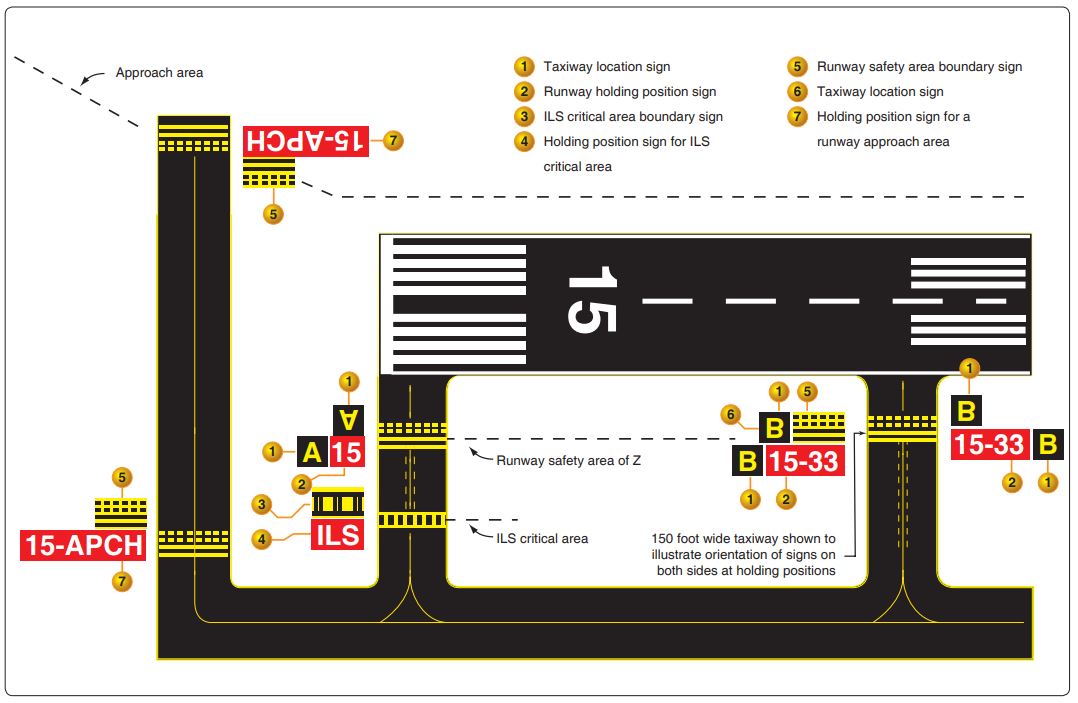 CorrectIncorrect
CorrectIncorrect -
Question 232 of 922
232. Question
Refer to figure 94 below. What colors are runway holding position signs?
 CorrectIncorrect
CorrectIncorrect -
Question 233 of 922
233. Question
Refer to figure 94 below. What colors are runway holding position signs?
 CorrectIncorrect
CorrectIncorrect -
Question 234 of 922
234. Question
Refer to figure 94 below. Hold line markings at the intersection of taxiways and runways consist of four lines that extend across the width of the taxiway. These lines are
 CorrectIncorrect
CorrectIncorrect -
Question 235 of 922
235. Question
Which approach and landing objective is assured when the pilot remains on the proper glidepath of the VASI?
CorrectIncorrect -
Question 236 of 922
236. Question
Refer to figure 135 below. Which illustration would a pilot observe if the aircraft is above both glidepaths?
 CorrectIncorrect
CorrectIncorrect -
Question 237 of 922
237. Question
Refer to figure 135 below. Which illustration would a pilot observe if the aircraft is below both glidepaths?
 CorrectIncorrect
CorrectIncorrect -
Question 238 of 922
238. Question
Refer to figure 135 below. Which illustration would a pilot observe when on the lower glidepath?
 CorrectIncorrect
CorrectIncorrect -
Question 239 of 922
239. Question
Which of the following terms describes an airport?
CorrectIncorrect -
Question 240 of 922
240. Question
The Glide Path Qualification Surface (GQS) limits the height of obstructions between
CorrectIncorrect -
Question 241 of 922
241. Question
The term “airport” means an area of land or water that is
CorrectIncorrect -
Question 242 of 922
242. Question
Do regulations permit you to act as pilot in command of an airplane in IMC if you hold a private pilot certificate with ASEL, rotorcraft category, with helicopter class rating and instrument helicopter rating?
CorrectIncorrect -
Question 243 of 922
243. Question
Under which condition must the pilot in command of a civil aircraft have at least an instrument rating?
CorrectIncorrect -
Question 244 of 922
244. Question
The pilot in command of a civil aircraft must have an instrument rating only when operating
CorrectIncorrect -
Question 245 of 922
245. Question
What portion of dual instruction time may a certificated instrument flight instructor log as instrument flight time?
CorrectIncorrect -
Question 246 of 922
246. Question
To meet instrument experience requirements of CFR Part 61, section 61.57(c), a pilot enters the condition of flight in the pilot logbook as simulated instrument conditions, what other qualifying information must also be entered?
CorrectIncorrect -
Question 247 of 922
247. Question
Which flight time may be logged as instrument time when on an instrument flight plan?
CorrectIncorrect -
Question 248 of 922
248. Question
What are the requirements to log an ILS approach in VMC conditions for instrument currency?
CorrectIncorrect -
Question 249 of 922
249. Question
How long does a pilot meet the recency of experience requirements for IFR flight after successfully completing an instrument proficiency check if no further IFR flights are made?
CorrectIncorrect -
Question 250 of 922
250. Question
No pilot may act as pilot-in-command of an aircraft, under IFR or in weather conditions less than the minimums prescribed for VFR unless that pilot has, within the preceding 6 calendar months, completed at least
CorrectIncorrect -
Question 251 of 922
251. Question
After your recent IFR experience lapses, how much time do you have before you must pass an instrument proficiency check to act as pilot in command under IFR?
CorrectIncorrect -
Question 252 of 922
252. Question
To meet the minimum required instrument flight experience to act as pilot in command of an aircraft under IFR, you must have logged within the 6 calendar months preceding the month of the flight, in the same category of aircraft:
CorrectIncorrect -
Question 253 of 922
253. Question
When on the proper glidepath of a 2-bar VASI, the pilot will see the near bar as
CorrectIncorrect -
Question 254 of 922
254. Question
Which of the following indications would a pilot see while approaching to land on a runway served by a 2-bar VASI?
CorrectIncorrect -
Question 255 of 922
255. Question
If an approach is being made to a runway that has an operating 3-bar VASI and all the VASI lights appear red as the airplane reaches the MDA the pilot should
CorrectIncorrect -
Question 256 of 922
256. Question
The middle and far bars of a 3-bar VASI will
CorrectIncorrect -
Question 257 of 922
257. Question
Refer to figure 136 below. An “on glidepath” indication is
 CorrectIncorrect
CorrectIncorrect -
Question 258 of 922
258. Question
Refer to figure 136 below. Which illustration depicts a “slightly low” (2.8 degree) indication?
 CorrectIncorrect
CorrectIncorrect -
Question 259 of 922
259. Question
Refer to figure 136 below. Which illustration would a pilot observe if the aircraft is less than 2.5 degrees?
 CorrectIncorrect
CorrectIncorrect -
Question 260 of 922
260. Question
Refer to figure 136 below. Which illustration would a pilot observe if the aircraft is far below the glidepath?
 CorrectIncorrect
CorrectIncorrect -
Question 261 of 922
261. Question
Refer to figure 162 below. You have accepted a visual approach to RWY 16L at EUG at night. As you approach the runway, you notice runway centerline lights. This indicates
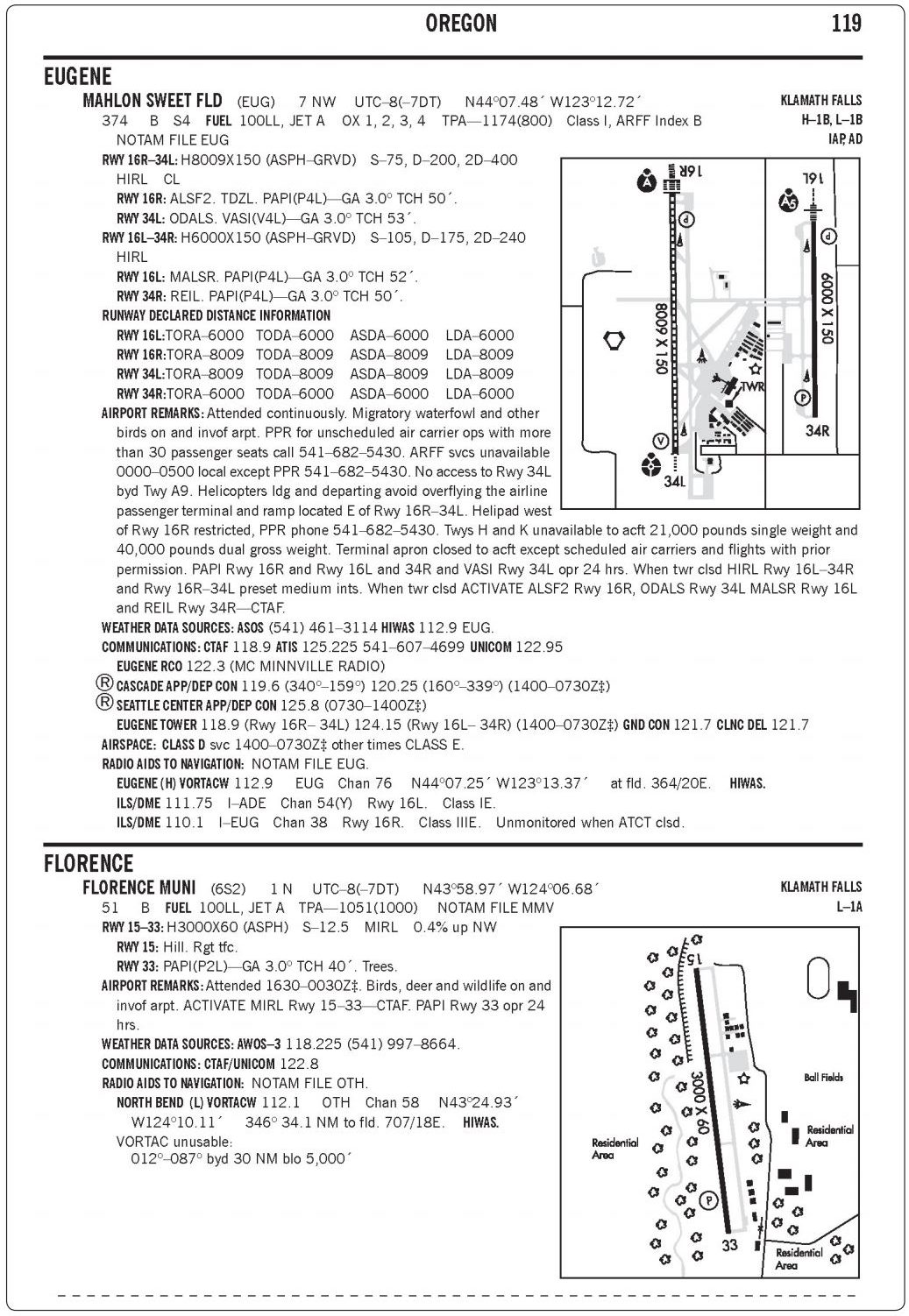 CorrectIncorrect
CorrectIncorrect -
Question 262 of 922
262. Question
The primary purpose of runway and identifier lights installed at many airfields is to provide
CorrectIncorrect -
Question 263 of 922
263. Question
Which type of runway lighting consists of a pair of synchronized flashing lights, one on each side of the runway threshold?0
CorrectIncorrect -
Question 264 of 922
264. Question
What wind condition prolongs the hazards of wake turbulence on a landing runway for the longest period of time?
CorrectIncorrect -
Question 265 of 922
265. Question
Wake turbulence is near maximum behind a jet transport just after takeoff because
CorrectIncorrect -
Question 266 of 922
266. Question
Refer to figure 158 below. With winds reported as from 330° at 4 knots, you are given instructions to taxi to runway 4 for departure and to expect takeoff after an airliner departs from runway 29. What effect would you expect from that airliner’s vortices.
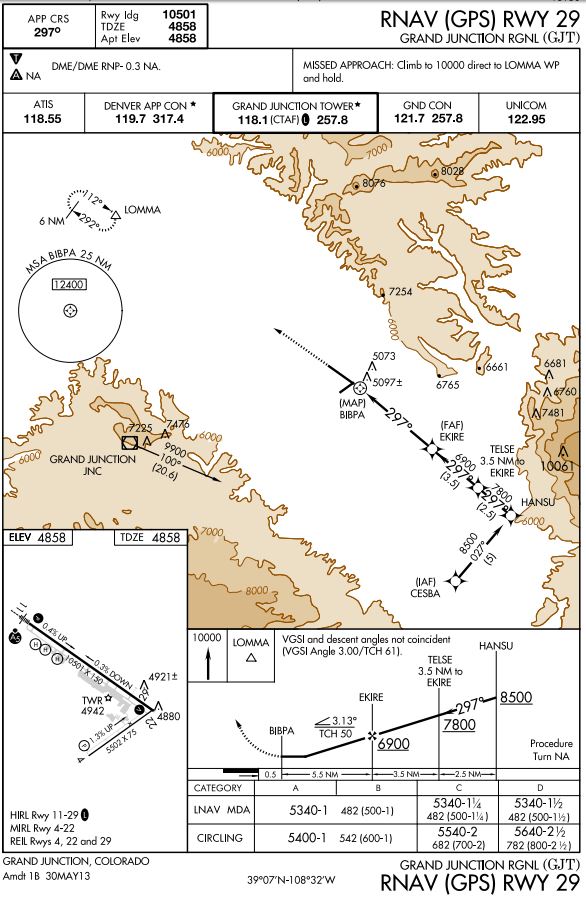 CorrectIncorrect
CorrectIncorrect -
Question 267 of 922
267. Question
What effect would a light crosswind of approximately 7 knots have on vortex behavior?
CorrectIncorrect -
Question 268 of 922
268. Question
When landing behind a large jet aircraft, at which point on the runway should you plan to land?
CorrectIncorrect -
Question 269 of 922
269. Question
Which procedure is recommended while climbing to an assigned altitude on the airway?
CorrectIncorrect -
Question 270 of 922
270. Question
What is expected of you as pilot on an IFR flight plan if you are descending or climbing in VFR conditions?
CorrectIncorrect -
Question 271 of 922
271. Question
When is a pilot on an IFR flight plan responsible for avoiding other aircraft?
CorrectIncorrect -
Question 272 of 922
272. Question
What responsibility does the pilot in command of an IFR flight assume upon entering VFR conditions?
CorrectIncorrect -
Question 273 of 922
273. Question
The most current en route and destination flight information for planning an instrument flight should be obtained from
CorrectIncorrect -
Question 274 of 922
274. Question
What is the purpose of FDC NOTAMs?
CorrectIncorrect -
Question 275 of 922
275. Question
From what source can you obtain the latest FDC NOTAMs?
CorrectIncorrect -
Question 276 of 922
276. Question
Which sources of aeronautical information, when used collectively, provide the latest status of airport conditions (e.g., runway closures, runway lighting, snow conditions)?
CorrectIncorrect -
Question 277 of 922
277. Question
Absence of the sky condition and visibility on an ATIS broadcast specifically implies that
CorrectIncorrect -
Question 278 of 922
278. Question
The operation of an airport rotating beacon during daylight hours may indicate that
CorrectIncorrect -
Question 279 of 922
279. Question
When are ATIS broadcasts updated?
CorrectIncorrect -
Question 280 of 922
280. Question
What information is contained in the Notices to Airmen Publication (NTAP)?
CorrectIncorrect -
Question 281 of 922
281. Question
What point at the destination should be used to compute estimated time en route on an IFR flight plan?
CorrectIncorrect -
Question 282 of 922
282. Question
Refer to figure 1 below. Which equipment determines the code to be entered in block 3 as a suffix to aircraft type on the flight plan form?
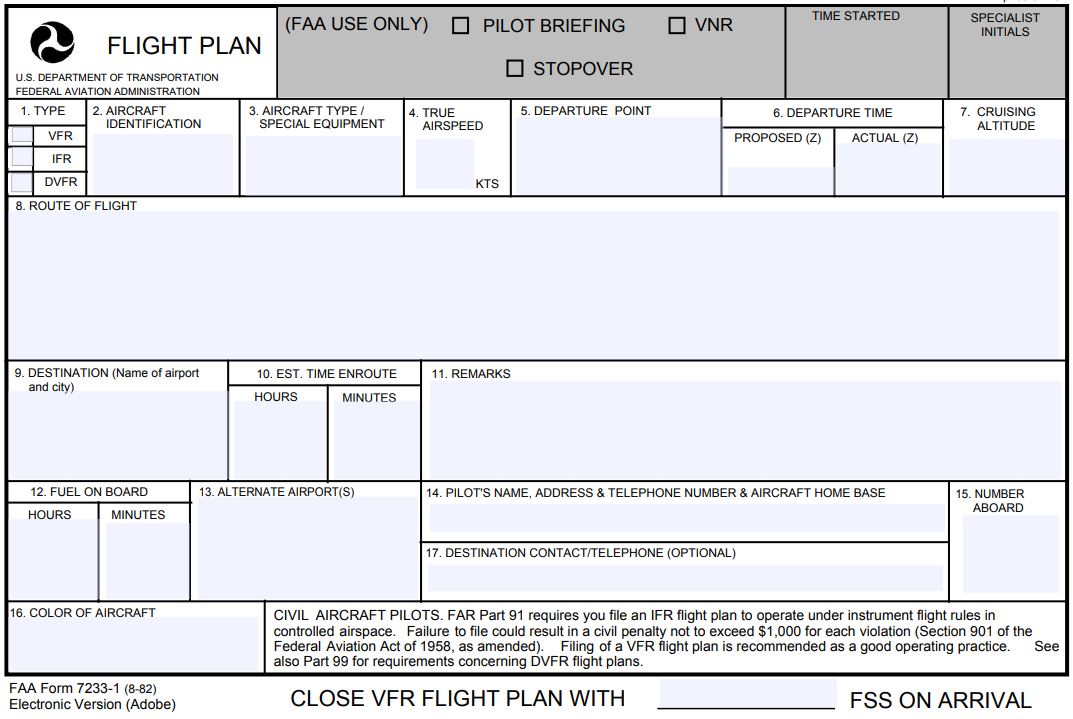 CorrectIncorrect
CorrectIncorrect -
Question 283 of 922
283. Question
Refer to figure 1 below. What information should be entered in block 7 of an IFR flight plan if the flight has three legs, each at a different altitude?
 CorrectIncorrect
CorrectIncorrect -
Question 284 of 922
284. Question
Refer to figure 1 below. The time entered in block 12 for an IFR flight should be based on which fuel quantity?
 CorrectIncorrect
CorrectIncorrect -
Question 285 of 922
285. Question
What is a waypoint when used for an IFR flight?
CorrectIncorrect -
Question 286 of 922
286. Question
You may cancel an IFR flight plan
CorrectIncorrect -
Question 287 of 922
287. Question
How is your flight plan closed when your destination airport has IFR conditions and there is no control tower?
CorrectIncorrect -
Question 288 of 922
288. Question
What response is expected when ATC issues an IFR clearance to pilots of airborne aircraft?
CorrectIncorrect -
Question 289 of 922
289. Question
Which clearance items are always given in an abbreviated IFR departure clearance? (Assume radar environment.)
CorrectIncorrect -
Question 290 of 922
290. Question
Which information is always given in an abbreviated departure clearance?
CorrectIncorrect -
Question 291 of 922
291. Question
An abbreviated departure clearance “…CLEARED AS FILED…” will always contain the name
CorrectIncorrect -
Question 292 of 922
292. Question
When departing from an airport not served by a control tower, the issuance of a clearance containing a void time indicates that
CorrectIncorrect -
Question 293 of 922
293. Question
On the runup pad, you receive the following clearance from ground control: CLEARED TO THE DALLAS-LOVE AIRPORT AS FILED–MAINTAIN SIX THOUSAND — SQUAWK ZERO SEVEN ZERO FOUR JUST BEFORE DEPARTURE — DEPARTURE CONTROL WILL BE ONE TWO FOUR POINT NINER.
An abbreviated clearance, such as this, will always contain theCorrectIncorrect -
Question 294 of 922
294. Question
What is the significance of an ATC clearance which reads “…CRUISE SIX THOUSAND…”?
CorrectIncorrect -
Question 295 of 922
295. Question
What is the significance of an ATC clearance which reads “…CRUISE SIX THOUSAND…”
CorrectIncorrect -
Question 296 of 922
296. Question
What is the rule or a pilot receiving a “Land and Hold Short Operation (LAHSO) clearance?”
CorrectIncorrect -
Question 297 of 922
297. Question
A “CRUISE FOUR THOUSAND FEET” clearance would mean that the pilot is authorized to
CorrectIncorrect -
Question 298 of 922
298. Question
When should pilots state their position on the airport when calling the tower for takeoff?
CorrectIncorrect -
Question 299 of 922
299. Question
During a takeoff into IMC at a controlled field with low ceilings, you should contact departure
CorrectIncorrect -
Question 300 of 922
300. Question
When should you transponder be on Mode C while on an IFR flight?
CorrectIncorrect -
Question 301 of 922
301. Question
What is the recommended climb procedure when a nonradar departure control instructs a pilot to climb to the assigned altitude?
CorrectIncorrect -
Question 302 of 922
302. Question
To comply with ATC instructions for altitude changes of more than 1,000 feet, what rate of climb or descent should be used?
CorrectIncorrect -
Question 303 of 922
303. Question
Which report should be made to ATC without a specific request when not in radar contact?
CorrectIncorrect -
Question 304 of 922
304. Question
When ATC has not imposed any climb or descent restrictions and aircraft are within 1,000 feet of assigned altitude, pilots should attempt to both climb and descend at a rate of between
CorrectIncorrect -
Question 305 of 922
305. Question
What does the ATC term “Radar Contact” signify?
CorrectIncorrect -
Question 306 of 922
306. Question
For IFR planning purposes, what are the compulsory reporting points when using VOR/DME or VORTAC fixes to define a direct route not on
established airways?CorrectIncorrect -
Question 307 of 922
307. Question
During a flight, the controller advises “traffic 2 o’clock 5 miles southbound.” The pilot is holding 20° correction for a crosswind from the right. Where should the pilot look for the traffic?
CorrectIncorrect -
Question 308 of 922
308. Question
While performing a VFR practice instrument approach, Radar Approach Control assigns an altitude or heading that will cause you to enter the clouds. What action should you take?
CorrectIncorrect -
Question 309 of 922
309. Question
You have not yet been cleared for the approach, but you are being vectored to the ILS approach course. It is clear that you will pass through the localizer course unless you take action. You should
CorrectIncorrect -
Question 310 of 922
310. Question
What is the pilot in command’s responsibility when flying a propeller aircraft within 20 miles of the airport of intended landing and ATC requests the pilot to reduce speed to 160? (Pilot complies with speed adjustment.)
CorrectIncorrect -
Question 311 of 922
311. Question
Upon intercepting the assigned radial, the controller advises you that you are on the airway and to “RESUME OWN NAVIGATION.” This phrase means that
CorrectIncorrect -
Question 312 of 922
312. Question
During the en route phase of an IFR flight, the pilot is advised “Radar service terminated.” What action is appropriate?
CorrectIncorrect -
Question 313 of 922
313. Question
What is meant when departure control instructs you to “resume own navigation” after you have been vectored to a Victor airway?
CorrectIncorrect -
Question 314 of 922
314. Question
What service is provided by departure control to an IFR flight when operating from an airport within the outer area of Class C airspace?
CorrectIncorrect -
Question 315 of 922
315. Question
While on an IFR flight plan, you should notify ATC of a variation in speed when
CorrectIncorrect -
Question 316 of 922
316. Question
Unless otherwise stated, instrument procedures use the standard IFR climb gradient of
CorrectIncorrect -
Question 317 of 922
317. Question
When are you required to establish communications with the tower (Class D airspace), if you cancel your IFR flight plan 10 miles from the
destination?CorrectIncorrect -
Question 318 of 922
318. Question
What does declaring “minimum fuel” to ATC imply?
CorrectIncorrect -
Question 319 of 922
319. Question
Which procedure should you follow if you experience two-way communications failure while holding at holding fix with an EFC time? (The holding fix is not the same as the approach fix.)
CorrectIncorrect -
Question 320 of 922
320. Question
You enter a holding pattern (at a fix that is not the same as the approach fix) with an EFC time of 1530 . At 1520 you experience complete two-way communications failure. Which procedure should you follow to execute the approach to a landing?
CorrectIncorrect -
Question 321 of 922
321. Question
You are !n IMC and have two-way radio communications failure. If you do not exercise emergency authority, what procedure are you expected to follow?
CorrectIncorrect -
Question 322 of 922
322. Question
What altitude and route should be used if you are flying in IMC and have two-way radio communications failure?
CorrectIncorrect -
Question 323 of 922
323. Question
Which procedure should you follow if, during an IFR flight in VFR conditions, you have two-way radio communications failure?
CorrectIncorrect -
Question 324 of 922
324. Question
While flying on an IFR flight plan, you experience two-way communications radio failure while in VFR conditions. In this situation, you should continue your flight under
CorrectIncorrect -
Question 325 of 922
325. Question
What action should you take if your DME fails at FL 240?
CorrectIncorrect -
Question 326 of 922
326. Question
What action should you take if your No. 1 VOR receiver malfunctions while operating in controlled airspace under IFR? Your aircraft is equipped with
two VOR receivers. The No. 1 receiver has Omni/Localizer/Glide Slope capability, and the No. 2 receiver has only VOR/Localizer capability.CorrectIncorrect -
Question 327 of 922
327. Question
To meet the minimum instrument experience requirements, within the last 6 calendar months you need
CorrectIncorrect -
Question 328 of 922
328. Question
A pilot may satisfy the recent flight experience requirement necessary to act as pilot in command in IMC in powered aircraft by logging within the 6 calendar months preceding the month of the flight
CorrectIncorrect -
Question 329 of 922
329. Question
What minimum conditions are necessary for the instrument approaches required for IFR currency?
CorrectIncorrect -
Question 330 of 922
330. Question
What recent instrument flight experience requirements must be met before you may act as pilot in command of an airplane under IFR?
CorrectIncorrect -
Question 331 of 922
331. Question
An instrument rated pilot who has not logged any instrument time in 1 year or more cannot serve as pilot in command under IFR, unless the pilot
CorrectIncorrect -
Question 332 of 922
332. Question
A pilot’s recent IFR experience expires on July 1 of this year. What is the latest date the pilot can meet the IFR experience requirement without having to take an instrument proficiency check?
CorrectIncorrect -
Question 333 of 922
333. Question
How may a pilot satisfy the recent flight experience requirement necessary to act as pilot in command in IMC in powered aircraft? Within the previous 6 calendar months, logged
CorrectIncorrect -
Question 334 of 922
334. Question
Which additional IFR experience is required for you to meet the recent flight experience requirements to act as pilot in command of an airplane under IFR?
Your present instrument experience within the preceding 6 calendar months is
1. three hours with holding, intercepting and tracking courses in an approved airplane flight simulator.
2. two instrument approaches in an airplane.
CorrectIncorrect -
Question 335 of 922
335. Question
A pilot plans an IFR flight on July 10 of this year. In order to meet IFR currency requirements the pilot must have
CorrectIncorrect -
Question 336 of 922
336. Question
Which additional instrument experience, within the preceding 6 calendar months, is required to meet the requirements to act as pilot in command of an airplane under IFR if you already have 3 hours in an instrument simulator (including holding, intercepting, and tracking courses) and two instrument approaches in an airplane?
CorrectIncorrect -
Question 337 of 922
337. Question
To carry passengers for hire in an airplane on cross-country flights of more than 50 NM from the departure airport, the pilot in command is required to hold at least
CorrectIncorrect -
Question 338 of 922
338. Question
Which limitation is imposed on the holder of a Commercial Pilot Certificate if that person does not hold an instrument rating?
CorrectIncorrect -
Question 339 of 922
339. Question
What limitation is imposed on a newly certificated commercial airplane pilot if that person does not hold an instrument pilot rating?
CorrectIncorrect -
Question 340 of 922
340. Question
A certificated commercial pilot who carries passengers for hire at night or in excess of 50 NM is required to have at least
CorrectIncorrect -
Question 341 of 922
341. Question
You intend to carry passengers for hire on a night VFR flight in a single-engine airplane with a 25-mile radius of the departure airport. You are required to possess at least which ratings(s)?
CorrectIncorrect -
Question 342 of 922
342. Question
Who is responsible for determining that the altimeter system has been checked and found to meet 14 CFR Part 91 requirements for a particular instrument flight?
CorrectIncorrect -
Question 343 of 922
343. Question
The use of certain portable electronic devices is prohibited on aircraft that are being operated under
CorrectIncorrect -
Question 344 of 922
344. Question
Before beginning any flight under IFR, the pilot in command must become familiar with all available information concerning that flight. In addition, the pilot must
CorrectIncorrect -
Question 345 of 922
345. Question
What is the procedure when the DME malfunctions at or above 24,000 feet MSL?
CorrectIncorrect -
Question 346 of 922
346. Question
Which types of airspace are depicted on the En Route Low Altitude Chart?
CorrectIncorrect -
Question 347 of 922
347. Question
The vertical extent of the Class A airspace extends from
CorrectIncorrect -
Question 348 of 922
348. Question
Which airspace is defined as a transition area when designated in conjunction with an airport which has a prescribed IAP?
CorrectIncorrect -
Question 349 of 922
349. Question
Class G airspace is that airspace where
CorrectIncorrect -
Question 350 of 922
350. Question
MCAs are established to
CorrectIncorrect -
Question 351 of 922
351. Question
What minimum aircraft equipment is required for operation within Class C airspace?
CorrectIncorrect -
Question 352 of 922
352. Question
What are the vertical limits of a transition area that is designated in conjunction with an airport having a prescribed IAP?
CorrectIncorrect -
Question 353 of 922
353. Question
Refer to figure 162 below. You are cleared to land on RWY 16L at Eugene Mahlon Sweet Field. As you break out of the clouds, you are lined up with the white lights down the center of the runway, which lets you know that you

 CorrectIncorrect
CorrectIncorrect -
Question 354 of 922
354. Question
Refer to figure 251 below. What is the slope of RWY 9?
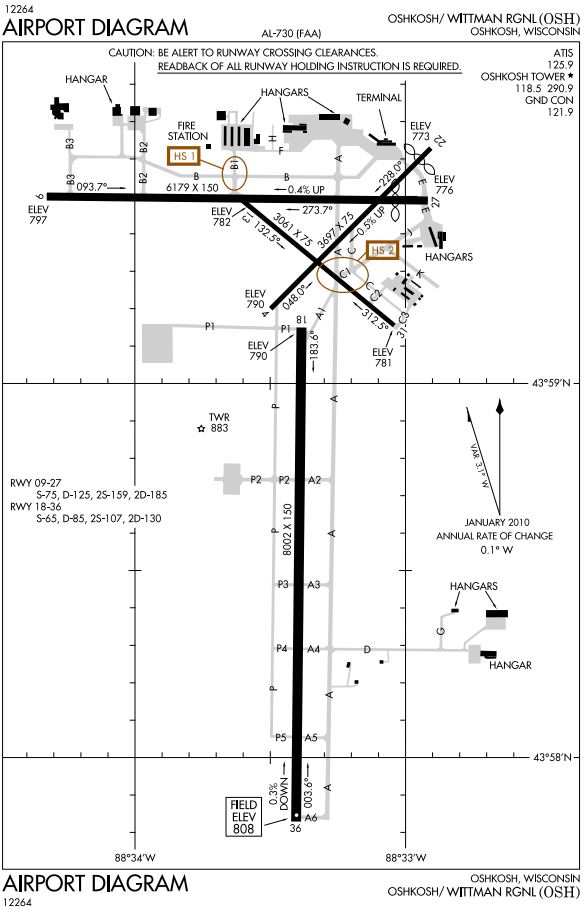 CorrectIncorrect
CorrectIncorrect -
Question 355 of 922
355. Question
Refer to figure 251 below. When lined up for takeoff on runway 4, the compass and heading indicator should read a heading of about
 CorrectIncorrect
CorrectIncorrect -
Question 356 of 922
356. Question
Refer to figure 251 below. When lined up for takeoff on runway 18, the compass and heading indicator should display a heading of about
 CorrectIncorrect
CorrectIncorrect -
Question 357 of 922
357. Question
Refer to figure 251 below. What is the actual heading of the north runway at Oshkosh/Wittman Regional (OSH) airport?
 CorrectIncorrect
CorrectIncorrect -
Question 358 of 922
358. Question
Refer to figure 251 below. When lined up for takeoff on RWY 27, the compass and heading indicator should display a heading of about
 CorrectIncorrect
CorrectIncorrect -
Question 359 of 922
359. Question
Before beginning any flight under IFR, the pilot in command must become familiar with all available information concerning that flight including:
CorrectIncorrect -
Question 360 of 922
360. Question
What are the minimum qualifications for a person who occupies the other control seat as safety pilot during simulated instrument flight?
CorrectIncorrect -
Question 361 of 922
361. Question
When may ATC request a detailed report of an emergency even though a rule has not been violated?
CorrectIncorrect -
Question 362 of 922
362. Question
While on an IFR flight, a pilot has an emergency which causes a deviation from an ATC clearance. What action must be taken?
CorrectIncorrect -
Question 363 of 922
363. Question
During an IFR flight in IMC, a distress condition is encountered, (fire, mechanical, or structural failure). The pilot should
CorrectIncorrect -
Question 364 of 922
364. Question
While on an IFR flight, a pilot has an emergency that causes a deviation from an ATC clearance. What action must be taken?
CorrectIncorrect -
Question 365 of 922
365. Question
Your transponder is inoperative. What are the requirements for flying in Class D airspace?
CorrectIncorrect -
Question 366 of 922
366. Question
In addition to a VOR receiver and two-way communications capability, which additional equipment is required for IFR operation in Class B airspace?
CorrectIncorrect -
Question 367 of 922
367. Question
Which of the following is required equipment for operating an aircraft within Class B airspace?
CorrectIncorrect -
Question 368 of 922
368. Question
When is an IFR clearance required during VFR weather conditions?
CorrectIncorrect -
Question 369 of 922
369. Question
When is an IFR flight plan required?
CorrectIncorrect -
Question 370 of 922
370. Question
Operation in which airspace requires filing an IFR flight plan?
CorrectIncorrect -
Question 371 of 922
371. Question
When are you required to have an instrument rating for flight in VMC?
CorrectIncorrect -
Question 372 of 922
372. Question
What is the required flight visibility and distance from clouds if you are operating in Class E airspace at 9,500 feet MSL with a VFR-on-Top clearance during daylight hours?
CorrectIncorrect -
Question 373 of 922
373. Question
What conditions are necessary before ATC can authorize a visual approach?
CorrectIncorrect -
Question 374 of 922
374. Question
What is the minimum flight visibility and distance from clouds for flight at 10,500 feet with a VFR-on-Top clearance during daylight hours? (Class E airspace.)
CorrectIncorrect -
Question 375 of 922
375. Question
What are the main differences between a visual approach and a contact approach?
CorrectIncorrect -
Question 376 of 922
376. Question
A contact approach is an approach procedure that may be used
CorrectIncorrect -
Question 377 of 922
377. Question
You arrive at your destination airport on an IFR flight plan. Which is a prerequisite condition for the performance of a contact approach?
CorrectIncorrect -
Question 378 of 922
378. Question
Flying clear of clouds on an instrument flight plan, what are the requirements for a contact approach to an airport that has an approved IAP?
CorrectIncorrect -
Question 379 of 922
379. Question
When is radar service terminated during a visual approach?
CorrectIncorrect -
Question 380 of 922
380. Question
When may you obtain a contact approach?
CorrectIncorrect -
Question 381 of 922
381. Question
A Precision Runway Monitor (PRM), approach requires
CorrectIncorrect -
Question 382 of 922
382. Question
Precision Runway Monitoring (PRM) is
CorrectIncorrect -
Question 383 of 922
383. Question
What does the Runway Visual Range (RVR) value, depicted on certain straight-in IAP Charts, represent?
CorrectIncorrect -
Question 384 of 922
384. Question
The RVR minimums for takeoff or landing are published in an IAP, but RVR is inoperative and cannot be reported for the runway at the time. Which of the following would apply?
CorrectIncorrect -
Question 385 of 922
385. Question
RVR minimums for landing are prescribed in an IAP, but RVR is inoperative and cannot be reported for the intended runway at the time. Which of the following would be an operational consideration?
CorrectIncorrect -
Question 386 of 922
386. Question
If the RVR equipment is inoperative for an IAP that requires a visibility of 2,400 RVR, how should the pilot expect the visibility requirement to be reported in lieu of the published RVR?
CorrectIncorrect -
Question 387 of 922
387. Question
If the RVR is not reported, what meteorological value should you substitute for 2400 RVR?
CorrectIncorrect -
Question 388 of 922
388. Question
If an early missed approach is initiated before reaching the MAP, the following procedure should be used unless otherwise cleared by ATC
CorrectIncorrect -
Question 389 of 922
389. Question
If the pilot loses visual reference while circling to land from an instrument approach and ATC radar service is not available, the missed approach action
CorrectIncorrect -
Question 390 of 922
390. Question
Refer to figure 232 below. During the LOG RWY 35 missed approach at Duncan/Halliburton Field (DUG), what would be the appropriate entry for the
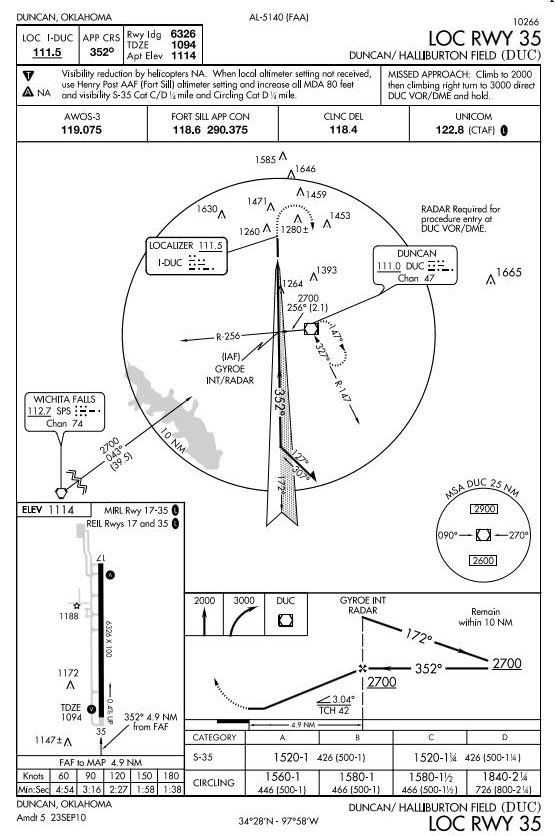 CorrectIncorrect
CorrectIncorrect -
Question 391 of 922
391. Question
Which of the following statements is true regarding Parallel ILS approaches?
CorrectIncorrect -
Question 392 of 922
392. Question
If all ILS components are operating and the required visual references are not established, the missed approach should be initiated upon
CorrectIncorrect -
Question 393 of 922
393. Question
If during an ILS approach in IFR conditions, the approach lights are not visible upon arrival at the DH, the pilot is
CorrectIncorrect -
Question 394 of 922
394. Question
How does a pilot determine if DME is available on an ILS/LOC?
CorrectIncorrect -
Question 395 of 922
395. Question
Refer to figure 139 and figure 141 below. Which displacement from the localizer centerline and glide slope at the 1,300-foot point from the runway is indicated?

 CorrectIncorrect
CorrectIncorrect -
Question 396 of 922
396. Question
Refer to figure 140 , figure 141, and figure 142 below. Which displacement from the localizer centerline and glide slope indicates you are high and to the left of the ILS course?


 CorrectIncorrect
CorrectIncorrect -
Question 397 of 922
397. Question
Refer to figure 140, figure 141 and figure 142 below. Which displacement from the localizer centerline and glide slope indicates you are low and to the left of the ILS course?


 CorrectIncorrect
CorrectIncorrect -
Question 398 of 922
398. Question
Refer to figure 140, figure 141 and figure 142 below. Which displacement from the localizer centerline and glide slope indicates you are high and to the right of the ILS course?


 CorrectIncorrect
CorrectIncorrect -
Question 399 of 922
399. Question
Which pilot action is appropriate if more than one component of an ILS is unusable?
CorrectIncorrect -
Question 400 of 922
400. Question
Which substitution is appropriate during an ILS appraoch?
CorrectIncorrect -
Question 401 of 922
401. Question
A pilot is making an ILS approach and is past the OM to a runway which has a VASI. What action is appropriate if an electronic glide slope malfunction occurs and the pilot has the VSI in sight?
CorrectIncorrect -
Question 402 of 922
402. Question
Immediately after passing the final approach fix in bound during an ILS approach in IFR conditions the glide slope warning flag appears. The pilot is
CorrectIncorrect -
Question 403 of 922
403. Question
When installed with the ILS and specified in the approach procedures, DME may be used
CorrectIncorrect -
Question 404 of 922
404. Question
When passing through an abrupt wind shear which involves a shift from a tailwind to a headwind, what power management would normally be required to maintain a constant indicated airspeed and ILS glide slope?
CorrectIncorrect -
Question 405 of 922
405. Question
The rate of descent on the glide slope depends on
CorrectIncorrect -
Question 406 of 922
406. Question
The rate of descent required to stay on the ILS glide slope
CorrectIncorrect -
Question 407 of 922
407. Question
During a precision radar or ILS approach, the rate of descent required to remain on the glide slope will
CorrectIncorrect -
Question 408 of 922
408. Question
A flight is to be conducted in VFR-on-Top conditions at 12,500 feet MSL (above 1,200 feet AGL). What is the in-flight visibility and distance from clouds required for operation in Class E airspace during daylight hours?
CorrectIncorrect -
Question 409 of 922
409. Question
What is the minimum in-flight visibility and distance from clouds required for an airplane operating less than 1,200 feet AGL during daylight hours in Class G airspace?
CorrectIncorrect -
Question 410 of 922
410. Question
What is the minimum in-flight visibility and distance from clouds required in VFR conditions above clouds at 13,500 feet MSL (above 1,200 feet AGL) in Class G airspace during daylight hours?
CorrectIncorrect -
Question 411 of 922
411. Question
What is the minimum in-flight visibility and distance from clouds required for a VFR-on-Top flight at 9,500 feet MSL (above 1,200 feet AGL) during daylight hours?
CorrectIncorrect -
Question 412 of 922
412. Question
What in-flight visibility and distance from clouds is required for a flight at 8,500 feet MSL (above 1,200 feet AGL) in Class G airspace in VFR conditions during daylight hours?
CorrectIncorrect -
Question 413 of 922
413. Question
What is the minimum in-flight visibility and distance from clouds required for an airplane operating less than 1,200 feet AGL under special VFR during daylight hours?
CorrectIncorrect -
Question 414 of 922
414. Question
What are the minimum fuel requirements in IFR conditions, if the first airport of intended landing is forecast to have a 1,500 foot ceiling and 3 miles visibility at flight-planned ETA? Fuel to fly to the first airport of intended landing,
CorrectIncorrect -
Question 415 of 922
415. Question
During your preflight planning for an IFR flight, you determine that the first airport of intended landing has no instrument approach prescribed in 14 CFR part 97. The weather forecast for one hour before through one hour after your estimated time of arrival is 3,000 ft. scattered with 5 miles visibility. To meet the fuel requirements for this flight, you must be able to fly to the first airport of intended landing,
CorrectIncorrect -
Question 416 of 922
416. Question
When tracking in bound on the localizer, which of the following is the proper procedure regarding drift corrections?
CorrectIncorrect -
Question 417 of 922
417. Question
What effect will a change in wind direction have upon maintaining a 3° glide slope at a constant true
CorrectIncorrect -
Question 418 of 922
418. Question
While being vectored, if crossing the ILS final approach course becomes imminent and an approach clearance has not been issued, what action should be taken by the pilot?
CorrectIncorrect -
Question 419 of 922
419. Question
Thrust is managed to maintain IAS, and glide slope is being flown. What characteristics should be observed when a headwind shears to be a constant tailwind?
CorrectIncorrect -
Question 420 of 922
420. Question
The glide slope and localizer are centered, but the airspeed is too fast. Which should be adjusted initially?
CorrectIncorrect -
Question 421 of 922
421. Question
While flying a 3° glide slope, a constant tailwind shears to a calm wind. Which conditions should the pilot expect?
CorrectIncorrect -
Question 422 of 922
422. Question
While flying a 3° glide slope, a headwind shears to a tailwind. Which conditions should the pilot expect on a glide slope?
CorrectIncorrect -
Question 423 of 922
423. Question
When cleared to execute a published sidestep maneuver for a specific approach and landing on the parallel runway, at what point is the pilot expected to commence this maneuver?
CorrectIncorrect -
Question 424 of 922
424. Question
Assume this clearance is received:
“CLEARED FOR ILS RUNWAY 07 LEFT APPROACH, SIDE-STEP TO RUNWAY 07 RIGHT.”
When would the pilot be expected to commence the side-step maneuver?CorrectIncorrect -
Question 425 of 922
425. Question
Refer to figure 113 below. You receive this ATC clearance: “…CLEARED TO THE ABC VORTAC. HOLD WEST ON THE TWO SEVEN ZERO RADIAL…” What is the recommended procedure to enter the holding pattern?
 CorrectIncorrect
CorrectIncorrect -
Question 426 of 922
426. Question
Refer to figure 113 below. you receive the ATC clearance: “…HOLD EAST OF THE ABC VORTAC ON THE ZERO NINER ZERO RADIAL LEFT TURNS…” What is the recommended procedure to enter the holding pattern?
 CorrectIncorrect
CorrectIncorrect -
Question 427 of 922
427. Question
Refer to figure 113 below. You receive this ATC clearance: “…CLEARED TO THE ABC VORTAC HOLD SOUTH ON THE ONE EIGHT ZERO RADIAL…” What is the recommended procedure to enter the holding pattern?
 CorrectIncorrect
CorrectIncorrect -
Question 428 of 922
428. Question
Refer to figure 113 below. You receive this ATC clearance: “…CLEARED TO THE XYZ VORTAC HOLD NORTH ON THE THREE SIX ZERO RADIAL LEFT TURNS….” What is the recommended procedure to enter the holding pattern?
 CorrectIncorrect
CorrectIncorrect -
Question 429 of 922
429. Question
Refer to figure 114 below. A pilot receives this ATC clearance: “…CLEARED TO THE ABC VORTAC HOLD WEST ON THE TWO SEVEN ZERO RADIAL…” What is the recommended procedure to enter the holding pattern?
 CorrectIncorrect
CorrectIncorrect -
Question 430 of 922
430. Question
Refer to figure 114 below. A pilot receives the ATC clearance: “…CLEARED TO THE XYZ VORTAC HOLD NORTH ON THE THREE SIX ZERO RADIAL, LEFT TURNS…” What is the recommended procedure to enter the holding pattern?
 CorrectIncorrect
CorrectIncorrect -
Question 431 of 922
431. Question
Refer to figure 114 below. A pilot receives the ATC clearance: “…CLEARED TO THE ABC VORTAC HOLD SOUTH ON THE ONE EIGHT ZERO RADIAL…” What is the recommended procedure to enter the holding pattern?
 CorrectIncorrect
CorrectIncorrect -
Question 432 of 922
432. Question
Refer to figure 115 below. You receive this ATC clearance: “…HOLD WEST OF THE ONE FIVE ONE FIX ON THE ZERO NINE ZERO RADIAL OF ABC VORTAC, FIVE MILE LEGS, LEFT TURNS…” You arrive at the 15 DME fix on a heading of 350 degrees. Which holding pattern correctly complies with these instructions, and what is the recommended entry procedure?
 CorrectIncorrect
CorrectIncorrect -
Question 433 of 922
433. Question
At what point should the timing begin for the first leg outbound in a nonstandard holding pattern?
CorrectIncorrect -
Question 434 of 922
434. Question
What timing procedure should be used when Performing a holding pattern at a VOR?
CorrectIncorrect -
Question 435 of 922
435. Question
Refer to figure 160 and legend 27 below. What is the approximate rate of descent required (for planning purposes) to maintain the electronic glide slope at 105 knots ground speed?
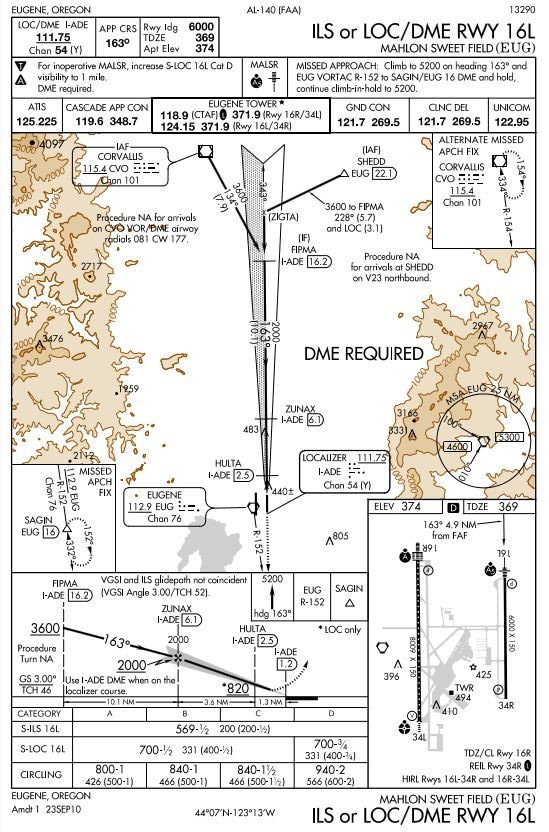
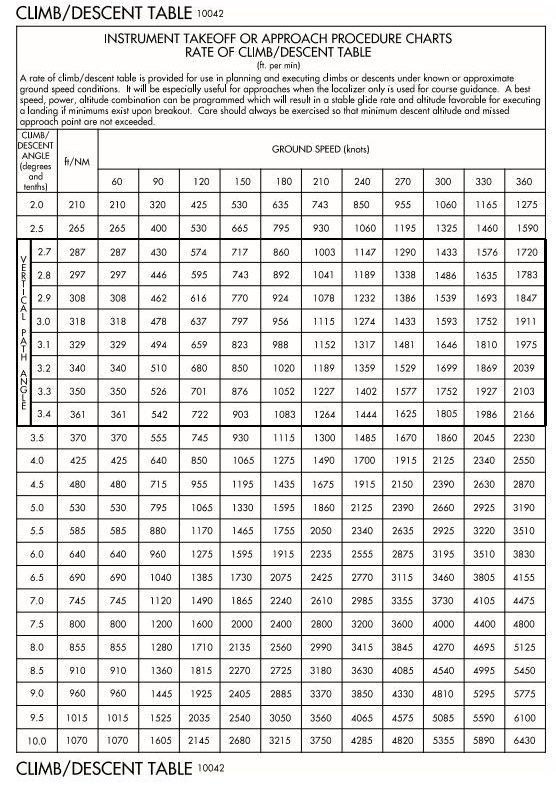 CorrectIncorrect
CorrectIncorrect -
Question 436 of 922
436. Question
Refer to figure 247 and legend 27 below. With a 15 knot headwind while flying the ILS Rwy 9 at RAL with 90 knots, you expect to set power for a
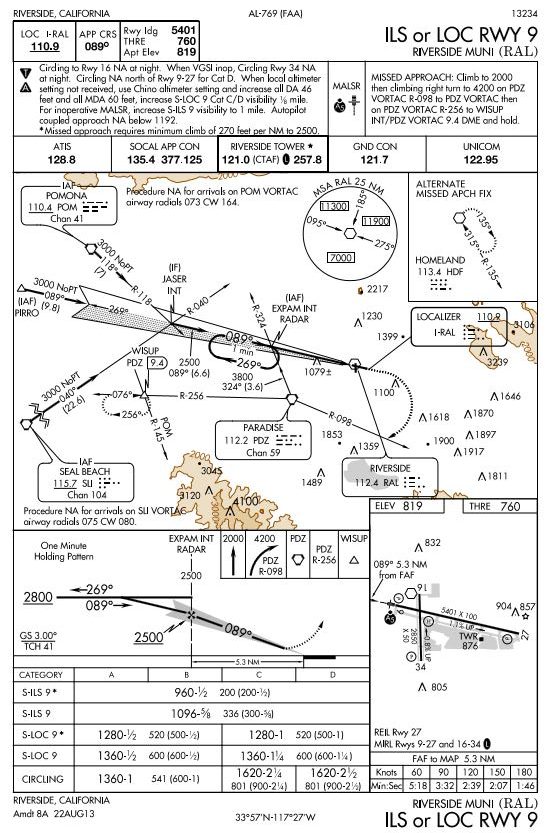
 CorrectIncorrect
CorrectIncorrect -
Question 437 of 922
437. Question
To ensure proper airspace protection while holding at 5,000 feet in a civil aircraft, what is the maximum indicated airspeed a pilot should use?
CorrectIncorrect -
Question 438 of 922
438. Question
Where a holding pattern is specified in lieu of a procedure turn, the holding maneuver must be executed within
CorrectIncorrect -
Question 439 of 922
439. Question
When more than one circuit of the holding pattern is needed to lose altitude or become better established on course, the additional circuits can be
CorrectIncorrect -
Question 440 of 922
440. Question
To ensure proper airspace protection while in a holding pattern above 14,000 feet in a propeller driven airplane, what is the maximum indicated airspeed a pilot should use?
CorrectIncorrect -
Question 441 of 922
441. Question
To ensure proper airspace protection while in a holding pattern above 14,000 feet in a propeller-driven airplane, what is the maximum indicated airspeed a pilot should use?
CorrectIncorrect -
Question 442 of 922
442. Question
The standard IFR climb gradient is
CorrectIncorrect -
Question 443 of 922
443. Question
Refer to figure 116 below. You arrive over the 15 DME fix on a heading of 350°. Which holding pattern correctly complies with the ATC clearance below, and what is the recommended entry procedure? “…HOLD WEST OF THE ONE FIVE DME FIX ON THE TWO SIX EIGHT RADIAL OF THE ABC VORTAC, FIVE MILE LEGS, LEFT TURNS…”
 CorrectIncorrect
CorrectIncorrect -
Question 444 of 922
444. Question
How can an initial approach fix be identified on a Standard Instrument Approach Procedure (SIAP) Chart?
CorrectIncorrect -
Question 445 of 922
445. Question
Which fixes on the IAP Charts are initial approach fixes?
CorrectIncorrect -
Question 446 of 922
446. Question
Aircraft approach categories are based on
CorrectIncorrect -
Question 447 of 922
447. Question
How can the pilot determine, for an ILS runway equipped with MALSR, that there may be a penetration of the obstacle identification surfaces (OIS), and care should be taken in the visual segment to avoid any obstacles?
CorrectIncorrect -
Question 448 of 922
448. Question
Refer to figure 196 below. What is the elevation of the TDZE for RWY 4?
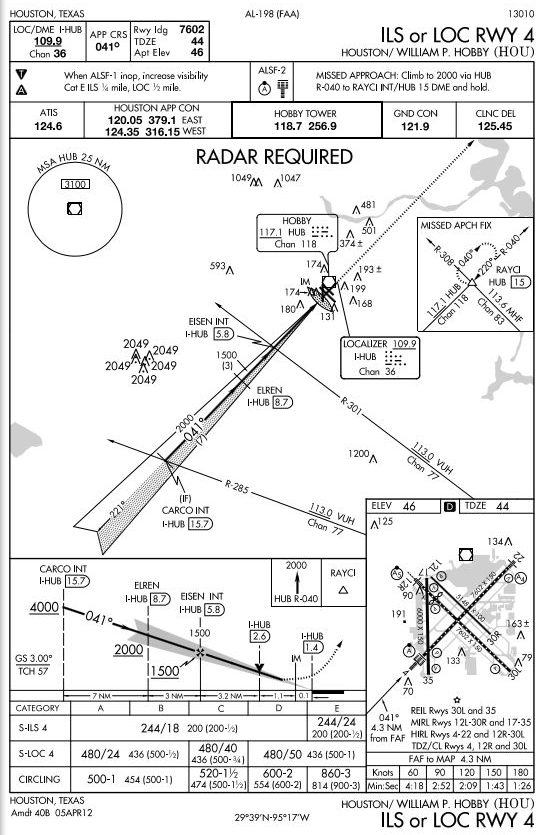 CorrectIncorrect
CorrectIncorrect -
Question 449 of 922
449. Question
Refer to figure 217 below. During the ILS RWY 13 procedure at DSM, what altitude minimum applies if the glide slope becomes inoperative?
 CorrectIncorrect
CorrectIncorrect -
Question 450 of 922
450. Question
Refer to figure 217 below. The symbol on the plan view of the ILS or LOC RWY 13 procedure at DSM represents a minimum safe sector altitude within 25 NM of
 CorrectIncorrect
CorrectIncorrect -
Question 451 of 922
451. Question
Refer to figure 217 below. During the ILS RWY 13 procedures at DSM, the minimum altitude for glide slope interception is
 CorrectIncorrect
CorrectIncorrect -
Question 452 of 922
452. Question
Refer to figure 217 below. During the approach to DSM before you can begin the ILS RWY 13 procedure, the glide slope fails and you are cleared for the LOC RWY 13 at DSM. What altitude minimum applies?
 CorrectIncorrect
CorrectIncorrect -
Question 453 of 922
453. Question
Refer to figure 221 below. The final approach fix for the ILS RWY 24R is located at
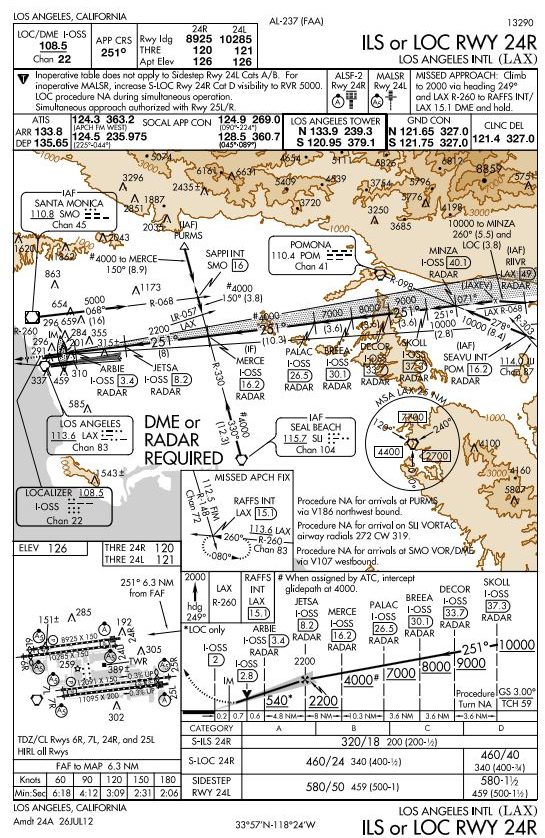 CorrectIncorrect
CorrectIncorrect -
Question 454 of 922
454. Question
Refer to figure 221 below. The final approach fix for the precision approach is located at
 CorrectIncorrect
CorrectIncorrect -
Question 455 of 922
455. Question
During an instrument precision approach, terrain and obstacle clearance depends on adherence to
CorrectIncorrect -
Question 456 of 922
456. Question
When making an instrument approach at the selected alternate airport, what landing minimums apply?
CorrectIncorrect -
Question 457 of 922
457. Question
The primary reason single pilot operations in reduced visibility on an instrument approach procedure are made more difficult than multi-crew operations is that the pilot must
CorrectIncorrect -
Question 458 of 922
458. Question
Refer figure 227 below. Refer to the APA (Centennial) ILS RWY 35R procedure. The FAF intercept altitude is
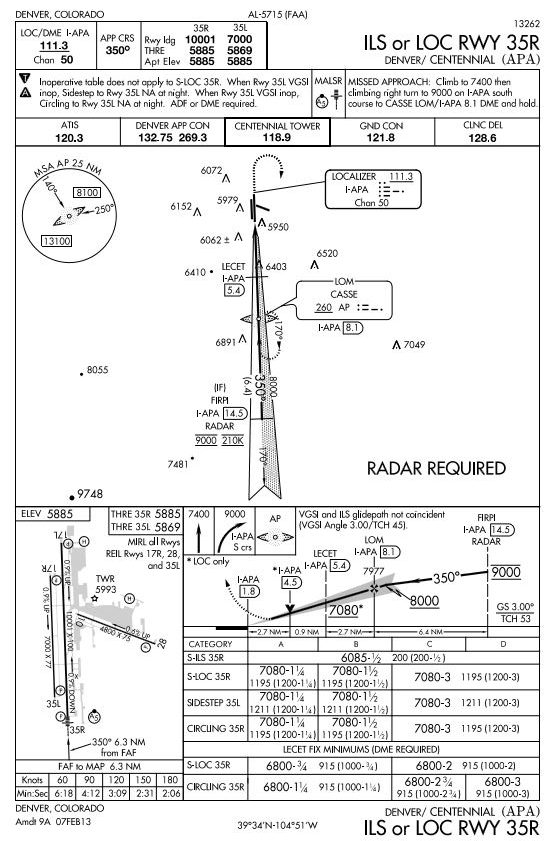 CorrectIncorrect
CorrectIncorrect -
Question 459 of 922
459. Question
Refer to figure 244 below. At what minimum altitude should you cross RAMKE intersection during the S-LA RWY 6 approach at ROA?
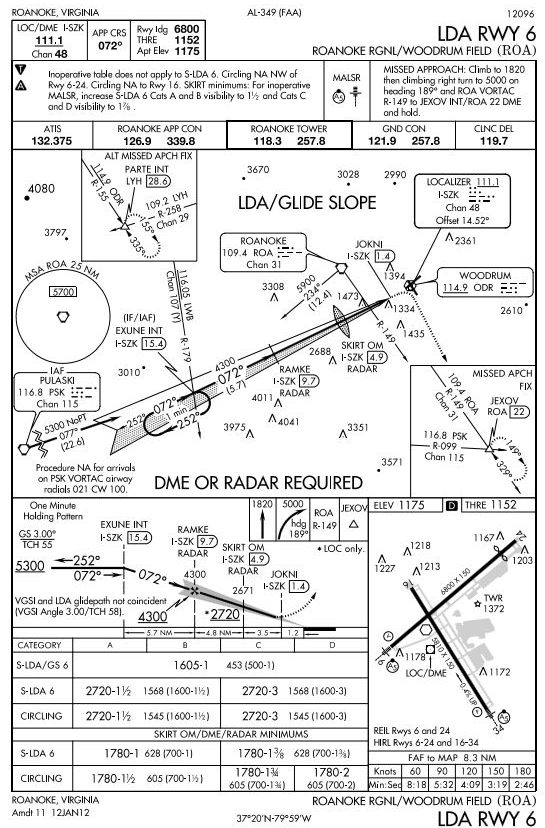 CorrectIncorrect
CorrectIncorrect -
Question 460 of 922
460. Question
Refer to figure 228 below. The missed approach point for the LOC RWY 31 procedure is
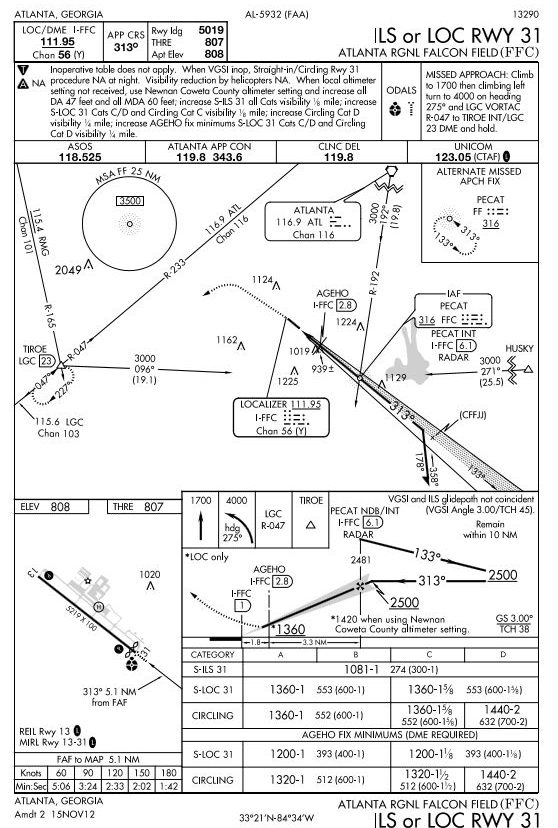 CorrectIncorrect
CorrectIncorrect -
Question 461 of 922
461. Question
When being radar vectored for an ILS approach, at what point may you start a descent from your last assigned altitude to a lower minimum altitude if cleared for the approach?
CorrectIncorrect -
Question 462 of 922
462. Question
What obstacle clearance and navigation signal coverage is a pilot assured with the Minimum Sector Altitudes depicted on the IAP charts?
CorrectIncorrect -
Question 463 of 922
463. Question
Which procedure should be followed by a pilot who is circling to land in a Category B airplane, but is maintaining a speed 5 knots faster than the maximum specified for that category?
CorrectIncorrect -
Question 464 of 922
464. Question
For aircraft other than helicopters, is an alternate airport required for an IFR flight to ATL (Atlanta Hartsfield) if the proposed ETA is 1930Z?
TAF KATL 121720Z 121818 20012KT 5SM HZ BKN030
FM2000 3SM TSRA OVC025CB
FM2200 33015G20KT P6SM BKN015 OVC040
BECMG 0608 02008KT BKN040 BECMG 1012 OOOOOKT
P6SM CLR=
CorrectIncorrect -
Question 465 of 922
465. Question
What are the alternate minimums for an airport with a precision approach procedure?
CorrectIncorrect -
Question 466 of 922
466. Question
When a pilot elects to proceed to the selected alternate airport, which minimums apply for landing at the alternate?
CorrectIncorrect -
Question 467 of 922
467. Question
If a pilot elects to proceed to the selected alternate, the landing minimums used at that airport should be the
CorrectIncorrect -
Question 468 of 922
468. Question
What minimum weather conditions must be forecast for your ETA at an alternate airport, that has only a VOR approach with standard alternate minimums, for the airport to be listed as an alternate on the IFR flight plan?
CorrectIncorrect -
Question 469 of 922
469. Question
Why is hypoxia particularly dangerous during flights with one pilot?
CorrectIncorrect -
Question 470 of 922
470. Question
What action should be taken if hyperventilation is suspected?
CorrectIncorrect -
Question 471 of 922
471. Question
If you experience tunnel vision and cyanosis, you may have symptoms of
CorrectIncorrect -
Question 472 of 922
472. Question
Which is not a type of hypoxia?
CorrectIncorrect -
Question 473 of 922
473. Question
Which of the following is a correct response to counteract the feelings of hypoxia in flight?
CorrectIncorrect -
Question 474 of 922
474. Question
Carbon monoxide poisoning, common in flying as a result of an exhaust leak, is considered what type of hypoxia?
CorrectIncorrect -
Question 475 of 922
475. Question
Hyperventilation occurs when
CorrectIncorrect -
Question 476 of 922
476. Question
A corrective action to overcome symptoms of hyperventilation is to
CorrectIncorrect -
Question 477 of 922
477. Question
The sensations which lead to spatial disorientation during instrument flight conditions
CorrectIncorrect -
Question 478 of 922
478. Question
Which system is most likely responsible for a pilot suffering spatial disorientation?
CorrectIncorrect -
Question 479 of 922
479. Question
A pilot is more subject to spatial disorientation if
CorrectIncorrect -
Question 480 of 922
480. Question
Which procedure is recommended to prevent or overcome spatial disorientation?
CorrectIncorrect -
Question 481 of 922
481. Question
How can an instrument pilot best overcome spatial disorientation?
CorrectIncorrect -
Question 482 of 922
482. Question
How can an instrument pilot best overcome spatial disorientation?
CorrectIncorrect -
Question 483 of 922
483. Question
Abrupt head movement during a prolonged constant rate turn in IMC or simulated instrument conditions can cause
CorrectIncorrect -
Question 484 of 922
484. Question
A rapid acceleration during takeoff can create the illusion of
CorrectIncorrect -
Question 485 of 922
485. Question
An abrupt change from climb to straight-and-level flight can create the illusion of
CorrectIncorrect -
Question 486 of 922
486. Question
A sloping cloud formation, an obscured horizon, and a dark scene spread with ground lights and stars can create an illusion known as
CorrectIncorrect -
Question 487 of 922
487. Question
Abrupt head movement during a prolonged constant rate turn in IMC or simulated instrument conditions can cause
CorrectIncorrect -
Question 488 of 922
488. Question
The sensory system responsible for most of the illusions leading to spatial disorientation is the
CorrectIncorrect -
Question 489 of 922
489. Question
Without visual aid, a pilot often interprets centrifugal force as a sensation of
CorrectIncorrect -
Question 490 of 922
490. Question
Pilots should take care when retrieving charts or dropped objects in the cockpit to avoid
CorrectIncorrect -
Question 491 of 922
491. Question
While making prolonged constant-rate turns under IFR conditions, an abrupt head movement can create the illusion of rotation on an entirely different axis. This is known as
CorrectIncorrect -
Question 492 of 922
492. Question
To preserve night vision, the most appropriate cockpit lighting is
CorrectIncorrect -
Question 493 of 922
493. Question
What effect does haze have on the ability to see traffic or terrain features during flight?
CorrectIncorrect -
Question 494 of 922
494. Question
Which statement is correct regarding the use of cockpit lighting for night flight?
CorrectIncorrect -
Question 495 of 922
495. Question
Which technique should a pilot use to scan for traffic to the right and left during straight-and-level flight?
CorrectIncorrect -
Question 496 of 922
496. Question
Due to visual illusion, when landing on a narrower-than-usual runway, the aircraft will appear to be
CorrectIncorrect -
Question 497 of 922
497. Question
What visual illusion creates the same effect as a narrower-than-usual runway?
CorrectIncorrect -
Question 498 of 922
498. Question
Why is fatigue hazardous to flight safety?
CorrectIncorrect -
Question 499 of 922
499. Question
For aircraft other than helicopters, what minimum weather conditions must be forecast for your ETA at an alternate airport that has a precision approach procedure, with standard alternate minimums, in order to list it as an alternate for the IFR flight?
CorrectIncorrect -
Question 500 of 922
500. Question
For an airplane, determine the weather minimum conditions required at the destination airport to avoid listing an alternate on your IFR flight plan.
CorrectIncorrect -
Question 501 of 922
501. Question
What are the minimum weather conditions that must be forecast to list an airport as an alternate when the airport has no approved IAP?
CorrectIncorrect -
Question 502 of 922
502. Question
What standard minimums are required to list an airport as an alternate on an IFR flight plan if the airport has VOR approach only?
CorrectIncorrect -
Question 503 of 922
503. Question
An airport without an authorized IAP may be included on an IFT flight plan as an alternate, if the current weather forecast indicates that the ceiling and visibility at the ETA will
CorrectIncorrect -
Question 504 of 922
504. Question
When an alternate airport is required, what are the weather minimums that must be forecast at the ETA for an alternate airport that has a precision approach procedure?
CorrectIncorrect -
Question 505 of 922
505. Question
What is the maximum tolerance allowed for an operational VOR equipment check when using a VOT?
CorrectIncorrect -
Question 506 of 922
506. Question
What record shall be made in the aircraft log or other permanent record by the pilot making the VOR operational check?
CorrectIncorrect -
Question 507 of 922
507. Question
When must an operational check on the aircraft VOR equipment be accomplished when used to operate under IFR?
CorrectIncorrect -
Question 508 of 922
508. Question
Which data must be recorded in the aircraft log or other appropriate log by a pilot making a VOR operational check for IFR operations?
CorrectIncorrect -
Question 509 of 922
509. Question
Which checks and inspections of flight instruments or instrument systems must be accomplished before an aircraft can be flown under IFR?
CorrectIncorrect -
Question 510 of 922
510. Question
When departing from an airport located outside controlled airspace during IMC, you must file an IFR flight plan and receive a clearance before
CorrectIncorrect -
Question 511 of 922
511. Question
To operate an aircraft under IFR, a flight plan must have been filed and an ATC clearance received prior to
CorrectIncorrect -
Question 512 of 922
512. Question
To operate under IFR below 18,000 feet, a pilot must file an IFR flight plan and receive an appropriate ATC clearance prior to
CorrectIncorrect -
Question 513 of 922
513. Question
Prior to which operation must an IFR flight plan be filed and an appropriate ATC clearance received?
CorrectIncorrect -
Question 514 of 922
514. Question
No person may operate an aircraft in controlled airspace under IFR unless he or she files a flight plan
CorrectIncorrect -
Question 515 of 922
515. Question
Except when necessary for takeoff or landing or unless otherwise authorized by the Administrator, the minimum altitude for IFR flight is
CorrectIncorrect -
Question 516 of 922
516. Question
Unless otherwise prescribed, what is the rule regarding altitude and course to be maintained during an IFR off airways flight over mountainous terrain?
CorrectIncorrect -
Question 517 of 922
517. Question
What minimum navigation equipment is required for IFR flight?
CorrectIncorrect -
Question 518 of 922
518. Question
An aircraft operated during IFR under 14 CFR Part 91 is required to have which of the following?
CorrectIncorrect -
Question 519 of 922
519. Question
Aircraft being operated under IFR are required to have, in addition to the equipment required for VFR and night, at least
CorrectIncorrect -
Question 520 of 922
520. Question
Where is DME required under IFR?
CorrectIncorrect -
Question 521 of 922
521. Question
To meet the requirements for flight under IFR, an aircraft must be equipped with certain operable instruments and equipment. One of those required is
CorrectIncorrect -
Question 522 of 922
522. Question
What is the oxygen requirement for an unpressurized aircraft at 15,000 feet?
CorrectIncorrect -
Question 523 of 922
523. Question
What is the maximum IFR altitude you may fly in an unpressurized aircraft without providing passengers with supplemental oxygen?
CorrectIncorrect -
Question 524 of 922
524. Question
What is the maximum cabin pressure altitude at which a pilot can fly for longer than 30 minutes without using supplemental oxygen?
CorrectIncorrect -
Question 525 of 922
525. Question
If an unpressurized aircraft is operated above 1 2, 500 feet MSL, but not more than 14,000 feet MSL, for a period of 2 hours 20 minutes, how long during that time is the minimum flightcrew required to use supplemental oxygen?
CorrectIncorrect -
Question 526 of 922
526. Question
In the 48 contiguous states, excluding the airspace at or below 2,500 feet AGL, an operable coded transponder equipped with Mode C capability is required in all controlled airspace at and above
CorrectIncorrect -
Question 527 of 922
527. Question
A coded transponder equipped with altitude reporting capability is required in all controlled airspace
CorrectIncorrect -
Question 528 of 922
528. Question
Prior to operating an aircraft not equipped with a transponder in Class B airspace, a request for a deviation must be submitted to the
CorrectIncorrect -
Question 529 of 922
529. Question
When an aircraft is not equipped with a transponder, what requirement must be met before ATC will authorize a flight within Class B airspace?
CorrectIncorrect -
Question 530 of 922
530. Question
If the aircraft’s transponder fails during flight within Class B airspace,
CorrectIncorrect -
Question 531 of 922
531. Question
Your aircraft had the static pressure system and altimeter tested and inspected on January 5, of this year, and was found to comply with FAA standards. These systems must be reinspected and approved for use in controlled airspace under IFR by
CorrectIncorrect -
Question 532 of 922
532. Question
An aircraft altimeter system test and inspection must be accomplished within
CorrectIncorrect -
Question 533 of 922
533. Question
An aircraft altimeter system test and inspection are required to be accomplished within
CorrectIncorrect -
Question 534 of 922
534. Question
Which publication covers the procedures required for aircraft accident and incident reporting responsibilities for pilots?
CorrectIncorrect -
Question 535 of 922
535. Question
The primary reason single pilot operations in reduced visibility on an instrument approach procedure are made more difficult than multicrew operations is that the pilot must
CorrectIncorrect -
Question 536 of 922
536. Question
When simultaneous approaches are in progress, how does each pilot receive radar advisories?
CorrectIncorrect -
Question 537 of 922
537. Question
When may a pilot make a straight-in landing, if using an IAP having only circling minimums?
CorrectIncorrect -
Question 538 of 922
538. Question
Refer to figure 230 below. What minimum navigation equipment is required to complete the VOR/DME-A procedure?
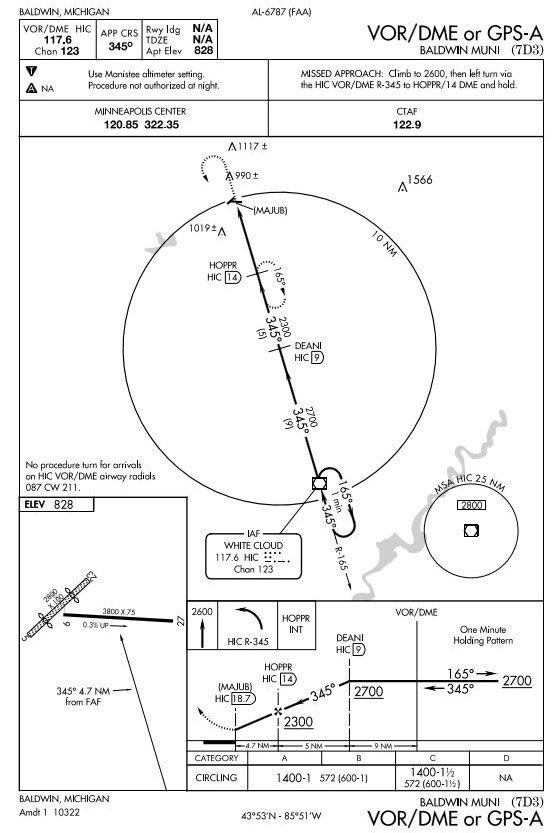 CorrectIncorrect
CorrectIncorrect -
Question 539 of 922
539. Question
Refer to figure 230 below. The minimum safe altitude (MSA) for the VOR/DME or GPS-A at 7D3 is geographically centered on what position?
 CorrectIncorrect
CorrectIncorrect -
Question 540 of 922
540. Question
Refer to figure 231 and figure 230 below. You plan to fly to Baldwin for Christmas. What minimum equipment is required for the VOR/ DME or GPS-A procedure, and can you complete the flight?
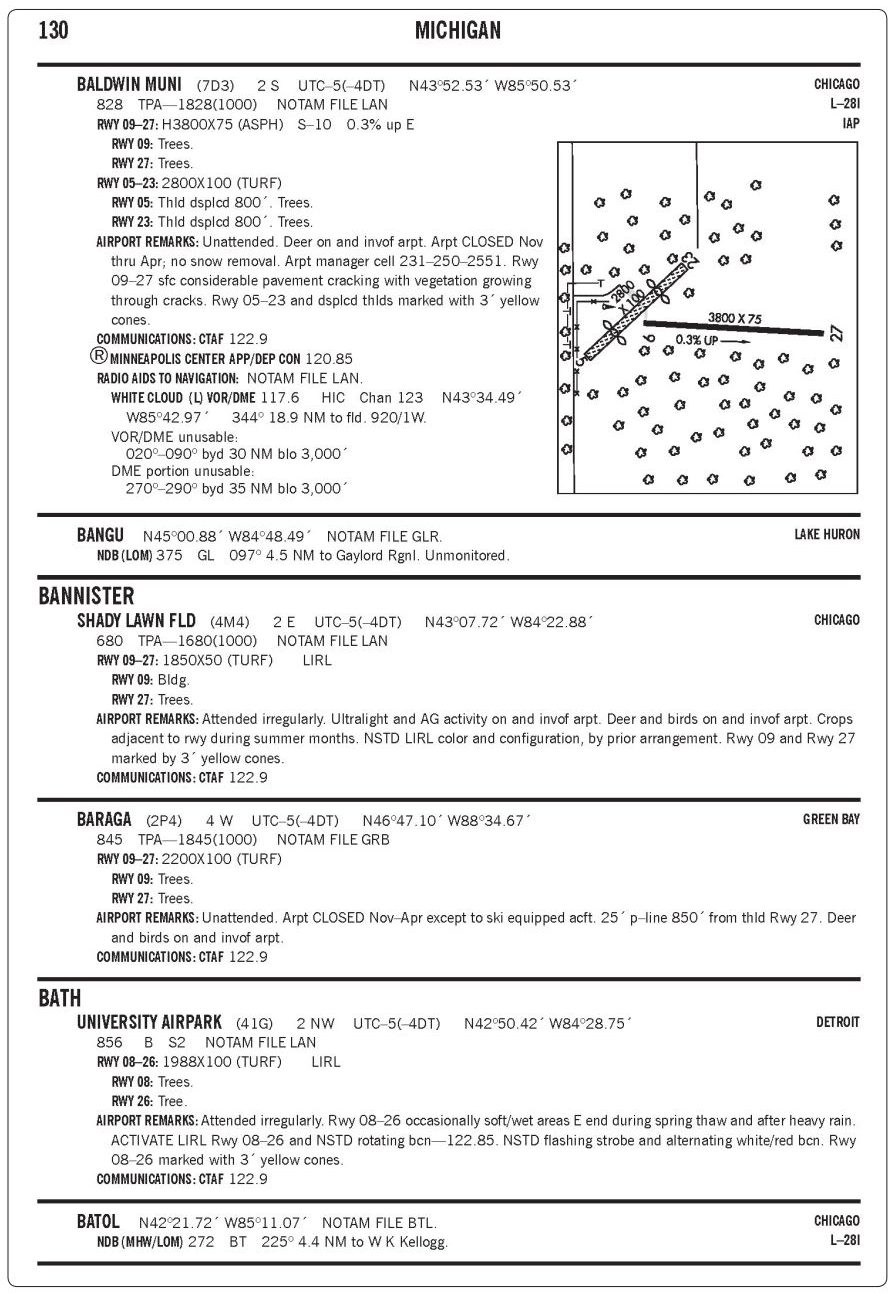
 CorrectIncorrect
CorrectIncorrect -
Question 541 of 922
541. Question
An airport may not be qualified for alternate use if
CorrectIncorrect -
Question 542 of 922
542. Question
During an instrument approach, under what conditions, if any, is the holding pattern course reversal not required?
CorrectIncorrect -
Question 543 of 922
543. Question
Refer to figure 234 below. What options are available concerning the teardrop course reversal for LOC RWY 18 approach to Lincoln?
 CorrectIncorrect
CorrectIncorrect -
Question 544 of 922
544. Question
Refer to figure 234 below. If your aircraft was cleared for the ILS RWY 18 at Lincoln Municipal and crossed the Lincoln VORTAC at 5,000 feet MSL, at what point in the teardrop could a descent to 3,200 feet commence?
 CorrectIncorrect
CorrectIncorrect -
Question 545 of 922
545. Question
Refer to figure 234 below. If cleared for an S-LOC 18 approach at Lincoln Municipal from over HUSKR, it means the flight should
 CorrectIncorrect
CorrectIncorrect -
Question 546 of 922
546. Question
On a nonprecision approach, what is the maximum acceptable descent rate during the final stages of the approach (below 1,000 ft. AGL)?
CorrectIncorrect -
Question 547 of 922
547. Question
Under the stabilized approach concept, what is the maximum acceptable descent rate during the final stages of an approach?
CorrectIncorrect -
Question 548 of 922
548. Question
When the approach procedure involves a procedure turn, the maximum speed should not be greater than
CorrectIncorrect -
Question 549 of 922
549. Question
Refer to figure 236 below. What landing minimums apply for a 14 CFR Part 91 operator at Dothan, AL using a category C aircraft during a circling LOC 32 approach at 120 knots? (Dual VORs available.)
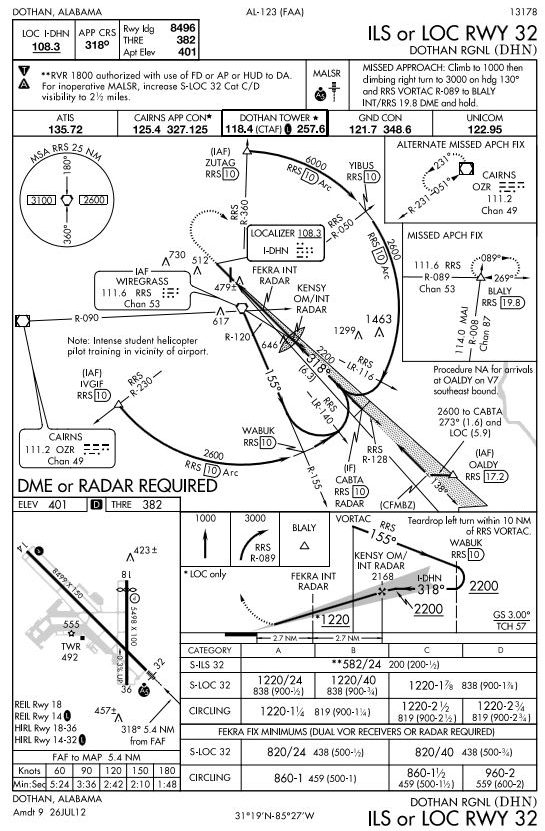 CorrectIncorrect
CorrectIncorrect -
Question 550 of 922
550. Question
Refer to figure 236 below. If cleared for a straight-in LOC approach from over OALDY, it means the flight should
 CorrectIncorrect
CorrectIncorrect -
Question 551 of 922
551. Question
Refer to figure 242 below. What indication should you get when it is time to turn in bound while in the procedure turn at FEHXE?
 CorrectIncorrect
CorrectIncorrect -
Question 552 of 922
552. Question
Refer to figure 242 below. What is the recommended descent angle for the RNAV (GPS) RWY 36 approach?
 CorrectIncorrect
CorrectIncorrect -
Question 553 of 922
553. Question
Refer to figure 242 below. How should the missed approach point be identified when executing the RNAV (GPS) RWY 36 approach at Adams Field?
 CorrectIncorrect
CorrectIncorrect -
Question 554 of 922
554. Question
Refer to figure 242 the diagram below. What minimum airborne equipment is required to be operative for RNAV (GPS) RWY 36 approach at Adams Field?
 CorrectIncorrect
CorrectIncorrect -
Question 555 of 922
555. Question
Refer to figure 242 below. What type of entry is recommended to the missed approach holding pattern if the inbound heading is 050°?
 CorrectIncorrect
CorrectIncorrect -
Question 556 of 922
556. Question
Refer to figure 242 and legend 27 below. You have been cleared for the RNAV (GPS) RWY 36 approach to LIT. At a groundspeed of 105 knots. What are the vertical descent angle and rate of descent on final approach?

 CorrectIncorrect
CorrectIncorrect -
Question 557 of 922
557. Question
Refer to figure 240 below. What type entry is recommended for the missed approach holding pattern depicted on the VOR/DME RWY 36 approach chart for Price/Carbon County Airport?
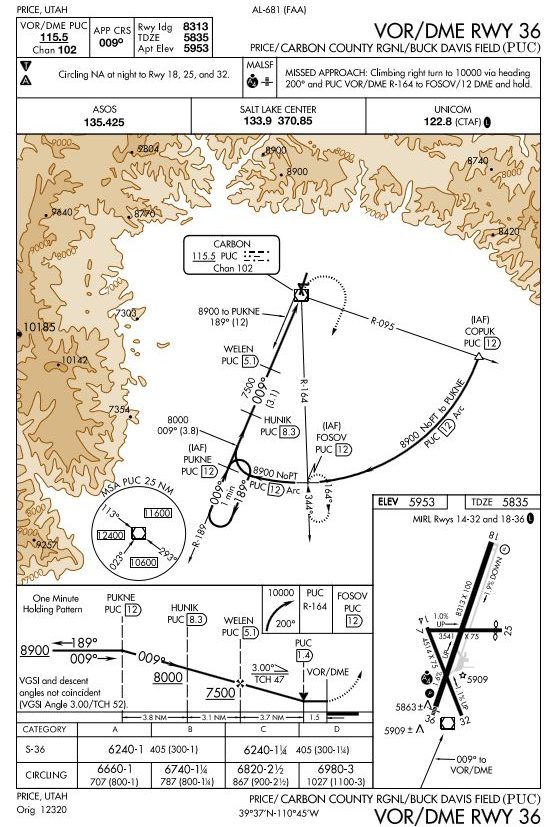 CorrectIncorrect
CorrectIncorrect -
Question 558 of 922
558. Question
Refer to figure 240 below. At which points may you initiate a descent to the next lower minimum altitude when cleared for the VOR/DME RWY 36 approach, from the PUC R-095 IAF (DME operative)?
 CorrectIncorrect
CorrectIncorrect -
Question 559 of 922
559. Question
Refer to figure 240 below. What is the purpose of the 10,600 MSA on the Price/Carbon County Airport Approach Chart?
 CorrectIncorrect
CorrectIncorrect -
Question 560 of 922
560. Question
Refer to figure 240 below. If the DME at PUC airport is inoperative, the airborne DME will
 CorrectIncorrect
CorrectIncorrect -
Question 561 of 922
561. Question
What does the symbol T within a black triangle in the minimums section of the IAP for a particular airport indicate?
CorrectIncorrect -
Question 562 of 922
562. Question
While being radar vectored, an approach clearance is received. The last assigned altitude should be maintained until
CorrectIncorrect -
Question 563 of 922
563. Question
If the plan view on an approach chart does not include a procedure turn barb, that means
CorrectIncorrect -
Question 564 of 922
564. Question
Refer to figure 247 below. How should a pilot reverse course to get established on the in bound course of the ILS RWY 9, if radar vectoring to EXPAM?
 CorrectIncorrect
CorrectIncorrect -
Question 565 of 922
565. Question
Refer to figure 247 below. What is the minimum altitude descent procedure if cleared for the S ILS 9 approach from Seal Beach VORTAC?
 CorrectIncorrect
CorrectIncorrect -
Question 566 of 922
566. Question
Refer to figure 175 and figure 174 below. At which point does the JEN.JEN9 arrival begin?
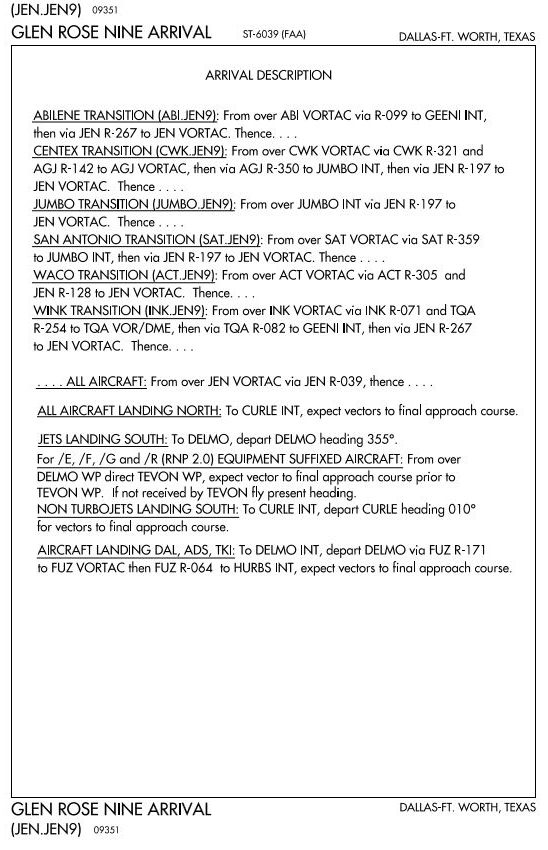
 CorrectIncorrect
CorrectIncorrect -
Question 567 of 922
567. Question
Refer to figure 209 and figure 208 below. At which location or condition does the STELA.STELA1 arrival begin?
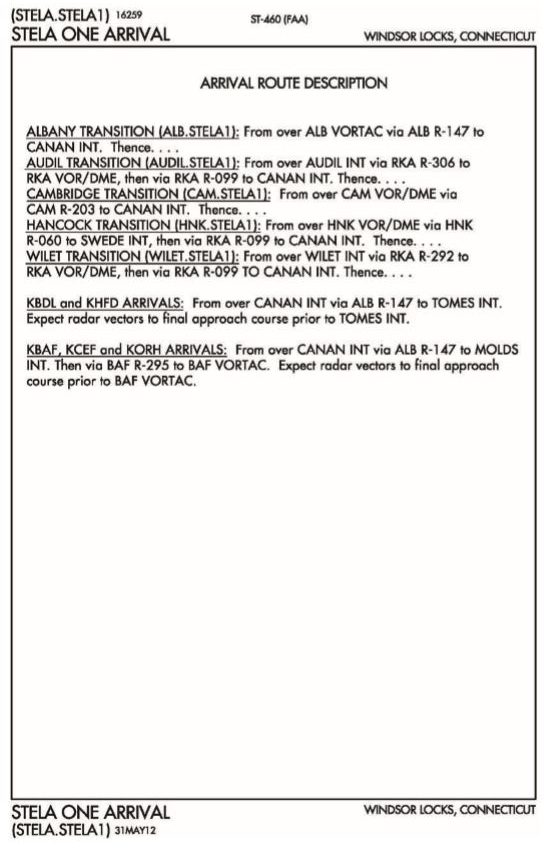
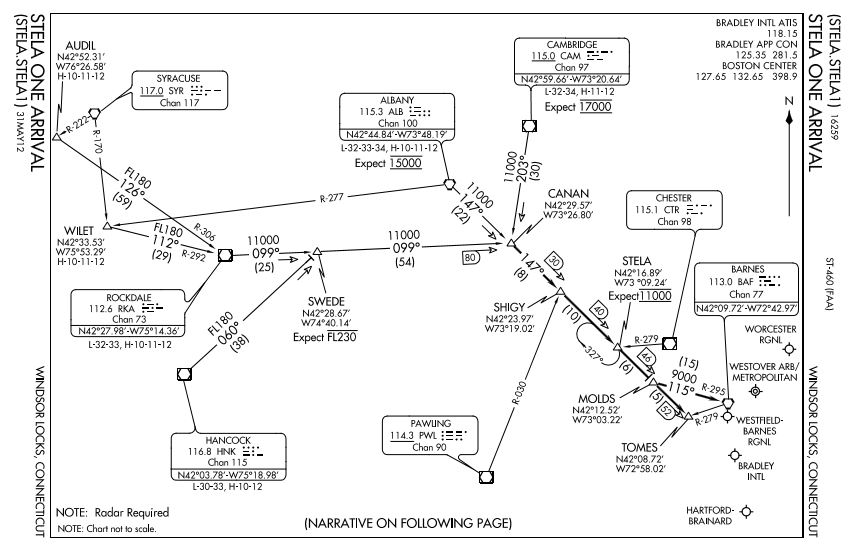 CorrectIncorrect
CorrectIncorrect -
Question 568 of 922
568. Question
Preferred IFR routes beginning with a fix, indicate that departing aircraft will normally be routed to the fix by
CorrectIncorrect -
Question 569 of 922
569. Question
Which procedure applies to instrument departure procedures?
CorrectIncorrect -
Question 570 of 922
570. Question
Which is true regarding the use of an instrument departure procedure chart?
CorrectIncorrect -
Question 571 of 922
571. Question
Which is true regarding STARs?
CorrectIncorrect -
Question 572 of 922
572. Question
Refer to figure 211 below. For takeoff on RWY 9 using an average groundspeed of 140 knots, what minimum rate of climb would meet the required minimum rate of climb as specified on the instrument departure procedure?
 CorrectIncorrect
CorrectIncorrect -
Question 573 of 922
573. Question
Which clearance procedures may be issued by ATC without prior pilot request?
CorrectIncorrect -
Question 574 of 922
574. Question
ATC can issue a STAR
CorrectIncorrect -
Question 575 of 922
575. Question
Which of the following statements regarding STARs is most accurate?
CorrectIncorrect -
Question 576 of 922
576. Question
What action is recommended if a pilot does not wish to use an instrument departure procedure?
CorrectIncorrect -
Question 577 of 922
577. Question
A particular instrument departure procedure requires a minimum climb rate of 210 feet per NM to 8,000 feet. If you climb with a ground speed of 140 knots, what is the rate of climb required in feet per minute?
CorrectIncorrect -
Question 578 of 922
578. Question
On a GPS with WAAS capability, what is the significance of “LNAV+V” being displayed?
CorrectIncorrect -
Question 579 of 922
579. Question
When flying a GPS approach procedure, what effect will overriding an automatically selected sensitivity have?
CorrectIncorrect -
Question 580 of 922
580. Question
When proper RAIM sensitivity is not available, manually resetting sensitivity to 0.3 NM will
CorrectIncorrect -
Question 581 of 922
581. Question
Refer to figure 238 below. If cleared for the RNAV (GPS) RWY 28 approach (Lancaster/Fairfield) over APE VORTAC, what will ATC expect of you?
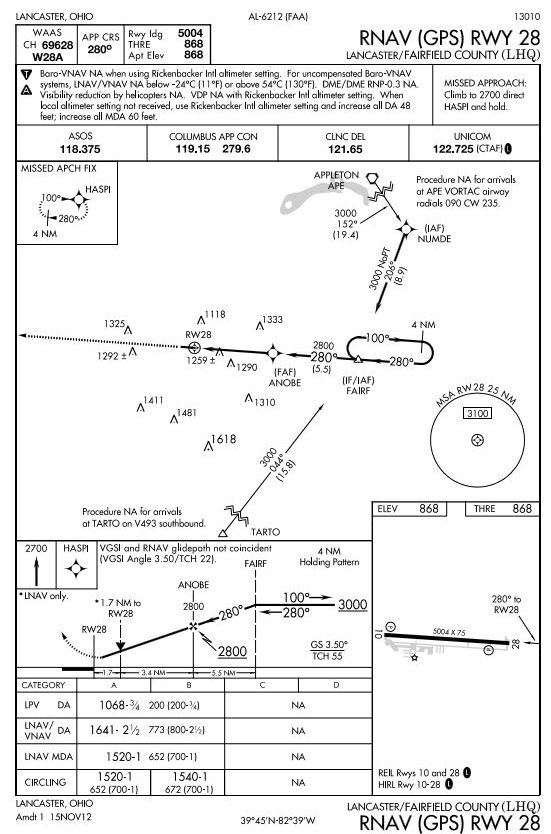 CorrectIncorrect
CorrectIncorrect -
Question 582 of 922
582. Question
If Receiver Autonomous Integrity Monitoring (RAIM} is not available prior to beginning a GPS approach, the pilot should
CorrectIncorrect -
Question 583 of 922
583. Question
Refer to figure 249 below. When flying the LNAV approach, the missed approach point (MAP) would be indicated by reaching
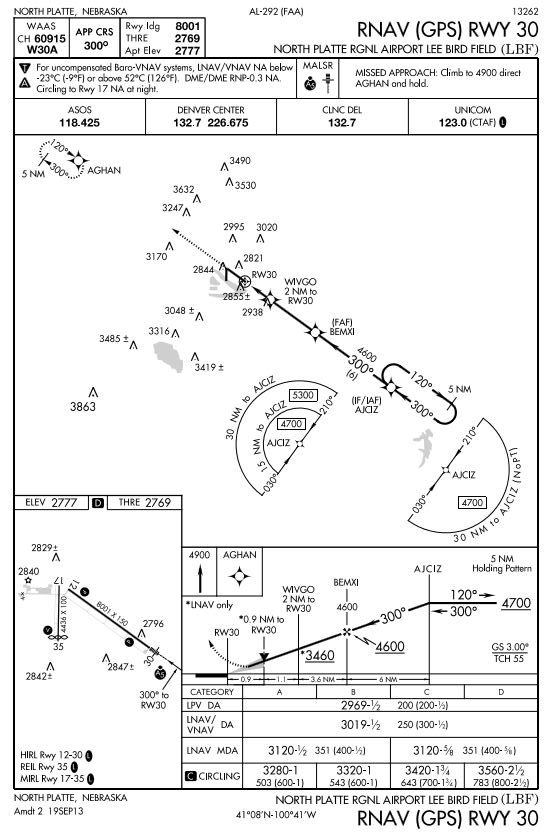 CorrectIncorrect
CorrectIncorrect -
Question 584 of 922
584. Question
Refer to figure 249 below. Which of the following best described BEMXI?
 CorrectIncorrect
CorrectIncorrect -
Question 585 of 922
585. Question
Refer to figure 249 below. How do you recognize the missed approach point on the LNAV VNAV approach?
 CorrectIncorrect
CorrectIncorrect -
Question 586 of 922
586. Question
Which of the following is true concerning GPS approaches?
CorrectIncorrect -
Question 587 of 922
587. Question
Refer to figure 249 below. The correct GPS entry when told by ATC to “expect the GPS approach to runway 30” is
 CorrectIncorrect
CorrectIncorrect -
Question 588 of 922
588. Question
Refer to figure 249 below. Which type of waypoint is the AGHAN fix?
 CorrectIncorrect
CorrectIncorrect -
Question 589 of 922
589. Question
Refer to figure 249 below. You are flying the RNAV(GPS} RWY 30 approach to LBF, over BEMXI, and you receive a RAIM error. You should
 CorrectIncorrect
CorrectIncorrect -
Question 590 of 922
590. Question
Refer to figure 249 below. At what point is the pilot authorized to descend below 5,300 feet when cleared to the AJCIZ waypoint from the west?
 CorrectIncorrect
CorrectIncorrect -
Question 591 of 922
591. Question
During a WMS GPS approach, you receive an LNAV+V annunciation on the GPS display. You should
CorrectIncorrect -
Question 592 of 922
592. Question
When using GPS for navigation and instrument approaches, any required alternate airport must have
CorrectIncorrect -
Question 593 of 922
593. Question
The primary cause of all changes in the Earth’s weather is
CorrectIncorrect -
Question 594 of 922
594. Question
Which force, in the Northern Hemisphere, acts at a right angle to the wind and deflects it to the right until parallel to the isobars?
CorrectIncorrect -
Question 595 of 922
595. Question
What relationship exists between the winds at 2,000 feet above the surface and the surface winds?
CorrectIncorrect -
Question 596 of 922
596. Question
Winds at 5,000 feet AGL on a particular flight are southwesterly while most of the surface winds are southerly. This difference in direction is primarily due to
CorrectIncorrect -
Question 597 of 922
597. Question
What causes surface winds to flow across the isobars at an angle rather than parallel to the isobars?
CorrectIncorrect -
Question 598 of 922
598. Question
An air mass is a body of air that
CorrectIncorrect -
Question 599 of 922
599. Question
A characteristic of the stratosphere is
CorrectIncorrect -
Question 600 of 922
600. Question
A jet stream is defined as wind of
CorrectIncorrect -
Question 601 of 922
601. Question
The average height of the troposphere in the middle latitudes is
CorrectIncorrect -
Question 602 of 922
602. Question
The strength and location of the jet stream is normally
CorrectIncorrect -
Question 603 of 922
603. Question
Which feature is associated with the tropopause?
CorrectIncorrect -
Question 604 of 922
604. Question
What is the definition of MEA?
CorrectIncorrect -
Question 605 of 922
605. Question
The lowest published altitude which meets obstacle clearance requirements and assures acceptable navigational signal coverage is the
CorrectIncorrect -
Question 606 of 922
606. Question
Reception of signals from an off-airway radio facility may be inadequate to identify the fix at the designated MEA. In this case, which altitude is designated for the fix?
CorrectIncorrect -
Question 607 of 922
607. Question
Reception of signals from a radio facility, located off the airway being flown, may be inadequate at the designated MEA to identify the fix. In this case, which altitude is designated for the fix?
CorrectIncorrect -
Question 608 of 922
608. Question
ATC may assign the MOCA when certain special conditions exist, and when within
CorrectIncorrect -
Question 609 of 922
609. Question
Acceptable navigational signal coverage at the MOCA is assured for a distance from the VOR of only
CorrectIncorrect -
Question 610 of 922
610. Question
Military training routes (MTR) above 1,500 feet are depicted on
CorrectIncorrect -
Question 611 of 922
611. Question
The altitude that provides acceptable navigational signal coverage for the route, and meets obstacle clearance requirements is the minimum:
CorrectIncorrect -
Question 612 of 922
612. Question
Which condition is guaranteed for all of the following altitude limits: MAA, MCA, MRA, MOCA, and MEA? (Non-mountainous area.)
CorrectIncorrect -
Question 613 of 922
613. Question
If no MCA is specified, what is the lowest altitude for crossing a radio fix, beyond which a higher minimum applies?
CorrectIncorrect -
Question 614 of 922
614. Question
In the case of operations over an area designated as a mountainous area, no person may operate an aircraft under IFR below 2,000 feet above the highest obstacle within a horizontal distance of
CorrectIncorrect -
Question 615 of 922
615. Question
In the case of operations over an area designated as a mountainous area where no other minimum altitude is prescribed, no person may operate an aircraft under IFR below an altitude of
CorrectIncorrect -
Question 616 of 922
616. Question
MEA is an altitude that assures
CorrectIncorrect -
Question 617 of 922
617. Question
Unless otherwise specified on the chart, the minimum en route altitude along a jet route is
CorrectIncorrect -
Question 618 of 922
618. Question
Under which of the following circumstances will ATC issue a VFR restriction to an IFR flight?
CorrectIncorrect -
Question 619 of 922
619. Question
What altitude may a pilot on an IFR flight plan select upon receiving a VFR-on-Top clearance?
CorrectIncorrect -
Question 620 of 922
620. Question
Which rules apply to the pilot in command when operating on a VFR-on-Top clearance?
CorrectIncorrect -
Question 621 of 922
621. Question
Which ATC clearance should instrument-rated pilots request in order to climb through a cloud layer or an area of reduced visibility and then continue the flight VFR?
CorrectIncorrect -
Question 622 of 922
622. Question
When can a VFR-on-Top clearance be assigned by ATC?
CorrectIncorrect -
Question 623 of 922
623. Question
When must a pilot fly at a cardinal altitude plus 500 feet on an IFR flight plan?
CorrectIncorrect -
Question 624 of 922
624. Question
Where are VFR-on-Top operations prohibited?
CorrectIncorrect -
Question 625 of 922
625. Question
What minimums must be considered in selecting an altitude when operating with a VFR-on-Top clearance?
CorrectIncorrect -
Question 626 of 922
626. Question
When operating under IFR with a VFR-On-Top clearance, what altitude should be maintained?
CorrectIncorrect -
Question 627 of 922
627. Question
In which airspace is VFR-on-Top operation prohibited?
CorrectIncorrect -
Question 628 of 922
628. Question
What reports are required of a flight operating on an IFR clearance specifying VFR on Top in a nonradar environment?
CorrectIncorrect -
Question 629 of 922
629. Question
When on a VFR-on-Top clearance, the cruising altitude is based on
CorrectIncorrect -
Question 630 of 922
630. Question
You have filed an IFR flight plan with a VFR on-Top clearance in lieu of an assigned altitude. If you receive this clearance and fly a course of
180°, at what altitude should you fly? (Assume VFR
conditions.)CorrectIncorrect -
Question 631 of 922
631. Question
What cruising altitude is appropriate for VFR on Top on a westbound flight below 18,000 feet?
CorrectIncorrect -
Question 632 of 922
632. Question
If, while in Class E airspace, a clearance is received to “maintain VFR conditions on top,” the pilot should maintain a VFR cruising altitude based on the direction of the
CorrectIncorrect -
Question 633 of 922
633. Question
You are flying on an IFR flight plan at 5,500 feet with a VFR-on-top clearance when you encounter icing. You know there is clear air above and you request 9,500 feet from ATC. They deny the request, but give you 7,500 feet. Are you still VFR-on-top?
CorrectIncorrect -
Question 634 of 922
634. Question
You encounter structural icing on an IFR flight plan at 7,000 feet. Your request for 9,000 feet is rejected by ATC. You request VFR-on-top at 7,500 feet, which is granted. What must you do with your IFR flight plan?
CorrectIncorrect -
Question 635 of 922
635. Question
ATC has approved your request for VFR-on-top while on an IFR clearance. Therefore, you
CorrectIncorrect -
Question 636 of 922
636. Question
Refer to figure 89 below. What type airspace exists above Bryce Canyon Airport from the surface to 1,200 feet AGL?
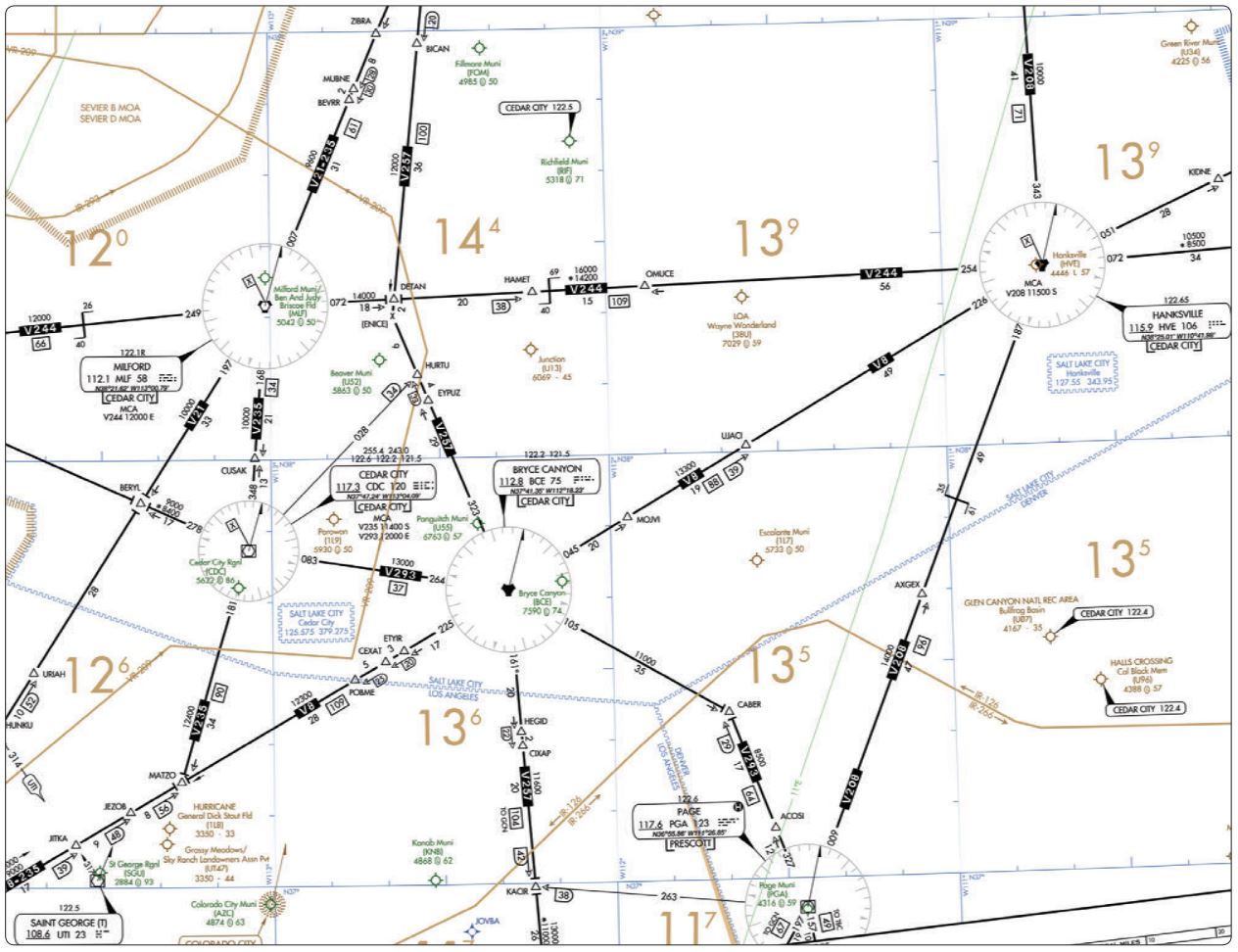 CorrectIncorrect
CorrectIncorrect -
Question 637 of 922
637. Question
Refer to figure 90 and figure 89 below. What is your relationship to the airway while en route from BCE VORTAC to HVE VORTAC on VB?

 CorrectIncorrect
CorrectIncorrect -
Question 638 of 922
638. Question
Which weather phenomenon is always associated with the passage of a frontal system?
CorrectIncorrect -
Question 639 of 922
639. Question
Which is a characteristic of low-level wind shear as it relates to frontal activity?
CorrectIncorrect -
Question 640 of 922
640. Question
Frontal waves normally form on
CorrectIncorrect -
Question 641 of 922
641. Question
Where do squall lines most often develop?
CorrectIncorrect -
Question 642 of 922
642. Question
When compared to winds at the surface, winds at 2,000 feet are
CorrectIncorrect -
Question 643 of 922
643. Question
Which are characteristics of an unstable cold air mass moving over a warm surface?
CorrectIncorrect -
Question 644 of 922
644. Question
What are the characteristics of stable air?
CorrectIncorrect -
Question 645 of 922
645. Question
What type clouds can be expected when an unstable air mass is forced to ascend a mountain slope?
CorrectIncorrect -
Question 646 of 922
646. Question
Which is a characteristic of stable air?
CorrectIncorrect -
Question 647 of 922
647. Question
The general characteristics of unstable air are
CorrectIncorrect -
Question 648 of 922
648. Question
What type of clouds will be formed if very stable moist air is forced up slope?
CorrectIncorrect -
Question 649 of 922
649. Question
Steady precipitation, in contrast to showers, preceding a front is an indication of
CorrectIncorrect -
Question 650 of 922
650. Question
What enhances the growth rate of precipitation?
CorrectIncorrect -
Question 651 of 922
651. Question
Which of the following combinations of weather producing variables would likely result in cumuliform-type clouds, good visibility, rain showers, and possible clear-type icing in clouds?
CorrectIncorrect -
Question 652 of 922
652. Question
What determines the structure or type of clouds which form as a result of air being forced to ascend?
CorrectIncorrect -
Question 653 of 922
653. Question
Stability can be determined from which measurement of the atmosphere?
CorrectIncorrect -
Question 654 of 922
654. Question
What are some characteristics of unstable air?
CorrectIncorrect -
Question 655 of 922
655. Question
Unsaturated air flowing up slope will cool at the rate of approximately (dry adiabatic lapse rate)
CorrectIncorrect -
Question 656 of 922
656. Question
What feature is associated with a temperature inversion?
CorrectIncorrect -
Question 657 of 922
657. Question
Which weather conditions should be expected beneath a low-level temperature inversion layer when the relative humidity is high?
CorrectIncorrect -
Question 658 of 922
658. Question
A common type of ground or surface based temperature inversion is that which is produced by
CorrectIncorrect -
Question 659 of 922
659. Question
A temperature inversion will normally form only
CorrectIncorrect -
Question 660 of 922
660. Question
Which conditions are favorable for the formation of radiation fog?
CorrectIncorrect -
Question 661 of 922
661. Question
What situation is most conducive to the formation of radiation fog?
CorrectIncorrect -
Question 662 of 922
662. Question
The most frequent type of ground- or surface-based temperature inversion is that produced by
CorrectIncorrect -
Question 663 of 922
663. Question
What types of fog depend upon a wind in order to exist?
CorrectIncorrect -
Question 664 of 922
664. Question
Which weather condition can be expected when moist air flows from a relatively warm surface to a colder surface?
CorrectIncorrect -
Question 665 of 922
665. Question
Fog is usually prevalent in industrial areas because of
CorrectIncorrect -
Question 666 of 922
666. Question
In what localities is advection fog most likely to occur?
CorrectIncorrect -
Question 667 of 922
667. Question
In which situation is advection fog most likely to form?
CorrectIncorrect -
Question 668 of 922
668. Question
Under which condition does advection fog usually form?
CorrectIncorrect -
Question 669 of 922
669. Question
The amount of water vapor which air can hold largely depends on
CorrectIncorrect -
Question 670 of 922
670. Question
To which meteorological condition does the term “dew point” refer?
CorrectIncorrect -
Question 671 of 922
671. Question
Clouds, fog, or dew will always form when
CorrectIncorrect -
Question 672 of 922
672. Question
Which conditions result in the formation of frost?
CorrectIncorrect -
Question 673 of 922
673. Question
Refer to figure 91 below. What are the two limiting cruising altitudes usable on V343 for a VFR-on-Top flight from DBS VORTAC to RANEY intersection?
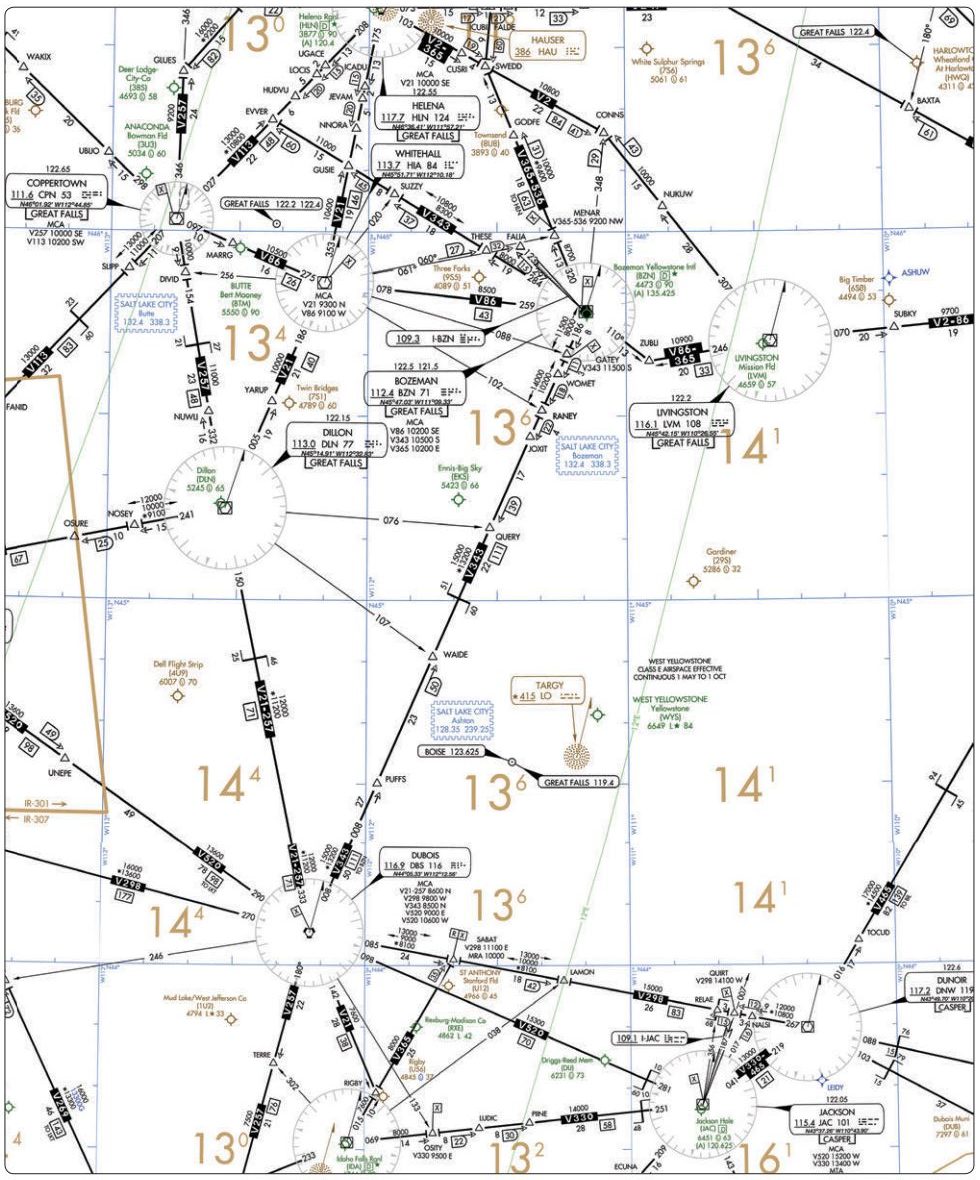 CorrectIncorrect
CorrectIncorrect -
Question 674 of 922
674. Question
Refer to figure 91 below. What should be the approximate elapsed time from BZN VOR to DBS VORTAC, if the wind is 24 knots from 260° and your intended TAS is 185 knots? (VAR 17°E.)
 CorrectIncorrect
CorrectIncorrect -
Question 675 of 922
675. Question
Refer to figure 91 below. Southbound on V257, at what time should you arrive at DBS VORTAC if you crossed over CPN VORTAC at 0850 and over DIVID intersection at 0854?
 CorrectIncorrect
CorrectIncorrect -
Question 676 of 922
676. Question
Refer to figure 91 below. When flying a northbound IFR flight on V257, what is the minimum crossing altitude at DBS VORTAC?
 CorrectIncorrect
CorrectIncorrect -
Question 677 of 922
677. Question
Refer to figure 91 below. What are the oxygen requirements for an IFR flight eastbound on V520 from DBS VORTAC in an unpressurized aircraft at the MEA?
 CorrectIncorrect
CorrectIncorrect -
Question 678 of 922
678. Question
Refer to figure 91 below. Where should you change VOR frequencies when en route from DBS VORTAC to JAC VOR/DME on V520?
 CorrectIncorrect
CorrectIncorrect -
Question 679 of 922
679. Question
Refer to figure 91 below. What lighting is indicated on the chart for Jackson Hole Airport?
 CorrectIncorrect
CorrectIncorrect -
Question 680 of 922
680. Question
Refer to figure 91 below. What is the minimum crossing altitude at SABAT intersection when eastbound from DBS VORTAC on V298?
 CorrectIncorrect
CorrectIncorrect -
Question 681 of 922
681. Question
Refer to figure 91 and legend 33 below. What is the function of the Great Falls RCO (Yellowstone vicinity)?

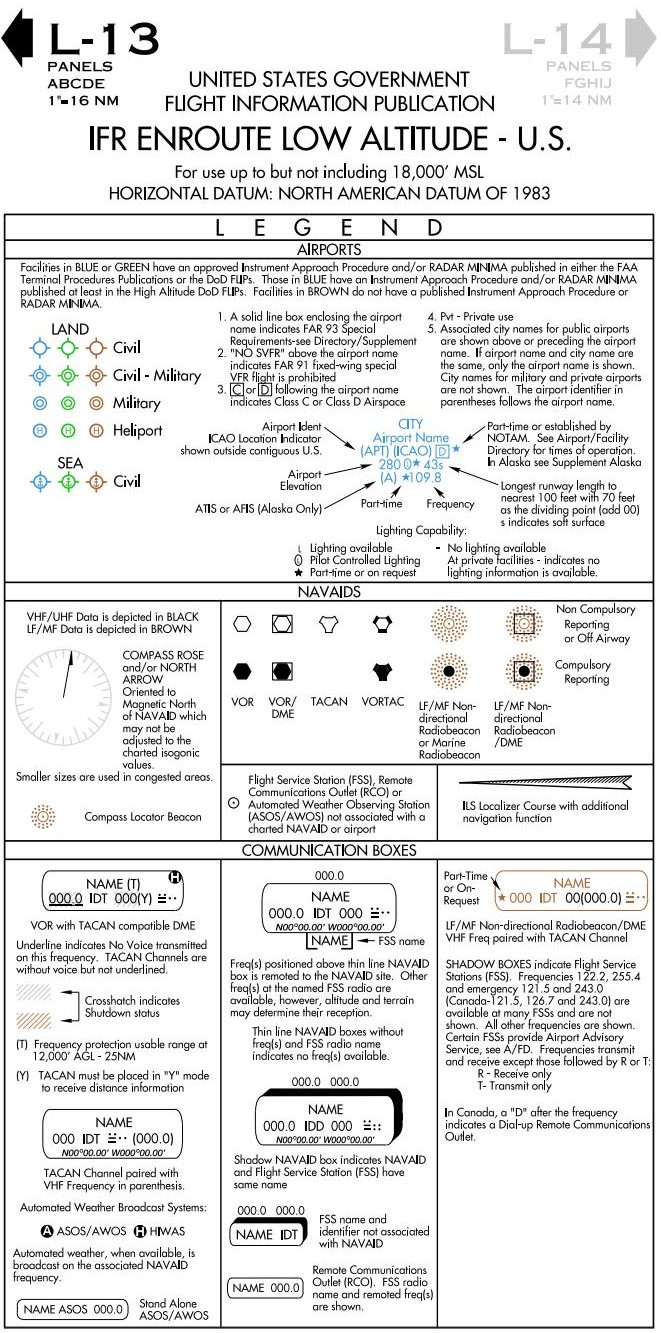 CorrectIncorrect
CorrectIncorrect -
Question 682 of 922
682. Question
In the event of two-way radio communications failure while operating on an IFR clearance in VFR conditions, the pilot should continue
CorrectIncorrect -
Question 683 of 922
683. Question
Refer to figure 193 below. On which frequencies could you communicate with the Montgomery County FSS while on the ground at College Station?
 CorrectIncorrect
CorrectIncorrect -
Question 684 of 922
684. Question
Refer to figure 193 below. Which indications on the VOR receivers and DME at the Easterwood Field VOR receiver checkpoint would meet the regulatory requirement for this flight?
 CorrectIncorrect
CorrectIncorrect -
Question 685 of 922
685. Question
Refer to figure 64 below. The course deviation indicator (CDI) is centered. Which indicators on the No. 1 and No. 2 VOR receivers over the Lafayette Regional Airport would meet the requirements for the VOR receiver check?
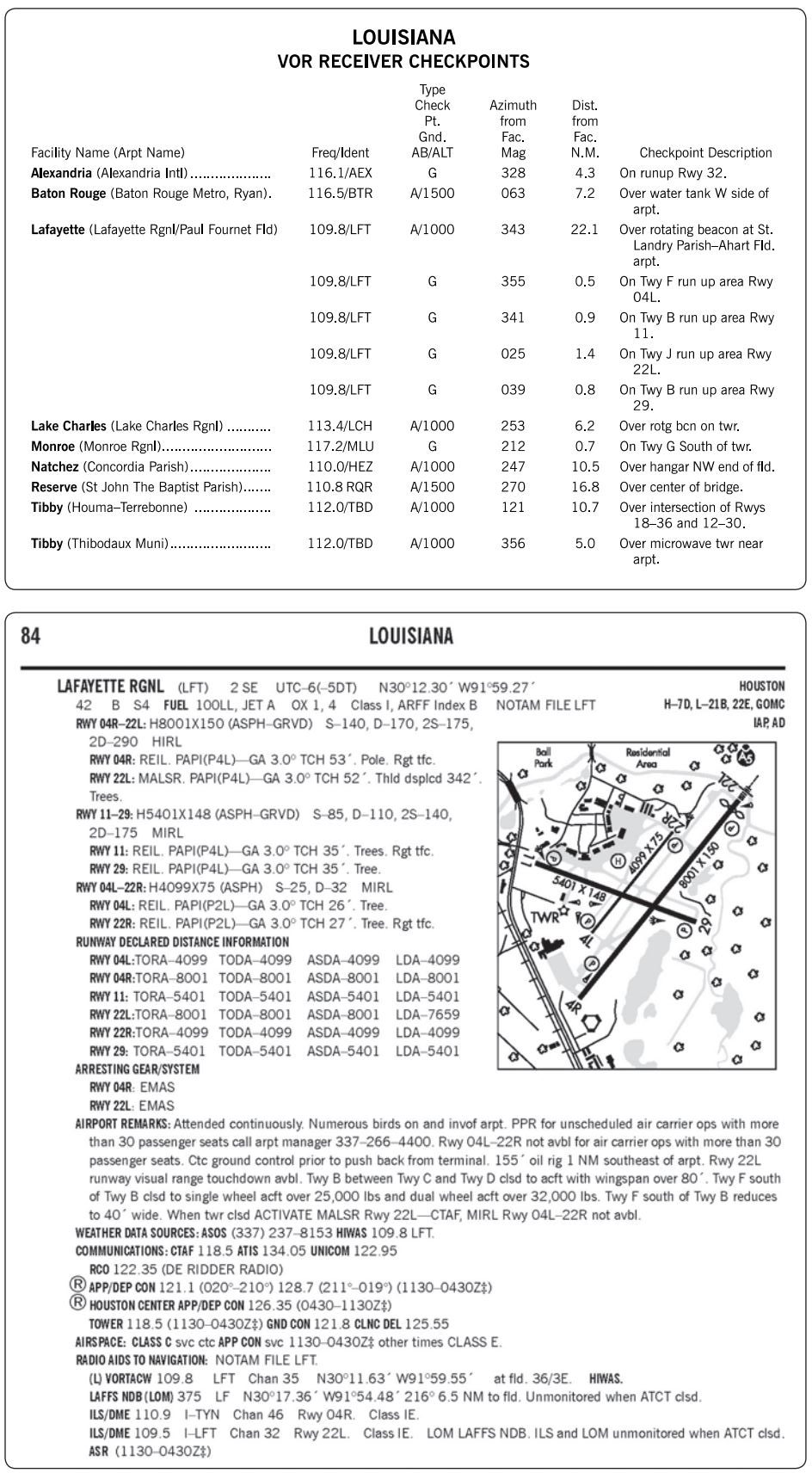
 CorrectIncorrect
CorrectIncorrect -
Question 686 of 922
686. Question
Refer to figure 65 below. Which point would be the appropriate VOR COP on V552 from the LFT to the TBD VORTACs?
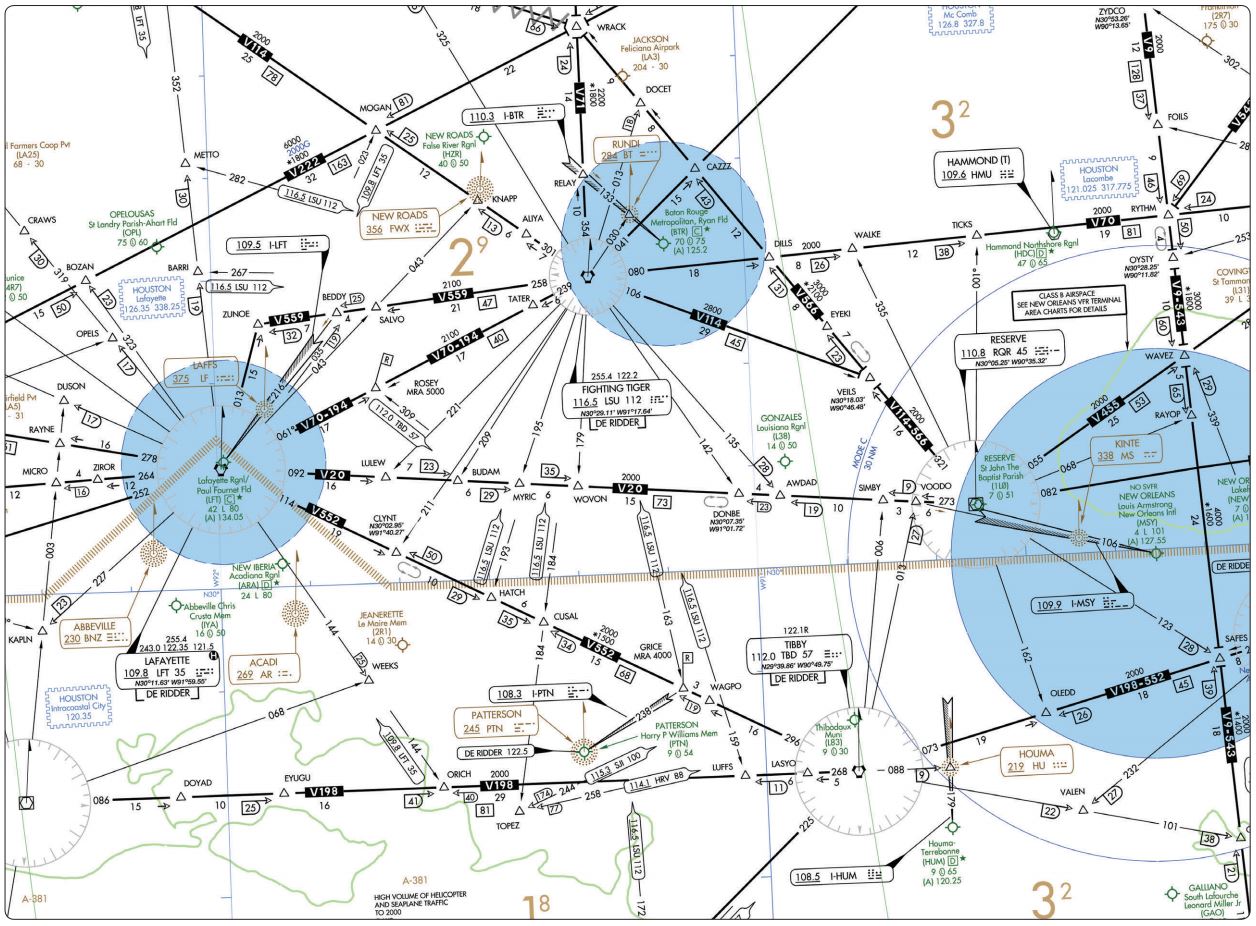 CorrectIncorrect
CorrectIncorrect -
Question 687 of 922
687. Question
CorrectIncorrect -
Question 688 of 922
688. Question
Refer to figure 65 and figure 67 below. What is the significance of the symbol at GRICE intersection?

 CorrectIncorrect
CorrectIncorrect -
Question 689 of 922
689. Question
Refer to figure 24 below. For planning purposes, what would be the highest MEA on V187 between Grand Junction, Walker Airport, and Durango, La Plata Co. Airport?
 CorrectIncorrect
CorrectIncorrect -
Question 690 of 922
690. Question
Refer to figure 24 below. While passing near the CORTEZ VOR, southbound on V187 contact is lost with Denver Center. You should, attempt to reestablish contact with Denver Center on
 CorrectIncorrect
CorrectIncorrect -
Question 691 of 922
691. Question
Refer to figure 24 below. Your original route of flight was CEZ V391 JNC. However, due to thunderstorms en route, ATC revises your route to CEZ V391 DVC V68 MTJ V26 JNC. Calculate how much additional fuel will you consume given the following:
Winds = 230 @ 40 kts
TAS = 130 kts
GPH = 17
 CorrectIncorrect
CorrectIncorrect -
Question 692 of 922
692. Question
Refer to figure 24 below. What is the MOGA between JNC and MANCA intersection on V187?
 CorrectIncorrect
CorrectIncorrect -
Question 693 of 922
693. Question
Refer to figure 24 below. At what point should a VOR changeover be made from JNC VOR to MANCA intersection southbound on V187?
 CorrectIncorrect
CorrectIncorrect -
Question 694 of 922
694. Question
Refer to figure 31 below. What minimum navigation equipment is required en route on V448 to identify MOPIO?
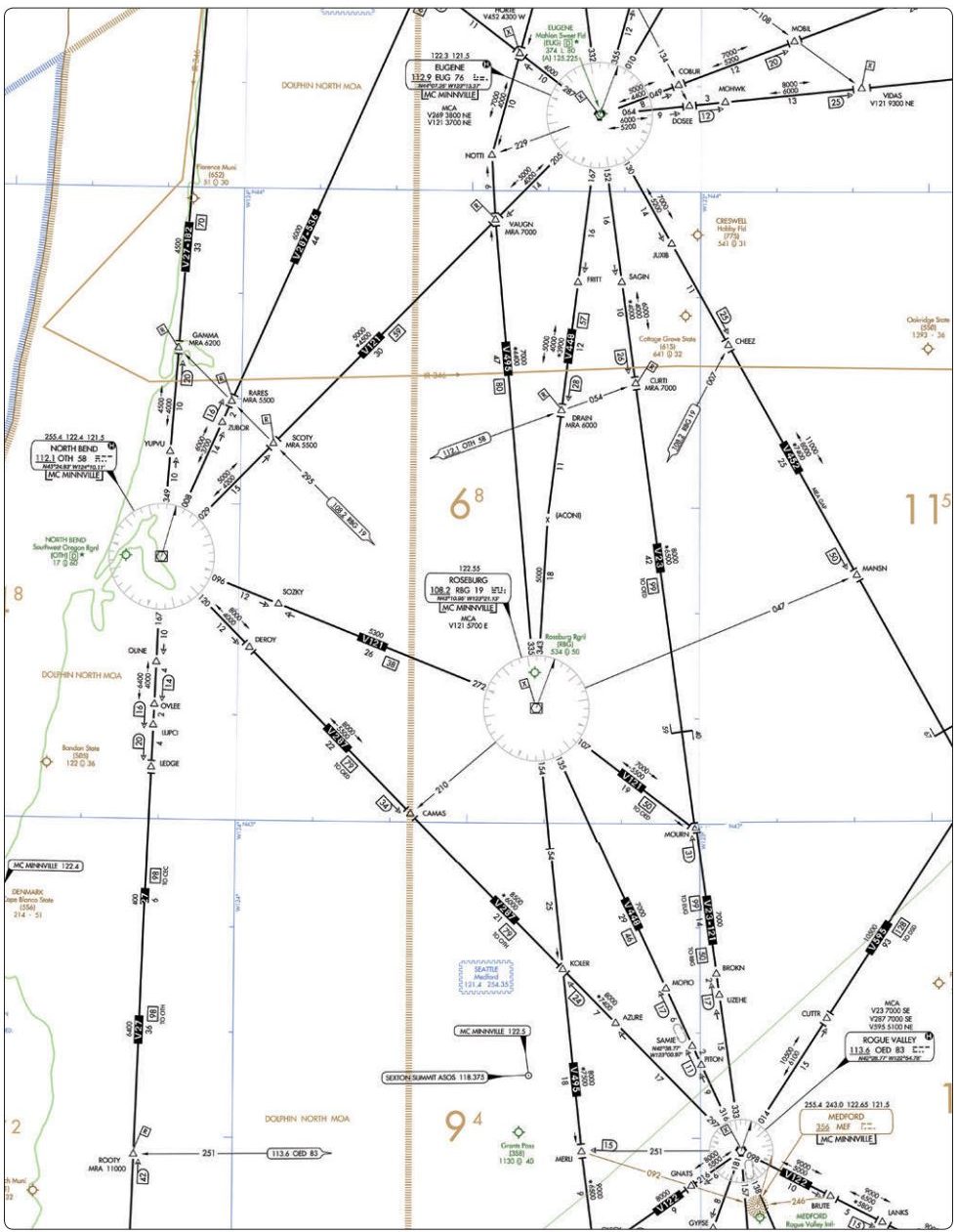 CorrectIncorrect
CorrectIncorrect -
Question 695 of 922
695. Question
Refer to figure 161 below. What is the TDZ elevation for RWY 16R on Eugene/Mahlon Sweet Field?
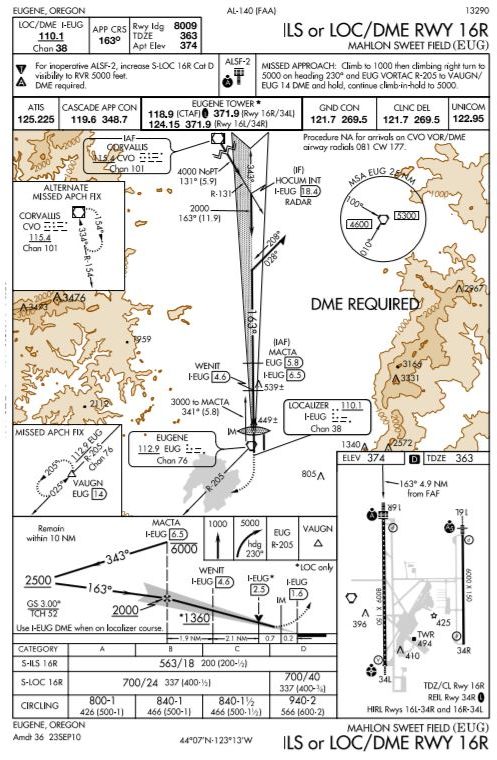 CorrectIncorrect
CorrectIncorrect -
Question 696 of 922
696. Question
Refer to figure 161 and legend 27 below. Using a ground speed of 90 knots on the ILS final approach course, what rate of descent should be used as a reference to maintain the ILS glide slope?

 CorrectIncorrect
CorrectIncorrect -
Question 697 of 922
697. Question
Refer to figure 162 below. What are the hours of operation (local standard time) of the control tower at Eugene/Mahlon Sweet Field?
 CorrectIncorrect
CorrectIncorrect -
Question 698 of 922
698. Question
Refer to figure 165 below. To which maximum service volume distance from the OED VORTAC should you expect to receive adequate signal coverage for navigation at 8,000 ft.?
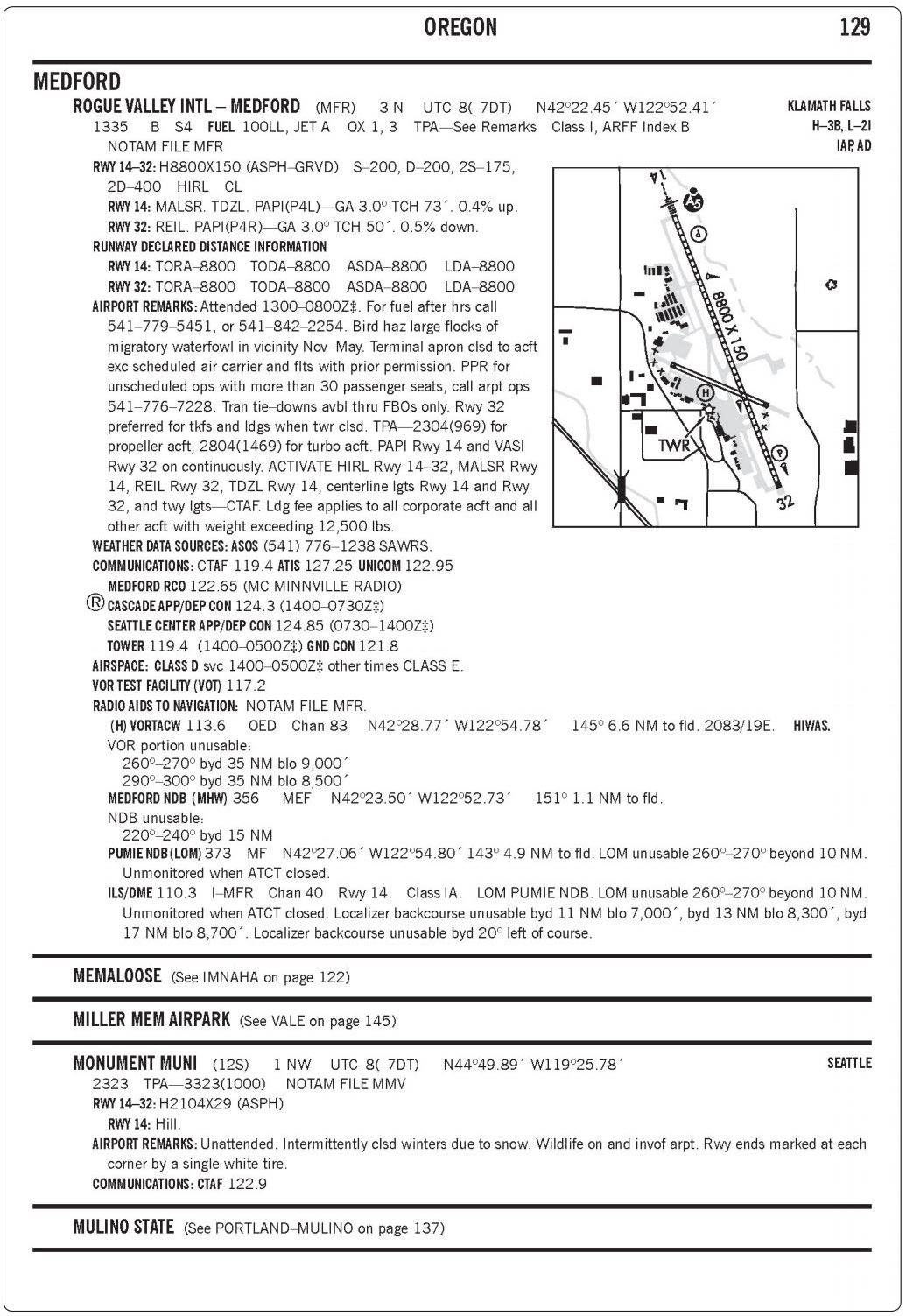 CorrectIncorrect
CorrectIncorrect -
Question 699 of 922
699. Question
Refer to figure 165 below. Which restriction to the use of the OED VORTAC would be applicable to the (GNATS6.MOURN) departure?
 CorrectIncorrect
CorrectIncorrect -
Question 700 of 922
700. Question
Refer to figure 163 and figure 164 below. Using an average ground speed of 120 knots and taking off on Runway 14, what minimum rate of climb must be maintained to meet the required climb rate (in feet per NM) to 4,800 feet as specified on the instrument departure procedures?
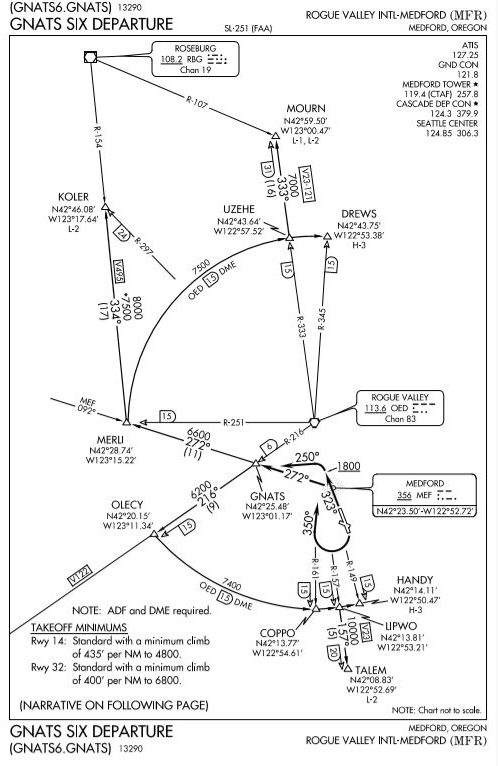
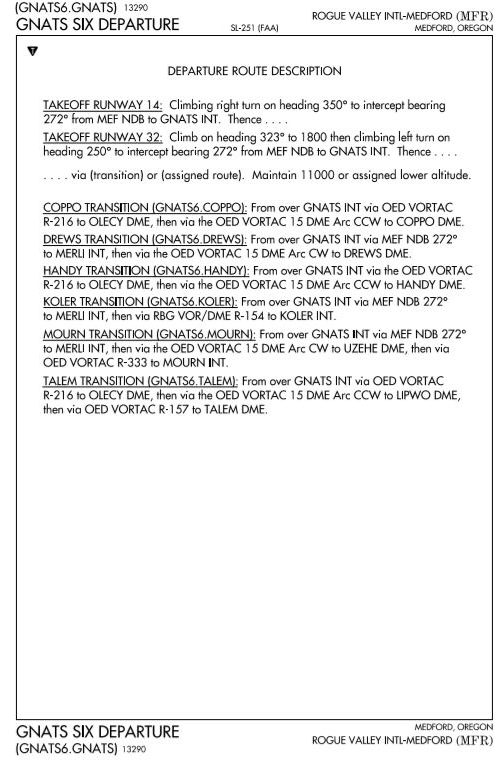 CorrectIncorrect
CorrectIncorrect -
Question 701 of 922
701. Question
Refer to figure 47 below. En route on V112 from BTG VORTAC to LTJ VORTAC, the minimum altitude crossing Gymme intersection is
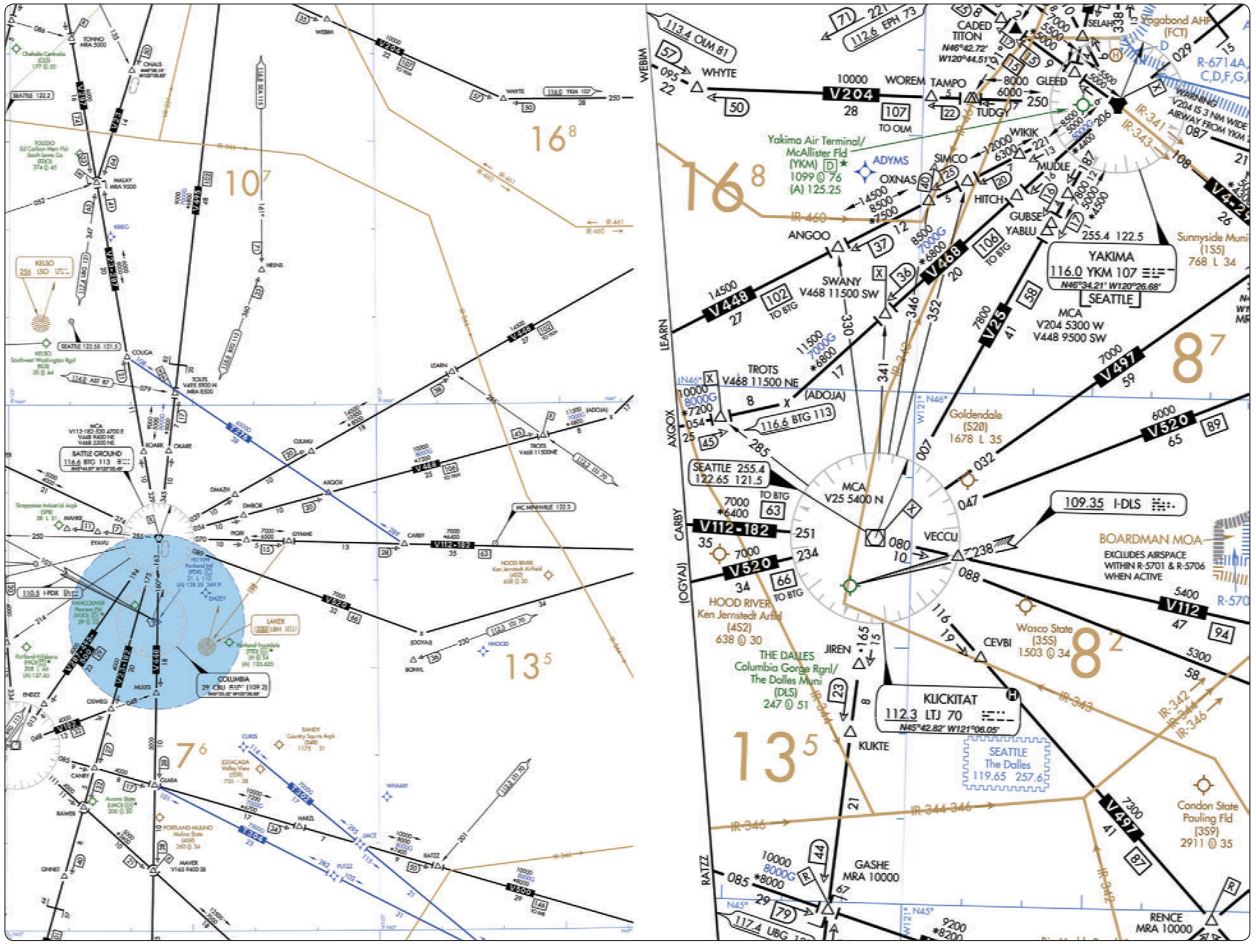 CorrectIncorrect
CorrectIncorrect -
Question 702 of 922
702. Question
Refer to figure 47 below. When en route on V448 from YKM VORTAC to BTG VORTAC, what minimum navigation equipment is required to identify ANGOO intersection?
 CorrectIncorrect
CorrectIncorrect -
Question 703 of 922
703. Question
Refer to figure 47 below. En route on V468 from BTG VORTAC to YKM VORTAC, the minimum altitude at TROTS intersection is
 CorrectIncorrect
CorrectIncorrect -
Question 704 of 922
704. Question
Refer to figure 188 below What is the MDA and visibility criteria for a straight-in LOC/DME RWY 21 approach at Portland International in a Category B airplane?
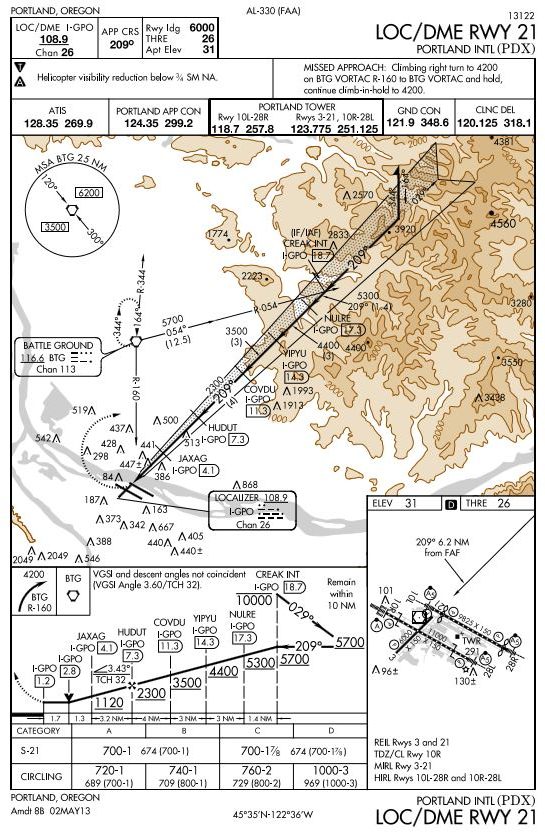 CorrectIncorrect
CorrectIncorrect -
Question 705 of 922
705. Question
Refer to figure 188 below. With a ground speed of 120 knots, approximately what minimum rate of descent will be required between I-GPO 11.3 DME fix (COVDU) and the I-GPO 7.3 DME fix?
 CorrectIncorrect
CorrectIncorrect -
Question 706 of 922
706. Question
Refer to figure 188 below. You have been cleared to the CREAK intersection via the BTG 054° radial at 7,000 ft. Approaching CREAK, you are cleared for the LOC/DME RWY 21 approach to POX. Descent to procedure turn altitude should not begin prior to
 CorrectIncorrect
CorrectIncorrect -
Question 707 of 922
707. Question
Refer to figure 182 below. Using an average ground speed of 140 knots, what minimum indicated rate of climb must be maintained to meet the required climb rate (feet per NM) to 6,300 feet as specified on the instrument departure procedure for RWY22?
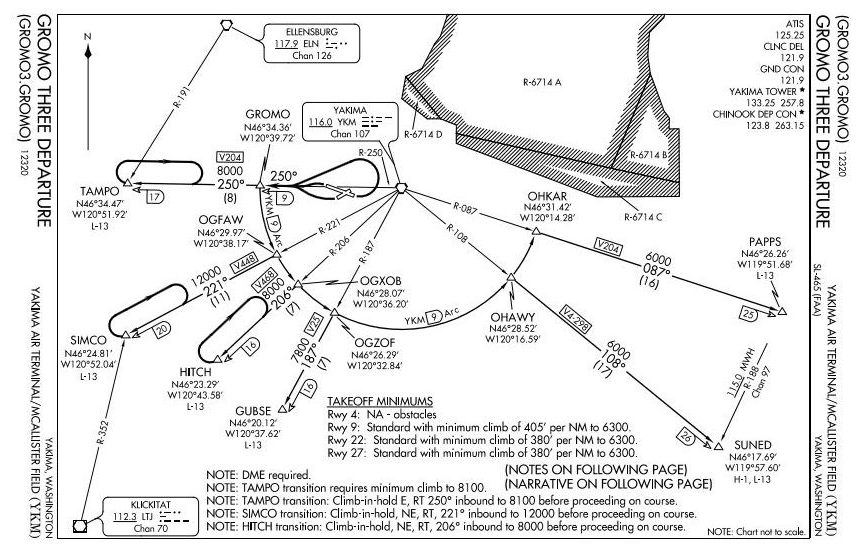 CorrectIncorrect
CorrectIncorrect -
Question 708 of 922
708. Question
Refer to figure 48 and figure 182 below. What is your position relative to the 9 DME ARC and the 206° radial of the instrument departure procedure?
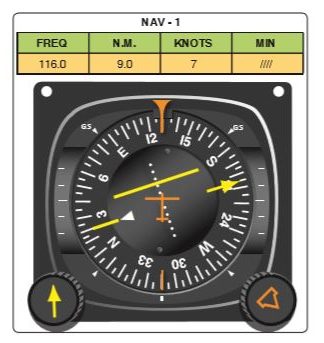
 CorrectIncorrect
CorrectIncorrect -
Question 709 of 922
709. Question
Refer to figure 188 below. With a ground speed of 120 knots, approximately what minimum rate of descent will be required between I-GPO 7.3 DME fix (HUDUT) and the I-GPO 4.1 DME fix?
 CorrectIncorrect
CorrectIncorrect -
Question 710 of 922
710. Question
Refer to figure 188 below. What determines the MAP on the LOC/DME RWY 21 approach at Portland International Airport?
 CorrectIncorrect
CorrectIncorrect -
Question 711 of 922
711. Question
Refer to figure 188 below. When conducting the LOC/DME RWY 21 approach at POX, what is the Minimum Safe Altitude (MSA) while
maneuvering between the BTG VORTAC and CREAK intersection?
 CorrectIncorrect
CorrectIncorrect -
Question 712 of 922
712. Question
Refer to figure 188 below. When conducting a missed approach from the LOC/DME RWY 21 approach at POX, what is the Minimum Safe Altitude(MSA) while maneuvering between the runway and BTG VORTAC?
 CorrectIncorrect
CorrectIncorrect -
Question 713 of 922
713. Question
What are the four families of clouds?
CorrectIncorrect -
Question 714 of 922
714. Question
Which family of clouds is least likely to contribute to structural icing on an aircraft?
CorrectIncorrect -
Question 715 of 922
715. Question
The presence of standing lenticular altocumulus clouds is a good indication of
CorrectIncorrect -
Question 716 of 922
716. Question
Standing lenticular clouds, in mountainous areas, indicate
CorrectIncorrect -
Question 717 of 922
717. Question
The suffix “nimbus”, used in naming clouds, means a
CorrectIncorrect -
Question 718 of 922
718. Question
A high cloud is composed mostly of
CorrectIncorrect -
Question 719 of 922
719. Question
Which clouds have the greatest turbulence?
CorrectIncorrect -
Question 720 of 922
720. Question
Fair weather cumulus clouds often indicate
CorrectIncorrect -
Question 721 of 922
721. Question
When is an airplane most likely to be struck by lightning?
CorrectIncorrect -
Question 722 of 922
722. Question
What are the requirements for the formation of a thunderstorm?
CorrectIncorrect -
Question 723 of 922
723. Question
What is an indication that downdrafts have developed and the thunderstorm cell has entered the mature stage?
CorrectIncorrect -
Question 724 of 922
724. Question
Which procedure is recommended if a pilot should unintentionally penetrate embedded thunderstorm activity?
CorrectIncorrect -
Question 725 of 922
725. Question
Which thunderstorms generally produce the most severe conditions, such as heavy hail and destructive winds?
CorrectIncorrect -
Question 726 of 922
726. Question
Which weather phenomenon is always associated with a thunderstorm?
CorrectIncorrect -
Question 727 of 922
727. Question
During the life cycle of a thunderstorm, which stage is characterized predominately by downdrafts?
CorrectIncorrect -
Question 728 of 922
728. Question
If squalls are reported at your destination, what wind conditions should you anticipate?
CorrectIncorrect -
Question 729 of 922
729. Question
What is indicated by the term “embedded thunderstorms”?
CorrectIncorrect -
Question 730 of 922
730. Question
Which weather phenomenon signals the beginning of the mature stage of a thunderstorm?
CorrectIncorrect -
Question 731 of 922
731. Question
The use of airborne weather-avoidance radar
CorrectIncorrect -
Question 732 of 922
732. Question
In which meteorological environment is aircraft structural icing most likely to have the highest rate of accumulation?
CorrectIncorrect -
Question 733 of 922
733. Question
Test data indicate that ice, snow, or frost having a thickness and roughness similar to medium or coarse sandpaper on the leading edge and upper surface of an airfoil can
CorrectIncorrect -
Question 734 of 922
734. Question
Which precipitation type normally indicates freezing rain at higher altitudes?
CorrectIncorrect -
Question 735 of 922
735. Question
What visual clue would alert a pilot to the presence of large supercooled water droplets?
CorrectIncorrect -
Question 736 of 922
736. Question
When large supercooled water droplets (SLD) are present in temperatures below +5°C, outside air temperature, what type of icing would be expected to form?
CorrectIncorrect -
Question 737 of 922
737. Question
Which of the following would be an accurate description of supercooled large droplets (SLD)?
CorrectIncorrect -
Question 738 of 922
738. Question
What is an operational consideration if you fly into rain which freezes on impact?
CorrectIncorrect -
Question 739 of 922
739. Question
What temperature condition is indicated if wet snow is encountered at your flight altitude?
CorrectIncorrect -
Question 740 of 922
740. Question
The presence of ice pellets at the surface is evidence that
CorrectIncorrect -
Question 741 of 922
741. Question
Why is frost considered hazardous to flight operation?
CorrectIncorrect -
Question 742 of 922
742. Question
If the air temperature is +8°C at an elevation of 1,350 feet and a standard (average) temperature lapse rate exists, what will be the approximate freezing level?
CorrectIncorrect -
Question 743 of 922
743. Question
A pilot who experiences tailplane icing on the approach should
CorrectIncorrect -
Question 744 of 922
744. Question
What happens to residual ice that remains after deice boots are inflated and shed ice?
CorrectIncorrect -
Question 745 of 922
745. Question
On which surface of the aircraft could a pilot generally expect to see the first sign of ice accumulation?
CorrectIncorrect -
Question 746 of 922
746. Question
What types of surfaces are most likely to see the first signs of ice accumulation?
CorrectIncorrect -
Question 747 of 922
747. Question
While flying a standard instrument departure procedure (DP) you encounter icing conditions and the autopilot is engaged, you should
CorrectIncorrect -
Question 748 of 922
748. Question
The most susceptible surface of the aircraft for ice accumulation is the
CorrectIncorrect -
Question 749 of 922
749. Question
If you detect icing accumulation in flight, especially if the aircraft is not equipped with a deicing system, you should
CorrectIncorrect -
Question 750 of 922
750. Question
To recover from a tailplane stall brought on by ice accumulation, the pilot should
CorrectIncorrect -
Question 751 of 922
751. Question
Tailplane icing can be detected by a(n)
CorrectIncorrect -
Question 752 of 922
752. Question
Tailplane icing can be detected by
CorrectIncorrect -
Question 753 of 922
753. Question
In an aircraft equipped with a pneumatic deicing system, the appropriate technique for removing ice is to
CorrectIncorrect -
Question 754 of 922
754. Question
A tailplane stall as the result of ice accumulation is most likely to occur during
CorrectIncorrect -
Question 755 of 922
755. Question
With regards to icing, which is true?
CorrectIncorrect -
Question 756 of 922
756. Question
Which of the following is true about icing?
CorrectIncorrect -
Question 757 of 922
757. Question
Should you experience uncommanded roll due to icing forward of the ailerons, the most appropriate response is to
CorrectIncorrect -
Question 758 of 922
758. Question
Should you experience buffeting or vibrations after .extending the flaps upon exiting or during icing conditions, the most likely reason is
CorrectIncorrect -
Question 759 of 922
759. Question
The best technique for using deicing boots is to
CorrectIncorrect -
Question 760 of 922
760. Question
The proper use of deicing boots should include
CorrectIncorrect -
Question 761 of 922
761. Question
How should deicing boots be used after exiting flight in icing conditions?
CorrectIncorrect -
Question 762 of 922
762. Question
Test data indicates that ice, snow, or frost having a thickness and roughness similar to medium or coarse sandpaper on the leading edge and upper surface of an airfoil can
CorrectIncorrect -
Question 763 of 922
763. Question
During or after flight in icing conditions, vibration or buffeting that follows, but was not evident prior to, flap deployment is
CorrectIncorrect -
Question 764 of 922
764. Question
Which is true concerning aircraft icing?
CorrectIncorrect -
Question 765 of 922
765. Question
Where would you see the first sign of ice buildup?
CorrectIncorrect -
Question 766 of 922
766. Question
Roll upsets caused by ice accumulation forward of the ailerons can be remedied by
CorrectIncorrect -
Question 767 of 922
767. Question
When using deicing boots, the pilot should
CorrectIncorrect -
Question 768 of 922
768. Question
If you experience icing during an approach, you should
- If you experience icing during an approach, you should
CorrectIncorrect -
Question 769 of 922
769. Question
On the initial climbout after takeoff with the autopilot engaged, you encounter icing conditions. In this situation, it is recommended that
CorrectIncorrect -
Question 770 of 922
770. Question
What type of icing should be expected when you encounter supercooled large droplets (SLD) that splash or splatter on impact at temperatures below +5°C OAT?
CorrectIncorrect -
Question 771 of 922
771. Question
Which is true regarding Supercooled Large Droplets (SLD) and their accumulation?
CorrectIncorrect -
Question 772 of 922
772. Question
Ice tends to accumulate first on parts of the plane that are
CorrectIncorrect -
Question 773 of 922
773. Question
After cycling of the deicing boots, residual ice will
CorrectIncorrect -
Question 774 of 922
774. Question
Which is true about ice formation on a wing surface?
CorrectIncorrect -
Question 775 of 922
775. Question
Which of the following is true about icing characteristics?
CorrectIncorrect -
Question 776 of 922
776. Question
What is true regarding ice accumulations on a wing surface?
CorrectIncorrect -
Question 777 of 922
777. Question
Where will the pilot first notice an accumulation of ice?
CorrectIncorrect -
Question 778 of 922
778. Question
Where is airplane icing most difficult to identify?
CorrectIncorrect -
Question 779 of 922
779. Question
A generally recommended practice for autopilot usage during cruise flight in icing conditions is
CorrectIncorrect -
Question 780 of 922
780. Question
On initial climbout after takeoff and with the autopilot engaged, you encounter icing conditions. In this situation you can expect
CorrectIncorrect -
Question 781 of 922
781. Question
What is an important characteristic of wind shear?
CorrectIncorrect -
Question 782 of 922
782. Question
A pilot reporting turbulence that momentarily causes slight, erratic changes in altitude and/or attitude should report it as
CorrectIncorrect -
Question 783 of 922
783. Question
What is an important characteristic of wind shear?
CorrectIncorrect -
Question 784 of 922
784. Question
Where can wind shear associated with a thunderstorm be found? Choose the most complete answer.
CorrectIncorrect -
Question 785 of 922
785. Question
Where does wind shear occur?
CorrectIncorrect -
Question 786 of 922
786. Question
Hazardous wind shear is commonly encountered near the ground
CorrectIncorrect -
Question 787 of 922
787. Question
When a climb or descent through an inversion or wind shear zone is being performed, the pilot should be alert for which of the following changes in airplane performance?
CorrectIncorrect -
Question 788 of 922
788. Question
Which is a characteristic of low-level wind shear as it relates to low-level temperature inversions?
CorrectIncorrect -
Question 789 of 922
789. Question
Refer to figure 13 below. When penetrating a microburst, which aircraft will experience an increase in performance without a change in pitch or power?
 CorrectIncorrect
CorrectIncorrect -
Question 790 of 922
790. Question
Refer to figure 13 below. The aircraft in position 3 will experience which effect in a microburst encounter?
 CorrectIncorrect
CorrectIncorrect -
Question 791 of 922
791. Question
Refer to figure 13 below. How will the aircraft in position 4 be affected by a microburst encounter?
 CorrectIncorrect
CorrectIncorrect -
Question 792 of 922
792. Question
Refer to figure 13 below. If involved in a microburst encounter, in which aircraft positions will the most severe downdraft occur?
 CorrectIncorrect
CorrectIncorrect -
Question 793 of 922
793. Question
Refer to figure 13 below. What effect will a microburst encounter have upon the aircraft in position 4?
 CorrectIncorrect
CorrectIncorrect -
Question 794 of 922
794. Question
An aircraft that encounters a headwind of 45 knots, within a microburst, may expect a total shear across the microburst of
CorrectIncorrect -
Question 795 of 922
795. Question
Maximum downdrafts in a microburst encounter may be as strong as
CorrectIncorrect -
Question 796 of 922
796. Question
What is the expected duration of an individual microburst?
CorrectIncorrect -
Question 797 of 922
797. Question
AIRMETs are issued on a scheduled basis every
CorrectIncorrect -
Question 798 of 922
798. Question
The Hazardous lnflight Weather Advisory Service (HIWAS) is a continuous broadcast over selected VORs of
CorrectIncorrect -
Question 799 of 922
799. Question
Pilots of IFR flights seeking ATC in-flight weather avoidance assistance should keep in mind that
CorrectIncorrect -
Question 800 of 922
800. Question
SIGMETs are issued as a warning of weather conditions potentially hazardous
CorrectIncorrect -
Question 801 of 922
801. Question
SIGMETs are issued as a warning of weather conditions potentially hazardous
CorrectIncorrect -
Question 802 of 922
802. Question
The reporting station originating this Aviation Routine Weather Report has a field elevation of 620 feet. If the reported sky cover is one continuous layer, what is its thickness (tops of OVC are reported at 6,500 feet)?
METAR KMDW 121856Z AUTO 32005KT 1 1/2SM +RA BR OVC007 17/16 A2980
CorrectIncorrect -
Question 803 of 922
803. Question
The station originating the following weather report has a field elevation of 1,300 feet MSL. From the bottom of the overcast cloud layer, what is its thickness (tops of OVC are reported at 3,800 feet)?
SPECI KOKC 2228Z 28024G36KT 3/4SM BKN008 OVC020 28/23 A3000
CorrectIncorrect -
Question 804 of 922
804. Question
Interpret the remarks section of METAR surface report for KBNA.
METAR KBNA 211250Z 33018KT 290V260 1/2SM R31/2700FT +SN BLSNFG VV008 OO/M03 A2991 RMK RAE42SNB42
CorrectIncorrect -
Question 805 of 922
805. Question
A ceiling is defined as the height of the
CorrectIncorrect -
Question 806 of 922
806. Question
What significant sky condition is reported in this METAR observation?
METAR KBNA 1250Z 33018KT 290V360 1/2SM R31/2700FT +SN BLSNFG VV008 OO/M03 A2991 RMK RERAE42SNB42
CorrectIncorrect -
Question 807 of 922
807. Question
Interpret this PIREP.
MRB UA/OV MRB/TM 1430/FL 060/TP C182/SK BKN BL /WX RA/TB MDT.
CorrectIncorrect -
Question 808 of 922
808. Question
Which response most closely interprets the following PIREP?
UA/OV OKC 063064/TM 1522/FL080/TP C172/TA – 04 /WV245040/TB LGT/RM IN CLR.
CorrectIncorrect -
Question 809 of 922
809. Question
Use the TAF to determine the wind shear forecast.
TAF
KCVG 231051Z 231212 12012KT 4SM -RA BR OVC008 WS005/27050KT TEMPO 1719 1/2SM -RA FG
FM1930 09012KT 1SM-DZ BR VV003 BECMG 2021 5SM HZ=
CorrectIncorrect -
Question 810 of 922
810. Question
What is the forecast wind at 1800Z in the following TAF?
KMEM 091740Z 1818 OOOOOKT 1/2SM RAFG OVC005=
CorrectIncorrect -
Question 811 of 922
811. Question
When the visibility is greater than 6 SM on a TAF it is
CorrectIncorrect -
Question 812 of 922
812. Question
Which weather product is a concise statement of the expected weather for an airport’s runway complex?
CorrectIncorrect -
Question 813 of 922
813. Question
A “VRB” wind entry in a Terminal Aerodrome Forecast (TAF) will be indicated when the wind is
CorrectIncorrect -
Question 814 of 922
814. Question
The body of a Terminal Aerodrome Forecast (TAF) covers a geographical proximity within a
CorrectIncorrect -
Question 815 of 922
815. Question
A station is forecasting wind and temperature aloft at FL 390 to be 300° at 200 knots; temperature -54°C. How would this data be encoded in the FB?
CorrectIncorrect -
Question 816 of 922
816. Question
How much colder than standard temperature is the forecast temperature at 9,000 feet, as indicated in the following excerpt from the Wind and Temperature Aloft Forecast?
FT 6000 9000
0737-04 1043-10
CorrectIncorrect -
Question 817 of 922
817. Question
What wind direction and speed is represented by the entry 9900+00 for 9,000 feet, on a Wind and Temperature Aloft Forecast (FB)?
CorrectIncorrect -
Question 818 of 922
818. Question
When is the temperature at one of the forecast altitudes omitted at a specific location or station in the Wind and Temperature Aloft Forecast (FB)?
CorrectIncorrect -
Question 819 of 922
819. Question
Refer to figure 2 below. What approximate wind direction, speed, and temperature (relative to ISA) should a pilot expect when planning for a flight over ALB at FL 270?
 CorrectIncorrect
CorrectIncorrect -
Question 820 of 922
820. Question
Refer to figure 2 below. What approximate wind direction, speed, and temperature (relative to ISA) should a pilot expect when planning for a flight over PSB at FL 270?
 CorrectIncorrect
CorrectIncorrect -
Question 821 of 922
821. Question
Refer to figure 2 below. What approximate wind direction, speed, and temperature (relative to ISA) should a pilot expect when planning for a flight over EMI at FL 270?
 CorrectIncorrect
CorrectIncorrect -
Question 822 of 922
822. Question
When is the wind group at one of the forecast altitudes omitted at a specific location or station in the Wind and Temperature Aloft Forecast (FB)? When the wind
CorrectIncorrect -
Question 823 of 922
823. Question
Which values are used for winds aloft forecasts?
CorrectIncorrect -
Question 824 of 922
824. Question
Refer to figure 87 below. Where is the VOR COP when flying east on V306 from Daisetta to Lake Charles?
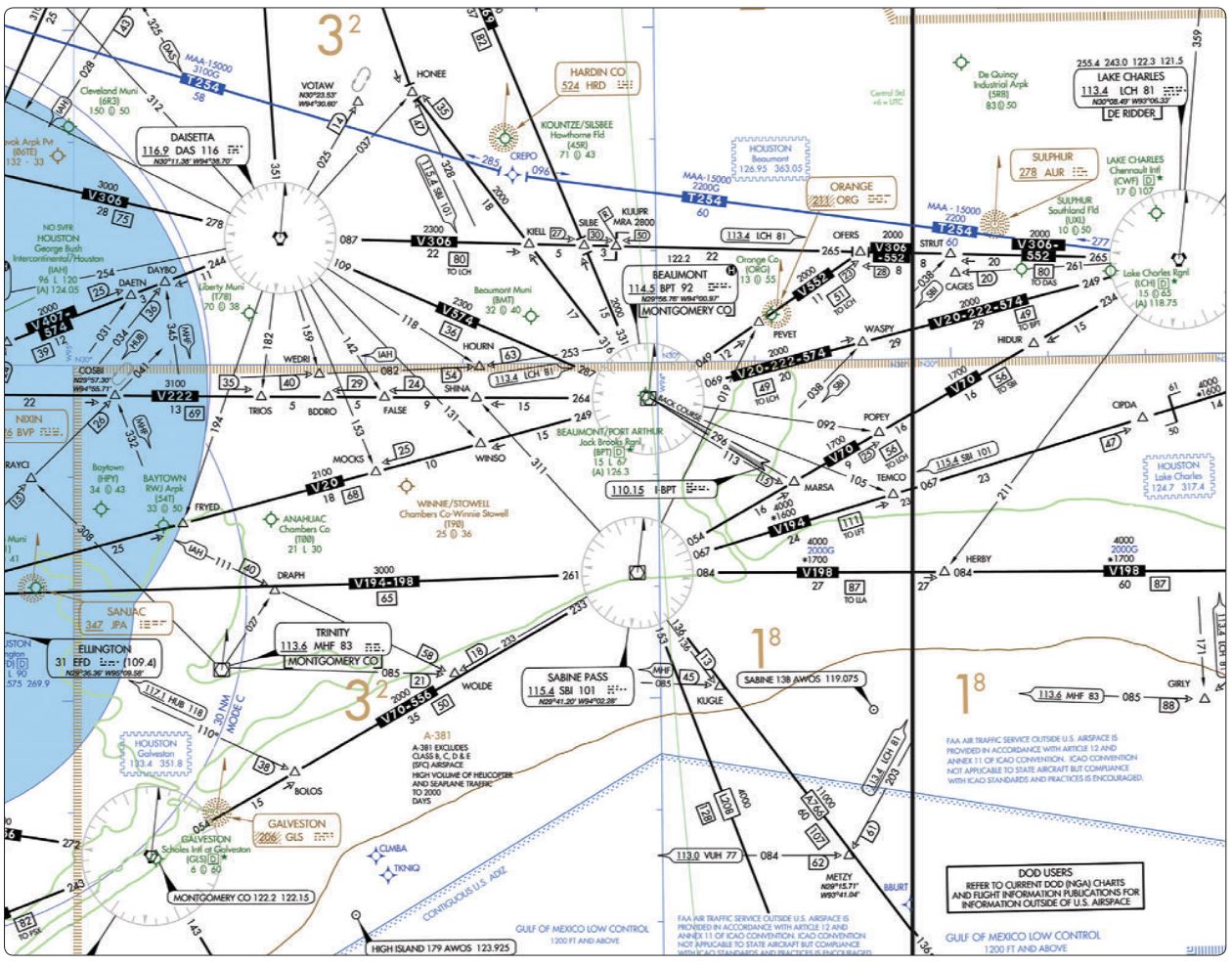 CorrectIncorrect
CorrectIncorrect -
Question 825 of 922
825. Question
Refer to figure 87 below. What is indicated by the localizer course symbol at Jack Brooks Regional Airport?
 CorrectIncorrect
CorrectIncorrect -
Question 826 of 922
826. Question
Refer to figure 87 below. While holding at the 10 DME fix east of LCH for an ILS approach to RWY 15 at Lake Charles Muni Airport, ATC advises you to expect clearance for the approach at 1015. At 1000 you experience two-way radio communications failure. Which procedure should be followed?
 CorrectIncorrect
CorrectIncorrect -
Question 827 of 922
827. Question
Refer to figure 87 below. At STRUT intersection headed eastbound, ATC instructs you to hold west on the 10 DME fix west of LCH on V306, standard turns. What entry procedure is
recommended? CorrectIncorrect
CorrectIncorrect -
Question 828 of 922
828. Question
Refer to figure 87 below. Which VHF frequencies, other than 121.5, can be used to receive De Ridder FSS in the Lake Charles area?
 CorrectIncorrect
CorrectIncorrect -
Question 829 of 922
829. Question
Refer to figure 87 and legend 34 below. Where is the VOR changeover point on V20 between Beaumont and Hobby?

 CorrectIncorrect
CorrectIncorrect -
Question 830 of 922
830. Question
Refer to figure 88 and figure 87 below. What is your position with reference to FALSE intersection (V222) if your VOR receivers indicate as shown?
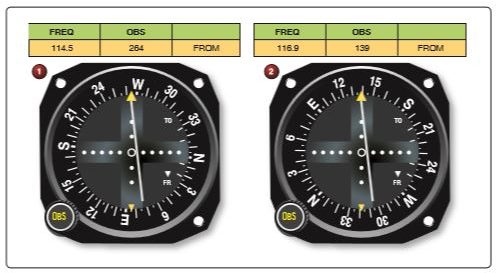
 CorrectIncorrect
CorrectIncorrect -
Question 831 of 922
831. Question
Refer to figure 89 below. When flying from Milford Municipal to Bryce Canyon via V235 and V293, what minimum altitude should you be at when crossing Cedar City VOR?
 CorrectIncorrect
CorrectIncorrect -
Question 832 of 922
832. Question
Refer to figure 89 below. What VHF frequencies are available for communications with Cedar City FSS

 CorrectIncorrect
CorrectIncorrect -
Question 833 of 922
833. Question
Refer to figure 89 below. What are the oxygen requirements for an IFR flight northeast bound from Bryce Canyon on V382 at the lowest appropriate altitude in an unpressurized aircraft?

 CorrectIncorrect
CorrectIncorrect -
Question 834 of 922
834. Question
Refer to figure 89 below What is the ARTCC discrete frequency at the COP on V208 southwest bound from HVE to PGA VOR/DME?
 CorrectIncorrect
CorrectIncorrect -
Question 835 of 922
835. Question
Refer to figure 192 below. As a guide in making range corrections, how many degrees of relative bearing change should be used for each one-half mile —–deviation from the desired arc?
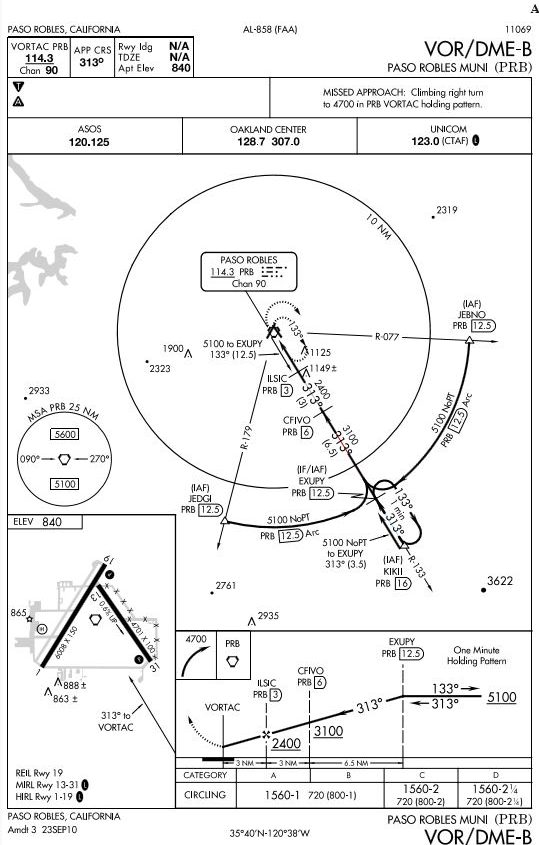 CorrectIncorrect
CorrectIncorrect -
Question 836 of 922
836. Question
Refer to figure 192 below. Under which condition should a missed approach procedure be initiated if the runway environment (Paso Robles Municipal Airport) is not in sight?
 CorrectIncorrect
CorrectIncorrect -
Question 837 of 922
837. Question
Refer to figure 189 below. Using an average ground speed of 100 knots, what minimum rate of climb would meet the required minimum climb rate per NM as specified by the instrument departure procedure?
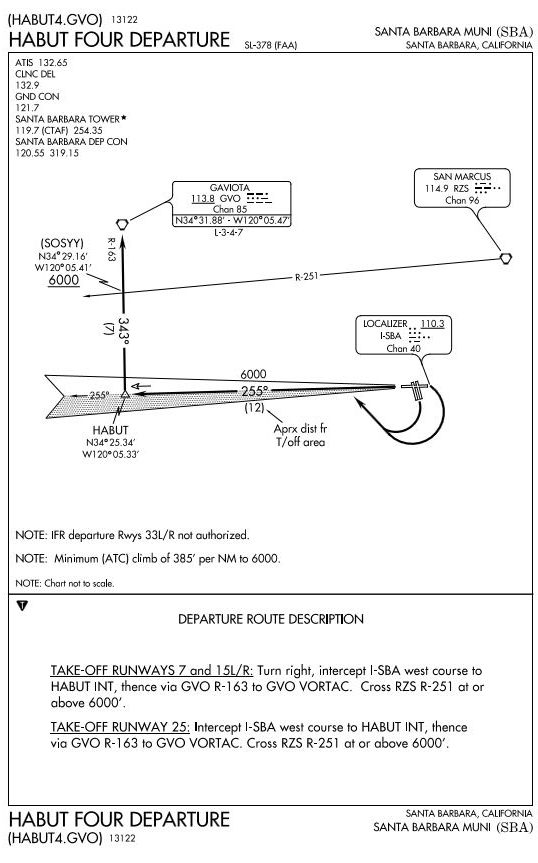 CorrectIncorrect
CorrectIncorrect -
Question 838 of 922
838. Question
Refer to figure 53 below. Where is the VOR COP on V27 between the GVO and MQO VORTACs?
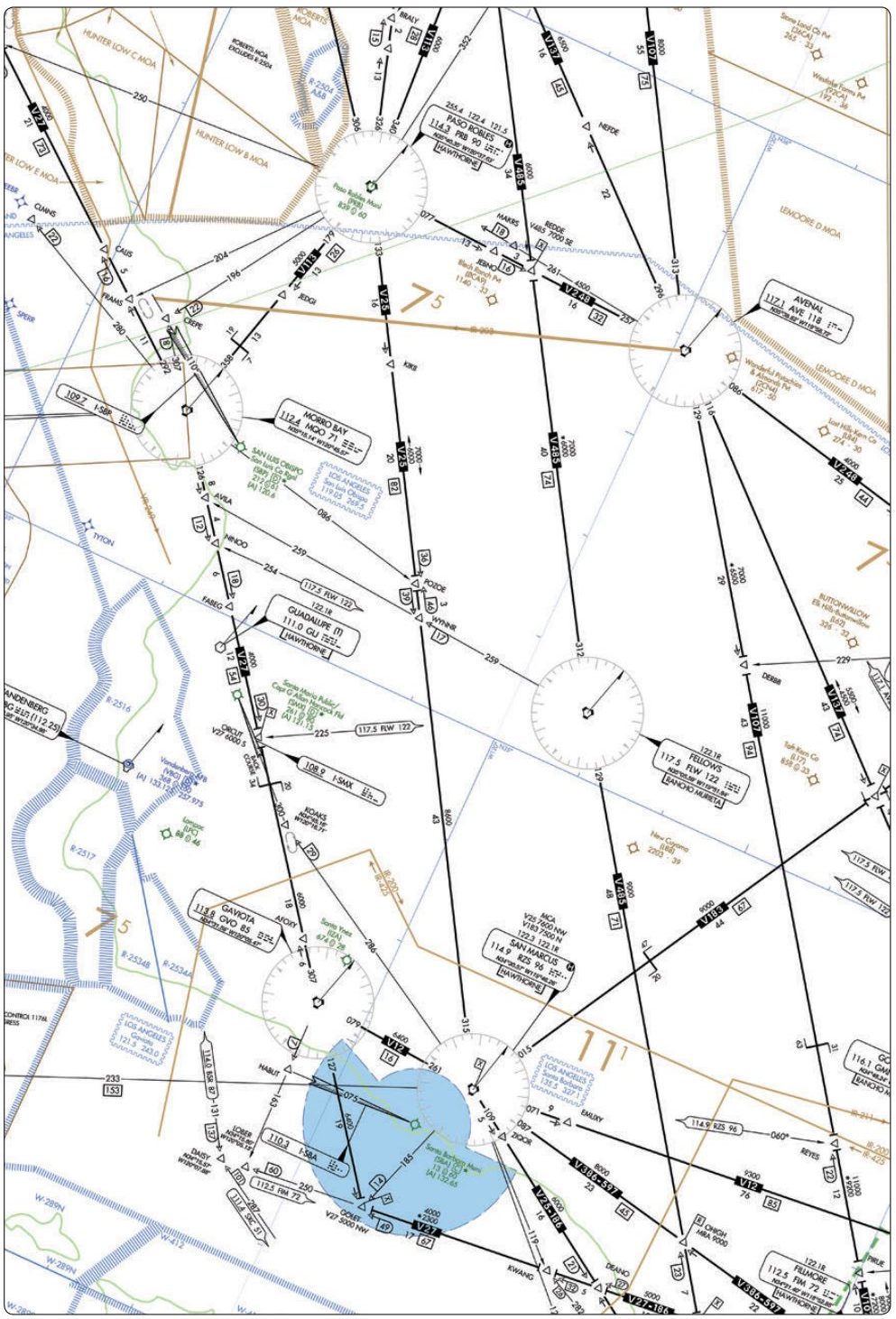 CorrectIncorrect
CorrectIncorrect -
Question 839 of 922
839. Question
Refer to figure 53 below. What is indicated by the inverse “H” symbol in the radio aids to navigation box for SAN MARCUS VORTAC?
 CorrectIncorrect
CorrectIncorrect -
Question 840 of 922
840. Question
Refer to figure 189 and legend 27 below. Using an average ground speed of
90 knots, what minimum rate of climb would meet the required minimum climb rate per NM as specified by the instrument departure procedure?

 CorrectIncorrect
CorrectIncorrect -
Question 841 of 922
841. Question
Refer to figure 192 below. Using an average ground speed of 90 knots, what constant rate of descent from 3,100 feet MSL at the 6 DME fix would enable the aircraft to arrive at 2,400 feet MSL at the FAF?
 CorrectIncorrect
CorrectIncorrect -
Question 842 of 922
842. Question
Refer to figure 34 below. For planning purposes, what is the highest usable altitude for an IFR flight on V573 from the HOT VORTAC to the TXK
VORTAC?
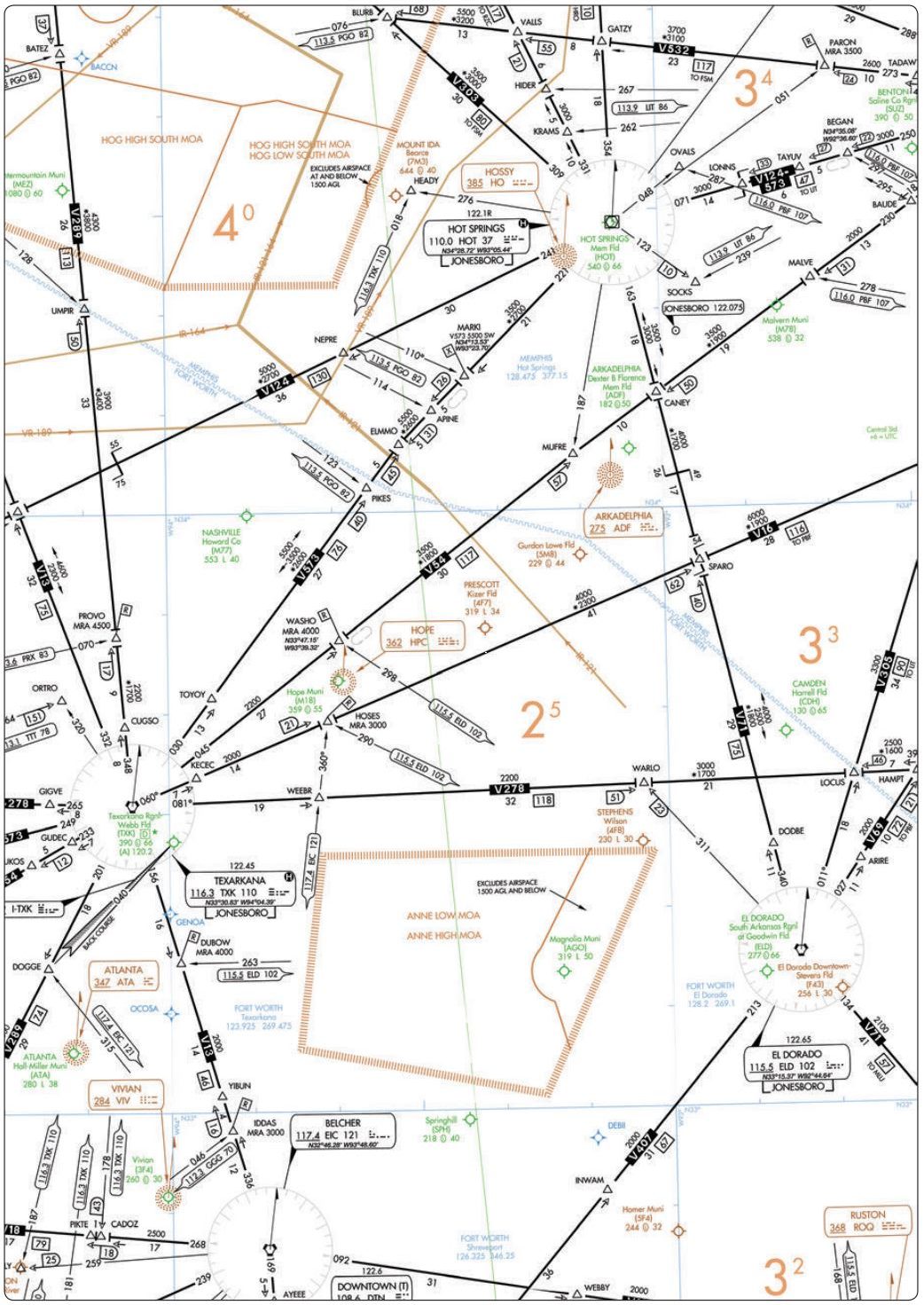

 CorrectIncorrect
CorrectIncorrect -
Question 843 of 922
843. Question
Refer to figure 167 and figure 168 below. At which point does the BYP.BYP6 arrival begin?
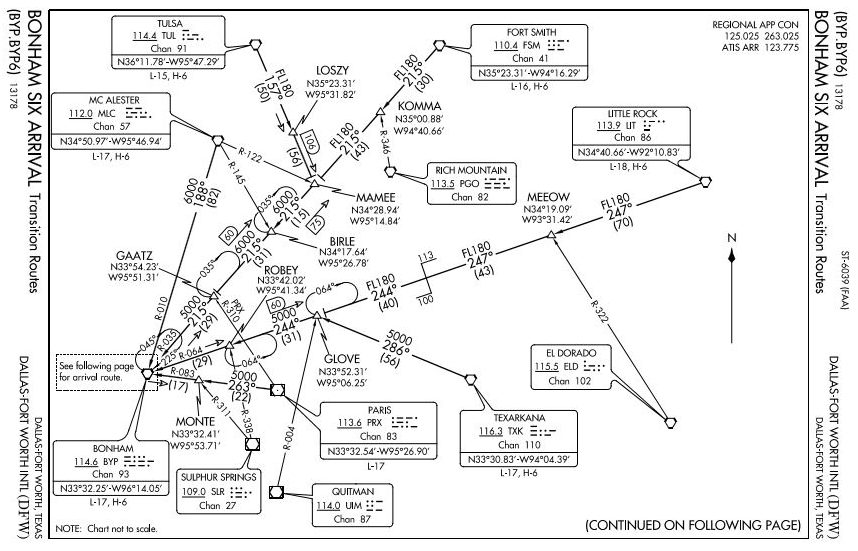
 CorrectIncorrect
CorrectIncorrect -
Question 844 of 922
844. Question
Refer to figure 171 below. Under which condition should the missed approach procedure for the RNAV(GPS) RWY 33 approach be initiated?
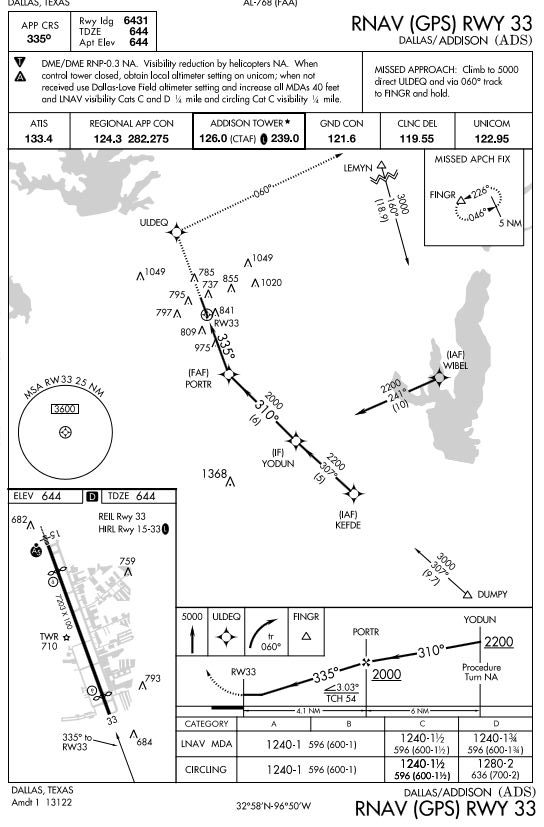 CorrectIncorrect
CorrectIncorrect -
Question 845 of 922
845. Question
Refer to figure 171 below. What is the MDA and visibility criteria respectively for the circling approach procedure?
 CorrectIncorrect
CorrectIncorrect -
Question 846 of 922
846. Question
Decode the excerpt from the Winds and Temperature Aloft Forecast (FB) for OKC at 39,000 feet.
FT 3000 9000 12000 24000 39000
OKC 9900 2018+00 2130-06 2361-30 830558
CorrectIncorrect -
Question 847 of 922
847. Question
A prognostic chart depicts the conditions
CorrectIncorrect -
Question 848 of 922
848. Question
Refer to figure 18 below. The U.S. Low-Level Significant Weather Prognostic Chart at 06Z indicates that central Colorado and southeastern Wyoming can expect



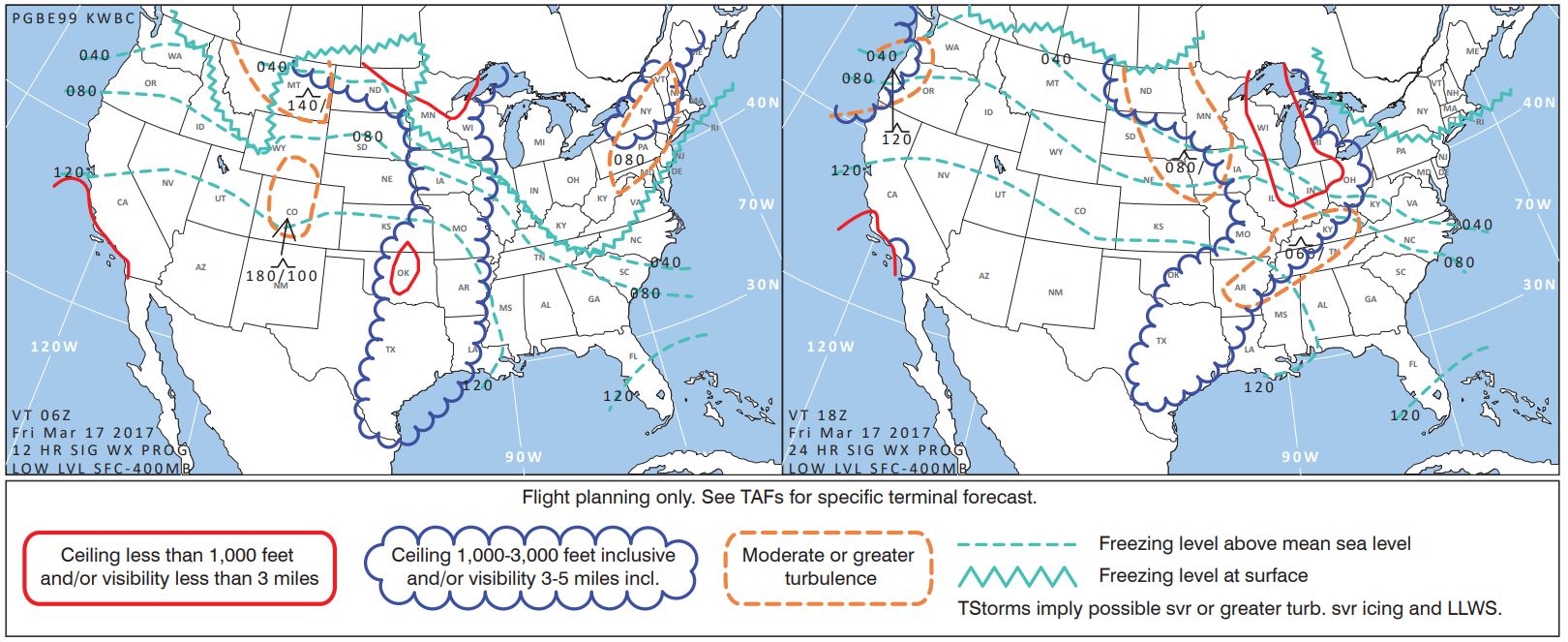

 CorrectIncorrect
CorrectIncorrect -
Question 849 of 922
849. Question
Refer to figure 19 below. The 24-Hour Low-Level Significant Weather Prognostic Chart at 06Z indicates that Ohio will likely experience

 CorrectIncorrect
CorrectIncorrect -
Question 850 of 922
850. Question
The Low-Level Significant Weather Prognostic Chart depicts weather conditions
CorrectIncorrect -
Question 851 of 922
851. Question
Which meteorological conditions are depicted by a prognostic chart?
CorrectIncorrect -
Question 852 of 922
852. Question
A pilot planning to depart at 1100Z on an IFR flight is particularly concerned about the hazard of icing. What sources reflect the most accurate information on icing conditions (current and forecast) at the time of departure?
CorrectIncorrect -
Question 853 of 922
853. Question
What determines how icing is reported on a PIREP?
CorrectIncorrect -
Question 854 of 922
854. Question
What conclusion(s) can be drawn from a 500-millibar Constant Pressure Chart for a planned flight at FL 180?
CorrectIncorrect -
Question 855 of 922
855. Question
Which weather forecast describes prospects for an area coverage of both severe and general thunderstorms during the following 24 hours?
CorrectIncorrect -
Question 856 of 922
856. Question
The Surface Analysis Chart depicts
CorrectIncorrect -
Question 857 of 922
857. Question
What information is provided by a Convective Outlook (AC)?
CorrectIncorrect -
Question 858 of 922
858. Question
What does a Convective Outlook (AC) describe for a following 24-hr. period?
CorrectIncorrect -
Question 859 of 922
859. Question
If you encounter in-flight icing and ATC asks you to report your conditions, what are the official reportable icing values that you are expected to use?
CorrectIncorrect -
Question 860 of 922
860. Question
When are severe weather watch bulletins (WW) issued?
CorrectIncorrect -
Question 861 of 922
861. Question
What flight planning information can a pilot derive from constant pressure charts?
CorrectIncorrect -
Question 862 of 922
862. Question
Refer to figure 20 below. What is the maximum wind velocity forecast in the jet stream shown on the High Level Significant Weather Prognostic Chart over Eastern Canada?
 CorrectIncorrect
CorrectIncorrect -
Question 863 of 922
863. Question
Refer to figure 20 below. What is the height of the center of the low tropopause height over eastern Canada?
 CorrectIncorrect
CorrectIncorrect -
Question 864 of 922
864. Question
Refer to figure 7 below. What weather conditions are predicted within area 3?
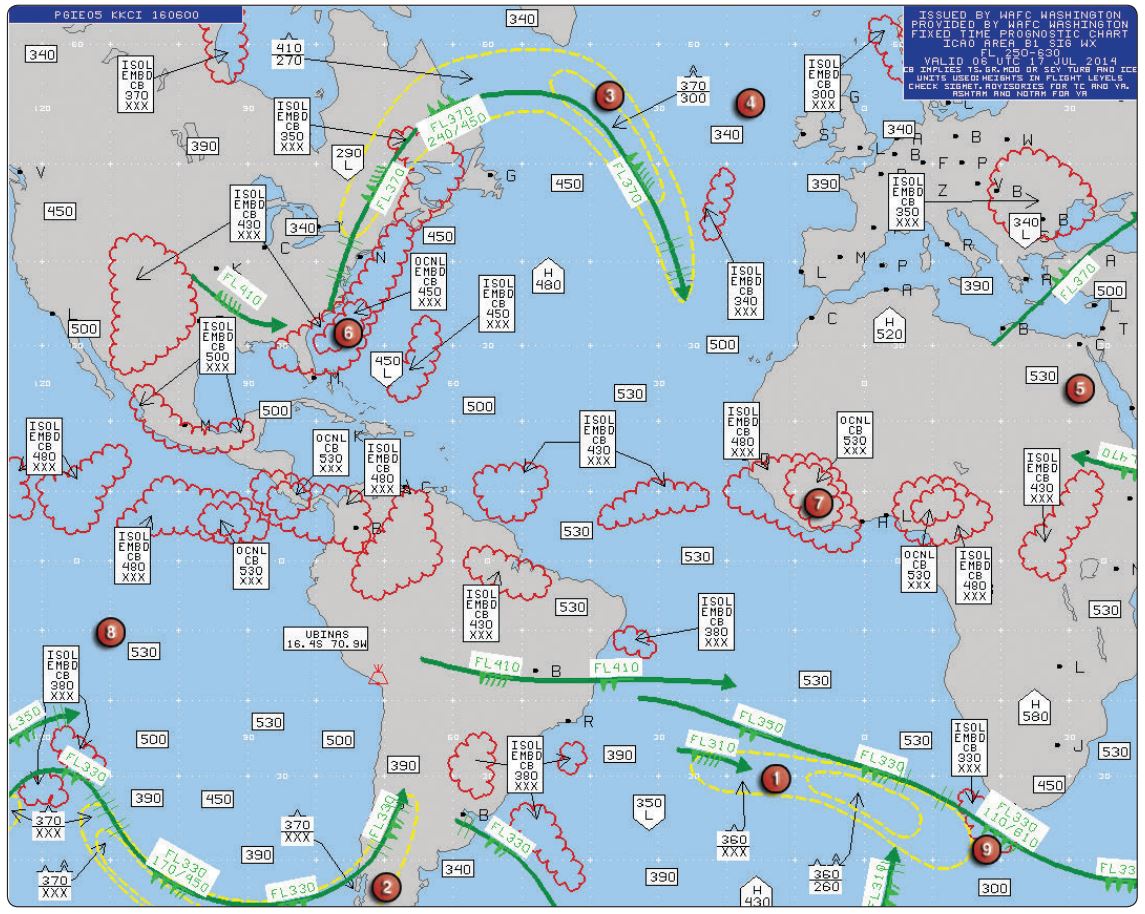 CorrectIncorrect
CorrectIncorrect -
Question 865 of 922
865. Question
Refer to figure 7 below. What weather conditions are depicted within area 7?
 CorrectIncorrect
CorrectIncorrect -
Question 866 of 922
866. Question
Refer to figure 7 below. The U.S. HIGH-LEVEL SIGNIFICANT WEATHER PROG, area 8, represents the
 CorrectIncorrect
CorrectIncorrect -
Question 867 of 922
867. Question
Refer to figure 7 below. What type of weather can be expected in the red scalloped area near area 9?
 CorrectIncorrect
CorrectIncorrect -
Question 868 of 922
868. Question
Refer to figure 175 and figure 174 below. When DFW is landing to the north, at CURLE expect

 CorrectIncorrect
CorrectIncorrect -
Question 869 of 922
869. Question
Refer to figure 40 below. For planning purposes, what is the highest usable altitude for an IFR flight on V16 from the BGS VORTAC to ABI VORTAC?
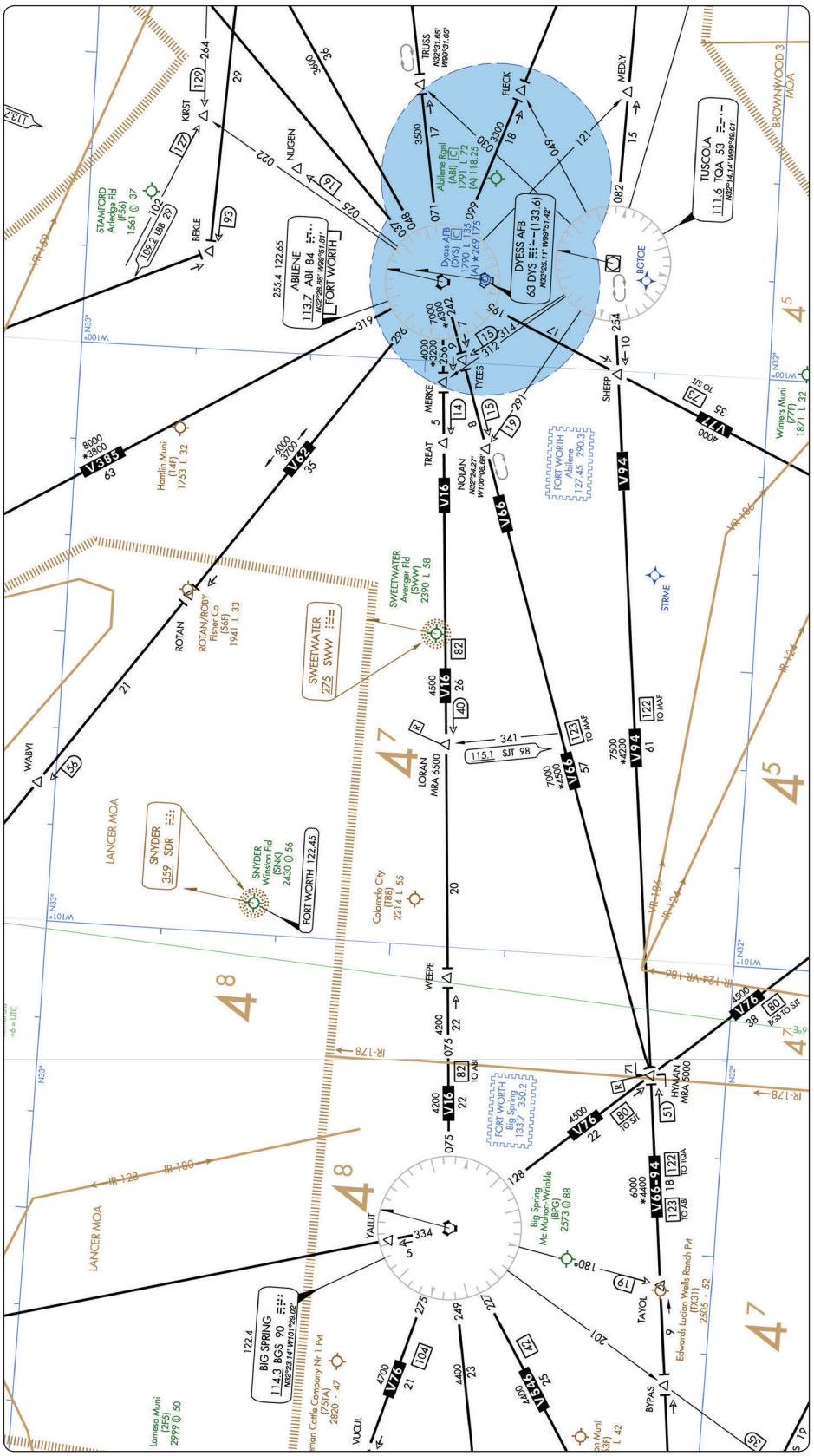 CorrectIncorrect
CorrectIncorrect -
Question 870 of 922
870. Question
Refer to figure 174 and figure 175 below. At which point does the JEN.JEN9 arrival begin?

 CorrectIncorrect
CorrectIncorrect -
Question 871 of 922
871. Question
Refer to figure 174 and figure 175 below. Which frequency would you anticipate using to contact Regional Approach Control? (GLEN ROSE NINE ARRIVAL).

 CorrectIncorrect
CorrectIncorrect -
Question 872 of 922
872. Question
Refer to figure 174 and figure 175 the diagrams below. On which heading should you plan to depart DELMO intersection?

 CorrectIncorrect
CorrectIncorrect -
Question 873 of 922
873. Question
Refer to figure 177 below. What is the difference in elevation (in feet MSL) between the airport elevation and the THRE for RWY 36L?
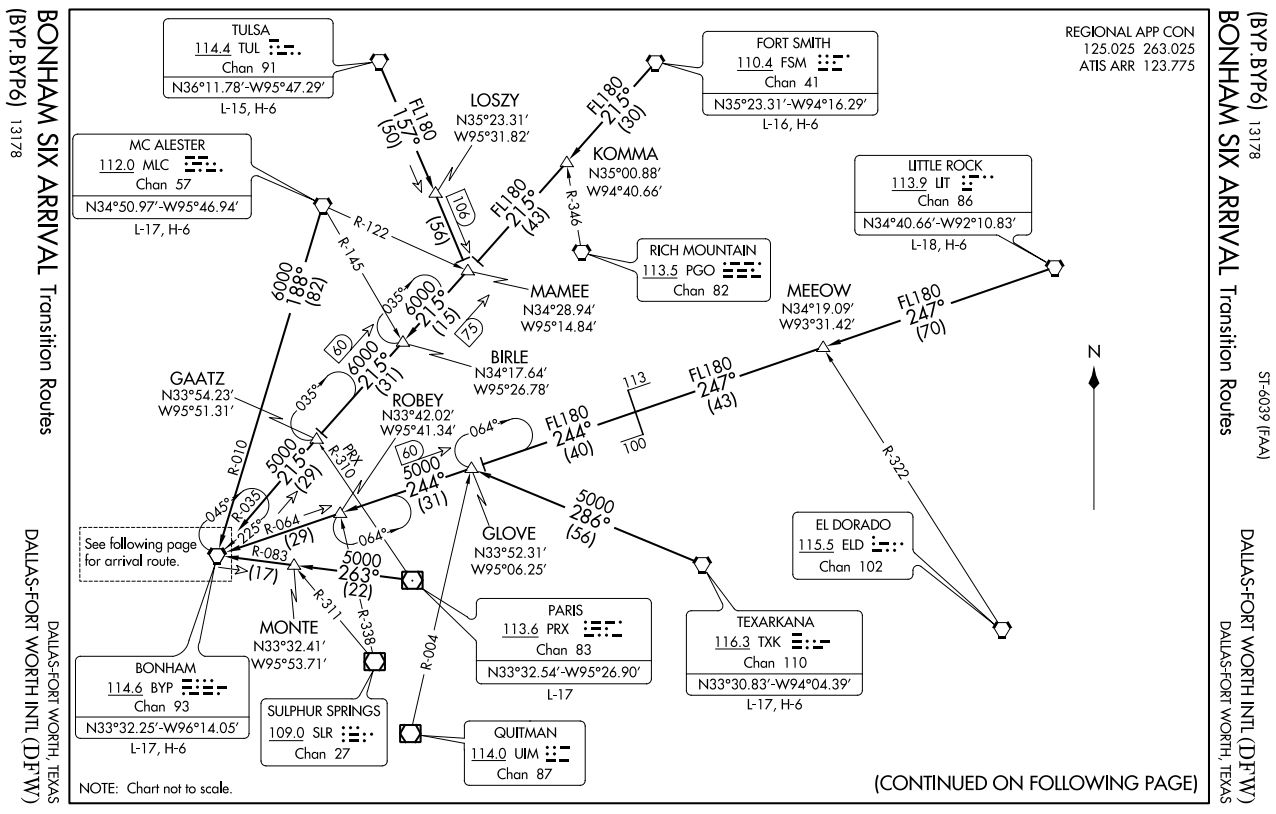 CorrectIncorrect
CorrectIncorrect -
Question 874 of 922
874. Question
Refer to figure 177 below. Which navigational information and services would be available to the pilot when using the localizer frequency?
 CorrectIncorrect
CorrectIncorrect -
Question 875 of 922
875. Question
Refer to figure 177 and legend 27 below. What rate of descent should you plan to use initially to establish the glidepath for the ILS RWY 36L approach? (Use 120 knots ground speed.)

 CorrectIncorrect
CorrectIncorrect -
Question 876 of 922
876. Question
Refer to figure 71A and figure 71 below. What is your position relative to the FLOSI intersection northbound on V213 airway?
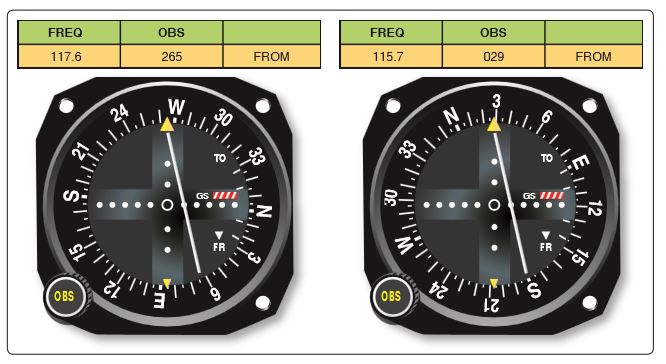
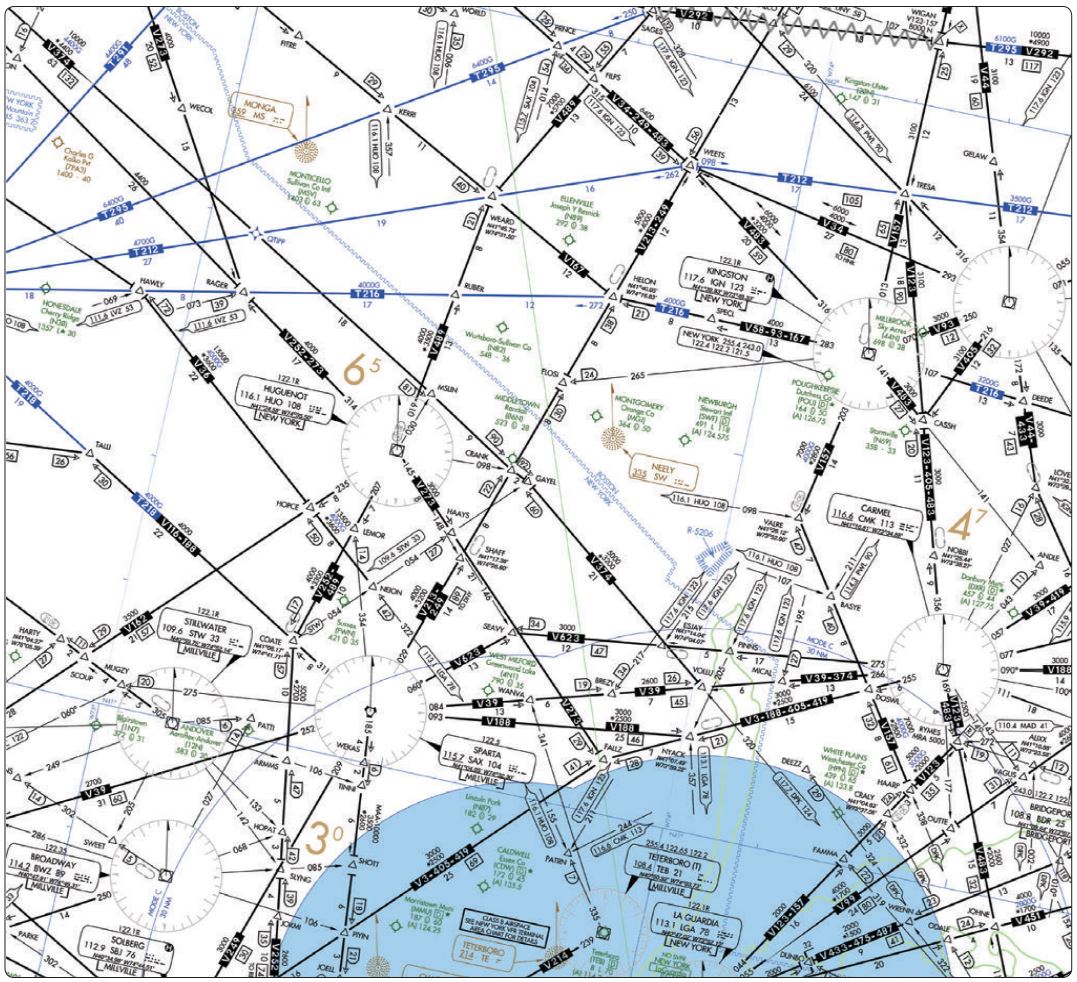 CorrectIncorrect
CorrectIncorrect -
Question 877 of 922
877. Question
Refer to figure 210 below. At which indication or occurrence should you initiate the published missed approach procedure for the ILS RWY 6 approach provided the runway environment is not in sight?
 CorrectIncorrect
CorrectIncorrect -
Question 878 of 922
878. Question
Refer to figure 210 below. What is the minimum altitude at which you should intercept the glide slope on the ILS RWY 6 approach procedure?
 CorrectIncorrect
CorrectIncorrect -
Question 879 of 922
879. Question
Refer to figure 210 below. What is the touchdown zone elevation for RWY 6?
 CorrectIncorrect
CorrectIncorrect -
Question 880 of 922
880. Question
Refer to figure 210 and legend 27 below. Using an average ground speed of 90 knots on the final approach segment, what rate of descent should be used initially to establish the glidepath for the ILS RWY 6 approach procedure?

 CorrectIncorrect
CorrectIncorrect -
Question 881 of 922
881. Question
Refer to figure 210 and figure 30 below. Which runway and landing environment lighting is available for approach and landing on RWY6 at Bradley International?

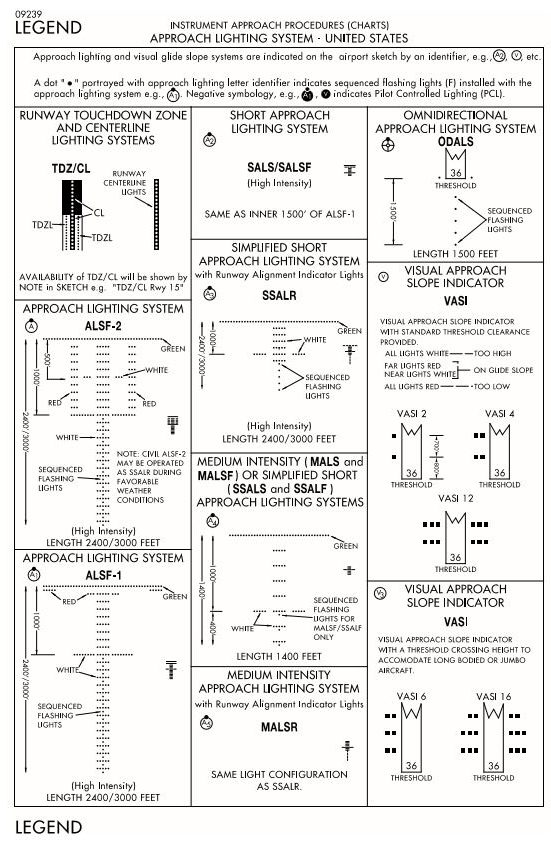 CorrectIncorrect
CorrectIncorrect -
Question 882 of 922
882. Question
Refer to figure 210 and egend 32l below. After passing the OM, Bradley Approach Control advises you that the MM on the ILS RWY 6 approach is inoperative . Under these circumstances, what adjustments, if any, are required to be made to the DH and visibility?

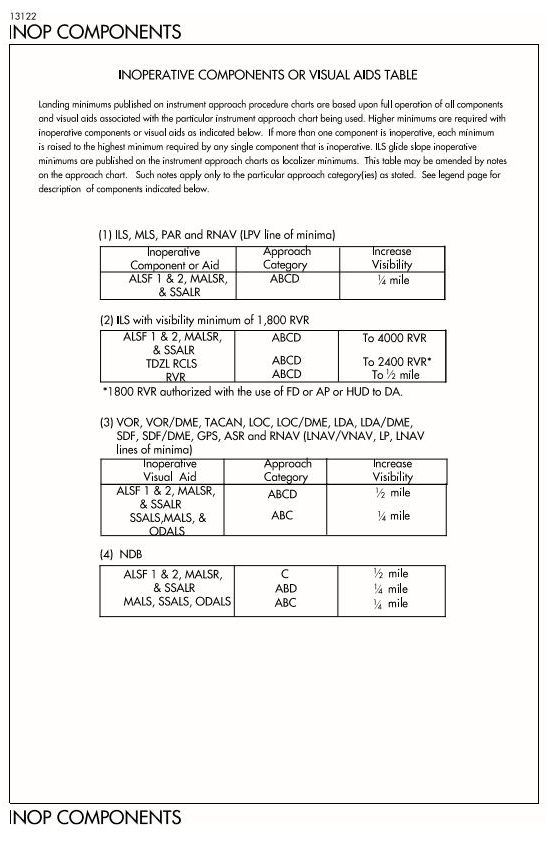 CorrectIncorrect
CorrectIncorrect -
Question 883 of 922
883. Question
Refer to figure 208 and figure 209 below. At which location or condition does the STELA.STELA1 arrival begin?

 CorrectIncorrect
CorrectIncorrect -
Question 884 of 922
884. Question
Refer to figure 76 and figure 211 and below. Which en route low altitude navigation chart would cover a proposed routing at the BOZEMAN VORTAC?
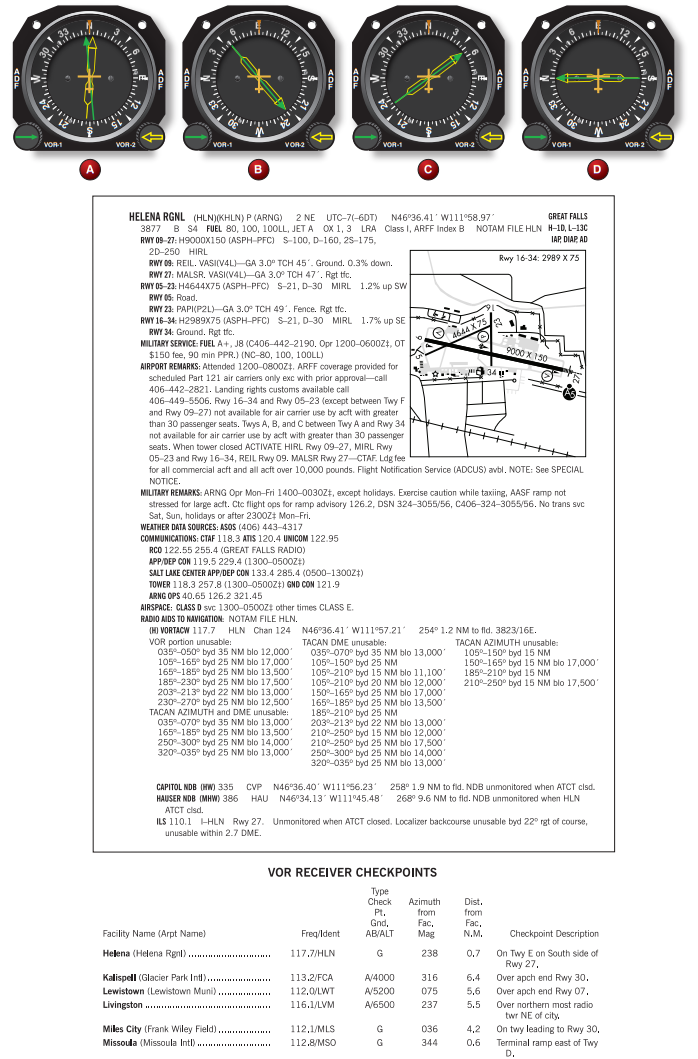

 CorrectIncorrect
CorrectIncorrect -
Question 885 of 922
885. Question
Refer to figure 211 below. Which en route low altitude navigation chart would cover a proposed routing at the BOZEMAN VORTAC?
 CorrectIncorrect
CorrectIncorrect -
Question 886 of 922
886. Question
Refer to figure 211 below. Using an average ground speed of 140 knots, what minimum rate of climb would meet the required minimum climb rate per NM as specified on the instrument departure procedure from RWY 9?
 CorrectIncorrect
CorrectIncorrect -
Question 887 of 922
887. Question
Refer to figure 78 below. When eastbound on V86 between Whitehall and Livingston, the minimum altitude that you should cross BZN is
 CorrectIncorrect
CorrectIncorrect -
Question 888 of 922
888. Question
Refer to figure 78 below. What is the maximum altitude that you may flight plan an IFR flight on V-86 EASTBOUND between BOZEMAN and BILLINGS VORTACs?
 CorrectIncorrect
CorrectIncorrect -
Question 889 of 922
889. Question
Refer to figure 78 below. What is the minimum crossing altitude over the BOZEMAN VORTAC for a flight southeast bound on V86?
 CorrectIncorrect
CorrectIncorrect -
Question 890 of 922
890. Question
Refer to figure 211 below. At which minimum altitude should you cross the STAKK intersection?
 CorrectIncorrect
CorrectIncorrect -
Question 891 of 922
891. Question
Refer to figure 213 below. Which aircraft approach category should be used for a circling approach for a landing on RWY 28R in an aircraft with a V50 of 72 kt.?
 CorrectIncorrect
CorrectIncorrect -
Question 892 of 922
892. Question
Refer to figure 213 below. How many initial approach fixes serve the VOR/DME RWY 28R (Billings Logan) approach procedure?
 CorrectIncorrect
CorrectIncorrect -
Question 893 of 922
893. Question
Refer to the diagrams below. What CAS must be used to maintain the filed TAS at the flight planned altitude if the outside air temperature is -5°C?
CorrectIncorrect -
Question 894 of 922
894. Question
Refer to the diagrams below. What aircraft equipment code should be entered in block 3 of the flight plan?
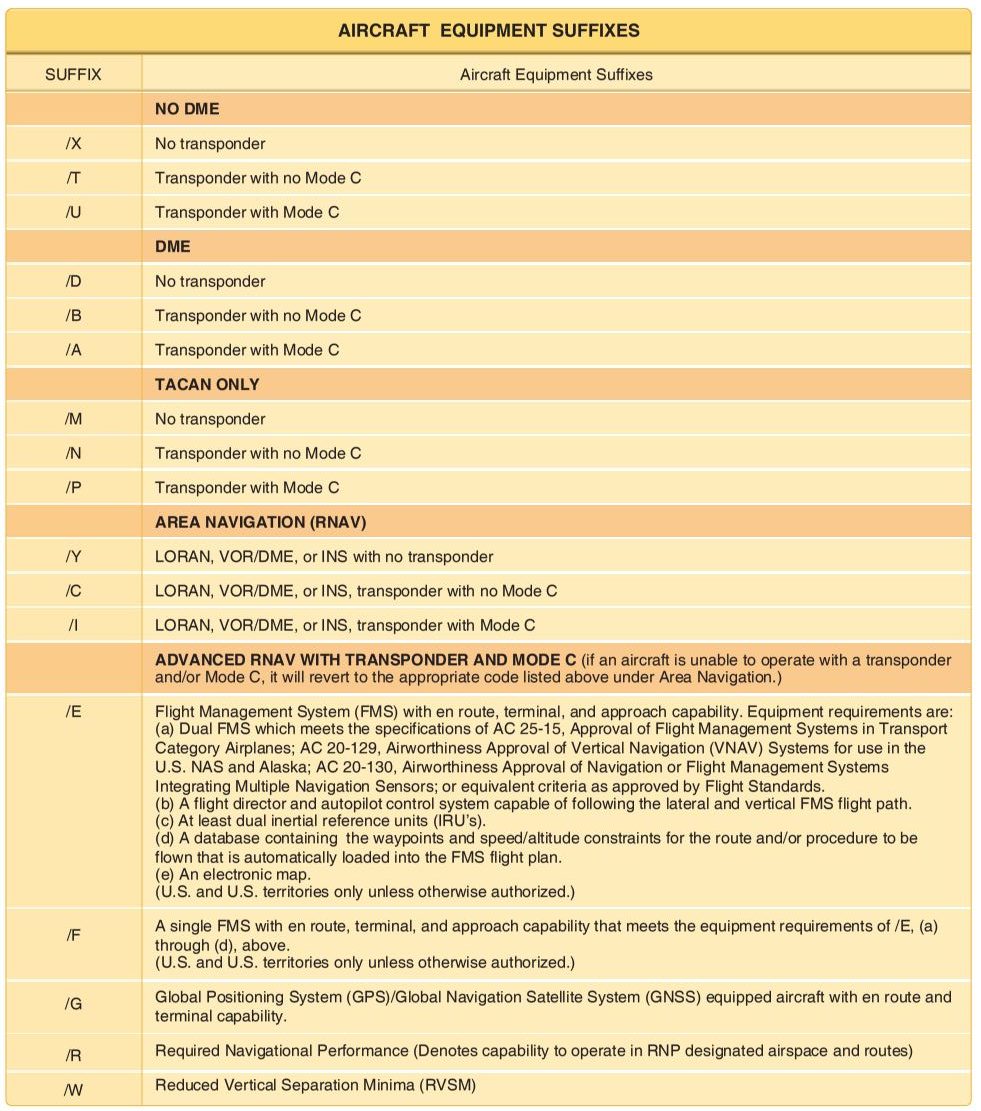 CorrectIncorrect
CorrectIncorrect -
Question 895 of 922
895. Question
Refer to the diagrams below. Using an average groundspeed of 120 knots, what minimum rate of climb must be maintained to meet the required climb rate (feet per NM) to 4,100 feet as specified on the instrument departure procedure?
CorrectIncorrect -
Question 896 of 922
896. Question
Refer to the diagrams below. Refer to the FB excerpt below and use the wind entry closest to the flight planned altitude. Determine the time to be entered in block 10 of the flight plan.
CorrectIncorrect -
Question 897 of 922
897. Question
Refer to the diagrams below. What aircraft equipment code should be entered in block 3 of the flight plan?
 CorrectIncorrect
CorrectIncorrect -
Question 898 of 922
898. Question
Refer to the diagram below. What CAS must be used to maintain the filed TAS at the flight planned altitude if the outside air temperature is +5 degrees C?
CorrectIncorrect -
Question 899 of 922
899. Question
Refer to the diagram below. What are the hours of operation (local time) of the ATIS for the Yakima Air Terminal when daylight savings time is in effect?
CorrectIncorrect -
Question 900 of 922
900. Question
Refer to the diagram below. With a ground speed of 120 knots, approximately what minimum rate of descent will be required between I-GPO 7 DME fix (ROBOT) and the I-GPO 4 DME fix?
CorrectIncorrect -
Question 901 of 922
901. Question
Refer to the diagram below. What is the usable runway length for landing on runway 21 at PDX?
CorrectIncorrect -
Question 902 of 922
902. Question
Refer to the diagram below. Using an average ground speed of 90 knots, what constant rate of descent from 2,400 feet MSL at the 6 DME fix would enable the aircraft to arrive at 2,000 feet MSL at the FAF?
CorrectIncorrect -
Question 903 of 922
903. Question
Refer to the diagrams below. What is your position relative to the CONNY intersection on the BUJ.BUJ3 transition?
CorrectIncorrect -
Question 904 of 922
904. Question
Refer to the diagram below. Under which condition should the missed approach procedure for the VOR/DME RNAV RWY 33 approach be initiated?
CorrectIncorrect -
Question 905 of 922
905. Question
Refer to the diagram below. What is the MDA and visibility criteria respectively for the S-33 approach procedure?
CorrectIncorrect -
Question 906 of 922
906. Question
Refer to the diagrams below. At which altitude and location on V573 would you expect the navigational signal of the HOT VOR/DME to be unreliable?
CorrectIncorrect -
Question 907 of 922
907. Question
Refer to he diagram below. What AS must be used to maintain the filed TAS at the flight planned altitude if the outside air temperature is +6 degrees C?
CorrectIncorrect -
Question 908 of 922
908. Question
Refer to the diagrams below. What aircraft equipment code should be entered in block 3 of the flight plan?
 CorrectIncorrect
CorrectIncorrect -
Question 909 of 922
909. Question
Refer to the diagrams below. What is the minimum number of waypoints required for the complete RNAV RWY 33 approach procedure including the IAF’s and missed approach procedure?
CorrectIncorrect -
Question 910 of 922
910. Question
Refer to the diagram below. What number should be placed in block 12?
CorrectIncorrect -
Question 911 of 922
911. Question
Refer to the diagram below. What aircraft equipment code should be entered in block 3 of the flight plan.
CorrectIncorrect -
Question 912 of 922
912. Question
Refer to the diagram below. What CAS must be used to maintain the filed TAS at the flight planned altitude if the outside air temperature is +05°C?
CorrectIncorrect -
Question 913 of 922
913. Question
Refer to the diagram below. What fuel should be entered into block 12 of the flight plan?
CorrectIncorrect -
Question 914 of 922
914. Question
Refer to the diagrams below. Approaching DFW from Abilene, which frequencies should you expect to use for regional approach control, control tower, and ground control respectively?
CorrectIncorrect -
Question 915 of 922
915. Question
Refer to the diagrams below. What aircraft equipment code should be entered in block 3 of the flight plan?
 CorrectIncorrect
CorrectIncorrect -
Question 916 of 922
916. Question
Refer to the diagram below. What CAS should be used to maintain the filed TAS if the outside air temperature is +05 degrees C?
CorrectIncorrect -
Question 917 of 922
917. Question
Refer to the diagrams below. Which VORTAC navigational faciity along the proposed route of flight could provide you with HWAS information?
CorrectIncorrect -
Question 918 of 922
918. Question
Refer to the diagram below. How many precision approach procedures are published for Bradley International Airport?
CorrectIncorrect -
Question 919 of 922
919. Question
Refer to the diagrams below. What aircraft equipment code should be entered in block 3 of the flight plan?
 CorrectIncorrect
CorrectIncorrect -
Question 920 of 922
920. Question
Refer to the diagram below. What CAS should be used to obtain the filed TAS at the flight planned altitude if the outside air temperature is +5 degrees C?
CorrectIncorrect -
Question 921 of 922
921. Question
Refer to the diagrm below What is the TDZE for landing on RWY 27R?
CorrectIncorrect -
Question 922 of 922
922. Question
Refer to the diagrams below. How many initial approach fixes serve the VOR/DME RWY 27R (Billings Logan) approach procedure?
CorrectIncorrect
